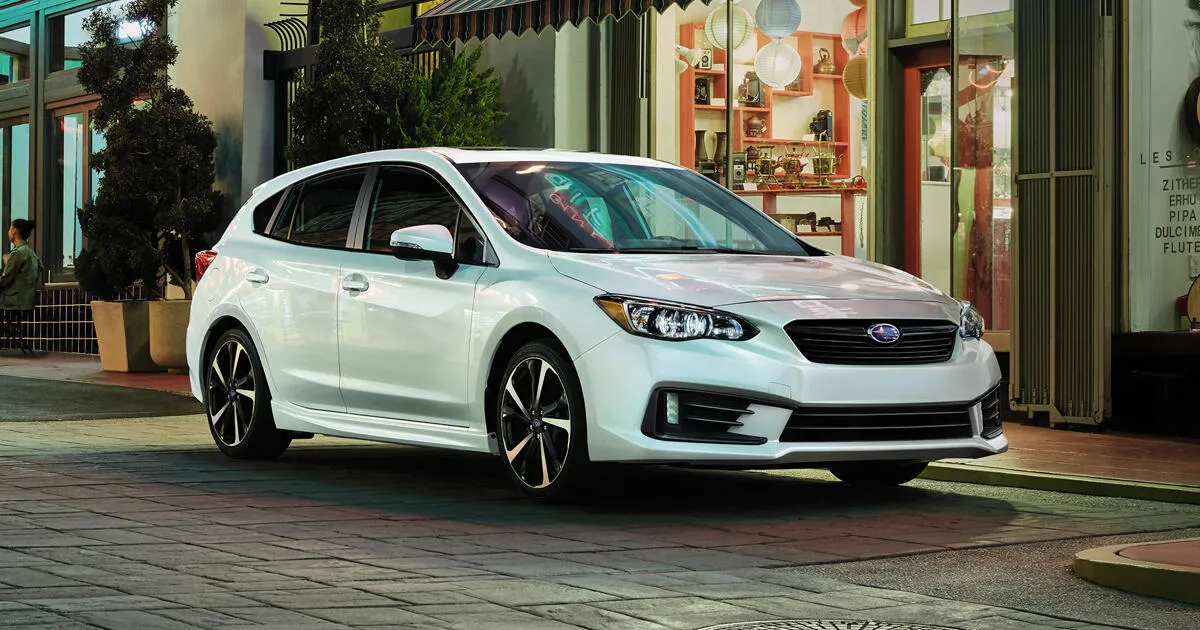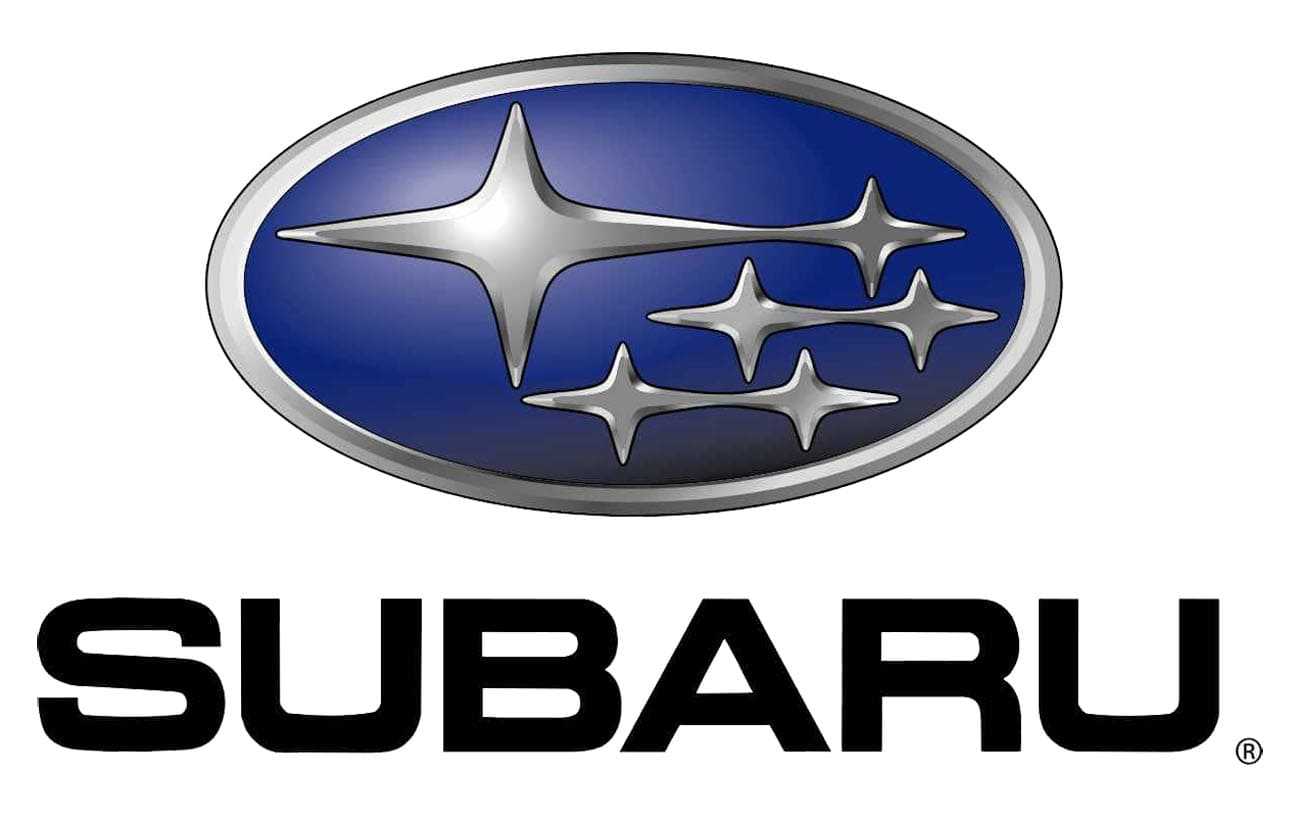
Subaru Impreza 2023 Base Sedan User Guide
The Subaru Impreza 2023 Base Sedan is a small car that is stable, useful, and good in all kinds of weather. The Impreza Base Sedan looks strong and athletic on the road thanks to its sleek and modern outer design. When you step inside, you’ll find a well-designed, comfortable place with plenty of room for people and their things. The Base Sedan trim has comfortable cloth seats and an easy-to-use layout in the cabin, putting usefulness and ease of use first. The Impreza Base Sedan has Subaru’s Symmetrical All-Wheel Drive system, which gives the car better grip and stability in different weather and road situations. This, along with its responsive 2.0-liter four-cylinder engine, makes it a good mix of low fuel use and good speed. The Impreza Base Sedan also comes with a number of high-tech safety features, like adaptive cruise control, lane departure warning, and pre-collision braking, so you can travel with peace of mind. The Base Sedan has a 6.5-inch touchscreen infotainment system that works with smartphones. This lets you stay connected and engaged on the go. Whether you’re driving to work in the city or going on a weekend trip, the Subaru Impreza 2023 Base Sedan is a sensible, reliable, and capable car. It’s a great choice for people who want a compact car that’s good at both speed and safety.
Subaru Impreza 2023 Seat Base Sedan User Guide
Seat
Safety tips for seat
WARNING
Never adjust the seat while driving, as personal injury or loss of vehicle control may occur.. Before adjusting the seat, ensure nothing is blocking the adjusting mechanism.
After adjusting the seat, move it back and forth to ensure the seat is securely locked. If it is not, it may move suddenly or the seatbelt may not operate properly.
Do not put objects under the front seats. They may interfere with the front seat locking mechanism and cause an accident.
- Seatbelts provide maximum restraint when the occupant sits back and upright in the seat. To reduce the risk of sliding under the seatbelt in a collision, the front seatbacks should always be used in the upright position while the vehicle is running. If the front seatbacks are not in the upright position and a collision occurs, the risk of sliding under the lap belt and of the lap belt sliding up over the abdomen will increase, and both can result in serious injury or death.
- The SRS airbags deploy with considerable speed and force. Occupants who are not sitting back and upright when the SRS airbag deploys could suffer serious injury. Because the SRS airbag needs enough space for deployment, the driver should always sit upright and well back in the seat as far from the steering wheel as practical while still maintaining full vehicle control, and the front passenger should move the seat as far back as possible and sit upright and well back in the seat.
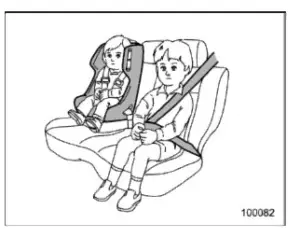
Place children in the rear seat properly restrained at all times. The SRS airbag deploys with considerable speed and force and can injure or even kill children, especially if they are not restrained or improperly restrained. Because children are lighter and weaker than adults, their risk of being injured from deployment is greater. For that reason, we strongly recommend that ALL children (including those in child seats and those that have outgrown child restraint devices) sit in the REAR seat properly restrained at all times in a child restraint system or in a seatbelt, whichever is appropriate for the child’s age, height and weight. Secure ALL types of child restraint devices (including forward-facing child restraint systems) in the REAR seats at all times. NEVER INSTALL A CHILD RESTRAINT SYSTEM IN THE FRONT PASSENGER’S SEAT. DOING SO RISKS SERIOUS INJURY OR DEATH TO THE CHILD BY PLACING THE CHILD’S HEAD TOO CLOSE TO THE SRS AIRBAG.
According to accident statistics, children are safer when properly restrained in the rear seating positions than in the front seating positions. For instructions and precautions concerning child restraint systems, refer to “Child restraint systems”�1 -25.
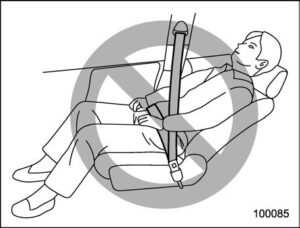
To prevent the passenger from sliding under the seatbelt in the event of a collision, always put the seatback in the upright position while the vehicle is in motion. Also, do not place objects such as cushions between the passenger and the seat-back. If you do so, the risk of sliding under the lap belt and of the lap belt sliding up over the abdomen will increase, and both can result in serious injury or death.

WARNING
Do not let rear passengers rest their feet between the front seatback and seat cushion. Doing so may interfere with the proper operation of the following systems and could result in serious injury.
- Occupant detection system
- SRS side airbag
- Seat heater (if equipped)
- Power seat (if equipped)

WARNING
Do not press your feet onto the instrument panel. Doing so may prevent the occupant detection function of the SRS airbag system from functioning correctly, and may result in serious injury or death in the event of an accident.
WARNING
Seatbelts provide maximum restraint when the occupant sits well back and upright in the seat. Do no put cushions or any other materials between occupants and seatbacks or seat cushions. If you do so, the risk of sliding under the lap belt and of the lap belt sliding up over the abdomen will increase, and both can result in serious internal injury or death.
Read all Instructions for Seat Base Sedan User Guide
Subaru Impreza 2023 Seatbelts Base Sedan User Guide
Seat Belts
Seatbelt safety tips
WARNING
- All persons in the vehicle should fasten their seatbelts BEFORE the vehicle starts to move. Otherwise, the possibility of serious injury becomes greater in the event of a sudden stop or accident.
- All belts should fit snugly in order to provide full restraint. Loose-fitting belts are not as effective in preventing or reducing injury.
- Each seatbelt is designed to support only one person. Never use a single belt for two or more persons – even children. Otherwise, in an accident, serious injury or death could result.
- Replace all seatbelt assemblies including retractors and attaching hardware worn by occupants of a vehicle that has been in a serious accident. The entire assembly should be replaced even if damage is not obvious.
- Never use a belt that is twisted or reversed. In an accident, this can increase the risk or severity of injury.
- Keep the lap belt as low as possible on your hips. In a collision, this spreads the force of the lap belt over stronger hip bones instead of across the weaker abdomen.
- Seatbelts provide maximum restraint when the occupant sits well back and upright in the seat. To reduce the risk of sliding under the seatbelt in a collision, the front seatbacks should be always used in the upright position while the vehicle is running. If the front seatbacks are not used in the upright position in a collision, the risk of sliding under the lap belt and of the lap belt sliding up over the abdomen will increase, and both can result in serious internal injury or death.
- Do not put cushions or any other materials between occupants and seatbacks or seat cushions. If you do so, the risk of sliding under the lap belt and of the lap belt sliding up over the abdomen will increase, and both can result in serious internal injury or death.
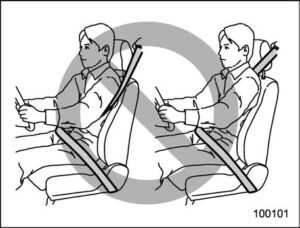
WARNING
Never place the shoulder belt under the arm or behind the back. If an accident occurs, this can increase the risk or severity of the injury.
CAUTION
Metallic parts of the seatbelt can become very hot in a vehicle that has been closed up in sunny weather; they could burn an occupant. Do not touch such hot parts until they cool.
Your vehicle is equipped with a crash sensing and diagnostic module, which will record the use of the seatbelt by the front passenger when any of the SRS frontal, side and curtain airbags deploy.
Infants or small children
Use a child restraint system that is suitable for your vehicle. Refer to “Child restraint systems” 1-25.
Children
WARNING
Place children in the rear seat properly restrained at all times. The SRS airbag deploys with considerable speed and force and can injure or even kill children, especially if they are not restrained or improperly restrained. Because children are lighter and weaker than adults, their risk of being injured from deployment is greater. For that reason, we strongly recommend that ALL children (including those in child restraint systems and those that have outgrown child restraint devices) sit in the REAR seat properly restrained at all times in a child restraint system or in a seatbelt, whichever is appropriate for the child’s height and weight.
Secure ALL types of child restraint devices (including forward facing child restraint systems) in the REAR seats at all times.
NEVER INSTALL A CHILD RE-STRAINT SYSTEM IN THE FRONT PASSENGER’S SEAT. DOING SO RISKS SERIOUS INJURY OR DEATH TO THE CHILD BY PLACING THE CHILD’S HEAD TOO CLOSE TO THE SRS AIRBAG.
According to accident statistics, children are safer when properly restrained in the rear seating positions than in the front seating positions. For instructions and precautions concerning the child restraint system, refer to “Child restraint systems”1-25.
If a child is too big for a child restraint system, the child should sit in the rear seat and be restrained using seatbelts. According to accident statistics, children are safer when properly restrained in the rear seating positions than in the front seating positions. Never allow a child to stand up or kneel on the seat.
If the shoulder portion of the belt crosses the face or neck, move the child closer to the belt buckle to help provide a good shoulder belt fit. Care must be taken to securely place the lap belt as low as possible on the hips and not on the child’s waist. If the shoulder portion of the belt cannot be properly positioned, a child restraint system should be used. Never place the shoulder belt under the child’s arm or behind the child’s back.
Expectant mothers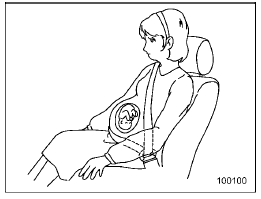
Expectant mothers also need to use seatbelts. They should consult their doctor for specific recommendations. The lap belt should be worn securely and as low as possible over the hips, not over the waist.
Emergency Locking Retractor (ELR)
The driver’s seatbelt has an Emergency Locking Retractor (ELR).
The emergency locking retractor allows normal body movement but the retractor locks automatically during a sudden stop, impact or if you pull the belt very quickly out of the retractor.
Automatic Locking Retractor/Emergency Locking Retractor (ALR/ELR)
Each passenger’s seatbelt has an Automatic Locking Retractor/Emergency Locking Retractor (ALR/ELR). The Automatic Locking Retractor/Emergency Locking Retractor normally functions as an Emergency Locking Retractor (ELR). The ALR/ELR has an additional locking mode “Automatic Locking Retractor (ALR) mode” intended to secure a child restraint system. When the seatbelt is once drawn out completely and is then retracted even slightly, the retractor locks the seatbelt in that position and the seatbelt cannot be extended. As the belt is rewinding, clicks will be heard which indicate the retractor functions as an ALR. When the seatbelt is retracted fully, the ALR mode is released.
When securing a child restraint system on the rear seats by the use of the seatbelt, the seatbelt must be changed over to the Automatic Locking Retractor (ALR) mode. When the child restraint system is removed, make sure that the seatbelt re-tracts fully and the retractor returned to the Emergency Locking Retractor (ELR) mode. For instructions on how to convert the retractor to the ALR mode and restore it to the ELR mode, refer to “Installing child restraint systems with ALR/ELR seatbelt”1-30.
Seatbelt warning light and chime
Refer to “Seatbelt warning light and chime” P�3-13.
Read all Instructions for Seatbelts Base Sedan User Guide
Subaru Impreza 2023 Seatbelt pretensioners Base Sedan User Guide
2023 Subaru Impreza Seatbelt pretensioners Base Sedan Guidelines
Seatbelt pretensioners
The following seatbelts have a seatbelt pre-tensioner.
- Driver’s seatbelt
- Front passenger’s seatbelt
- Rear passenger’s seatbelt (window-side)
The seatbelt pre-tensioners are designed to be activated in the event of an accident involving a moderate to severe frontal and side collision and rollover accident.
WARNING
- To obtain maximum protection, the occupants should sit in an upright position with their seatbelts properly fastened. Refer to “Seatbelts”1-12.
- Do not modify, remove or strike the seatbelt retractor assemblies equipped with seatbelt pre-tensioners or the surrounding area. This could result in accidental activation of the seatbelt pre-tensioners or could make the system inoperative, possibly resulting in serious injury. Seatbelt pretensioners have no user-serviceable parts. For required servicing of seatbelt retractors equipped with seatbelt pre-tensioners, consult your SUBARU dealer.
- When discarding seatbelt retractor assemblies equipped with seatbelt pretensioners or scrapping the entire vehicle due to collision damage or for other reasons, consult your SUBARU dealer.
NOTE
- Seatbelt pretensioners are not designed to activate in minor impacts or in rear impacts.
- Pretensioners are designed to function on a one-time-only basis. In the event that a pretensioner is activated, both the driver’s and front passenger’s seatbelt retractor assemblies should be replaced only by an authorized SUBARU dealer. When replacing seatbelt retractor assemblies, use only genuine SUBARU parts.
- If a seatbelt that has a seatbelt pretensioner does not retract or cannot be pulled out due to a mal-function or activation of the pretensioner, contact your SUBARU dealer as soon as possible.
- If the seatbelt retractor assembly or surrounding area has been damaged, contact your SUBARU dealer as soon as possible.
- When you sell your vehicle, we urge you to inform the buyer that the vehicle is equipped with seatbelt pretensioners. Also, notify the buyer of the contents in this section.
Driver’s seatbelt
The driver’s seatbelt has a shoulder belt pretensioner.
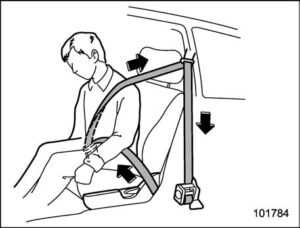
Front seatbelt pretensioner
The pretensioner sensor also serves as follows.
- SRS frontal airbag sensor
- Side impact sensor
- Front door impact sensor
- Rollover sensor
If the sensor detects a certain predetermined amount of force during frontal or side collisions or rollover accidents, any seatbelt that has a seatbelt pre-tensioner is quickly drawn back in by the retractor to take up the slack so that the belt more effectively restrains the seat occupant.
The driver’s seatbelt pre-tensioner includes a tension-reducing device that limits the peak forces exerted by the seatbelt on the occupant in the event of a collision.
When a seatbelt pre-tensioner is activated, an operating noise will be heard and a small amount of smoke will be released. These occurrences are normal and not harmful. This smoke does not indicate a fire in the vehicle.
Once the seatbelt pre-tensioner has been activated, the seatbelt retractor remains locked. Consequently, the seatbelt cannot be pulled out and retracted and therefore must be replaced.
In cases of a rollover accident, frontal collisions or side collisions, the following components will operate simultaneously. For details, refer to “In cases of a rollover accident, frontal collisions or side collisions, the following components will operate simultaneously” 1-23.
Front passenger’s seatbelt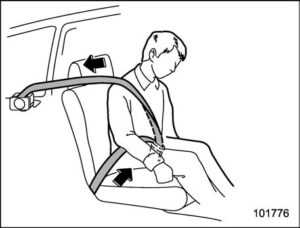
- Seatbelt retractor assembly (shoulder belt pre-tensioner and adaptive force limiter)
- Lap belt pretensioner
On the front passenger’s side, the shoulder belt pre-tensioner is supplemented by a lap belt pre-tensioner, which is located at the base of the center pillar. Like the shoulder belt pre-tensioner, the lap belt pretensioner instantaneously pulls in the belt to eliminate slack if a certain level of frontal collision force is detected. As a result, the seatbelt restrains the front seat occupant more effectively.
The front passenger’s seatbelt pre-tensioner includes a tension-reducing device that limits the peak forces exerted by the seatbelt on the occupant in the event of a collision. The adaptive force limiter will select a reducing load to the suit body size of the occupant as detected by the occupant detection sensor.
When a seatbelt pre-tensioner is activated, an operating noise will be heard and a small amount of smoke will be released. These occurrences are normal and not harmful. This smoke does not indicate a fire in the vehicle.
Once the seatbelt pre-tensioner has been activated, the seatbelt pre-tensioner remains locked. Consequently, the seatbelt cannot be pulled out and retracted and therefore must be replaced.
A diagnostic system continually monitors the readiness of the seatbelt pre-tensioner with the ignition switch in the “ON” position. The seatbelt pre-tensioners share the control module with the SRS airbag system. Therefore, if any malfunction occurs in a seatbelt pretensioner, the SRS airbag system warning light will illuminate. For details, refer to “SRS airbag system monitors” P104.
Read all Instructions for Seatbelt pre-tensioners Base Sedan User Guide
Subaru Impreza 2023 Installing child restraint Base Sedan User Guide
Installing child restraint systems with ALR/ELR seatbelts
CAUTION
- When you install a child restraint system, follow the manufacturer’s instructions supplied with it. After installing the child restraint system, check to ensure that it is held securely in position. If it is not held tight and secure, the danger of your child suffering personal injury in the event of an accident may be increased.
- When installing a child restraint system in the rear center seating position, set both seatbacks to the original position. Otherwise, the child restraint system cannot be securely restrained, which may result in death or serious injuries in the event of a sudden stop, sudden steering maneuver or an accident.
Installing a rearward-facing child restraint system
WARNING
- NEVER INSTALL A CHILD RESTRAINT SYSTEM IN THE FRONT PASSENGER’S SEAT. DOING SO RISKS SERIOUS INJURY OR DEATH TO THE CHILD BY PLACING THE CHILD’S HEAD TOO CLOSE TO THE SRS AIRBAG.
- Before installing a child restraint system, be sure to confirm that the seatback is securely locked into place. Otherwise, in an accident, serious injury or death could result.
- Place the child restraint system in the rear seating position.
WARNING
When you intend to install a child restraint system in the rear center seating position, if the child restraint system does not fit snugly against the contours of the rear center seat cushion, install the child restraint system in the window side seating position to be safe. For details, refer to “Where to place a child restraint system” P63.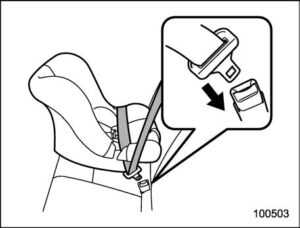
- Run the lap and shoulder belt through or around the child restraint system following the instructions provided by its manufacturer.
- Insert the tongue plate into the buckle until you hear a click.

- Take up the slack in the lap belt.
- If using the seatbelt in the ALR mode is recommended by the manufacturer’s instructions supplied with the child restraint system, perform the following procedure.
- Pull out the seatbelt fully from the retractor to change the retractor over from the Emergency Locking Retractor (ELR) to the Automatic Locking Retractor (ALR) mode.
- Allow the belt to rewind into the retractor. As the belt is rewinding, clicks will be heard which indicate the retractor functions as ALR.
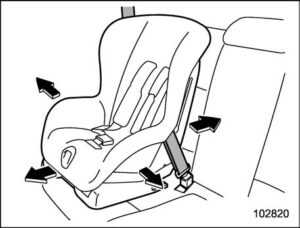
- Before having a child sit in the child restraint system, try to move it back and forth and right and left to check if it is firmly secured. Sometimes a child restraint system can be more firmly secured by pushing it down into the seat cushion and then tightening the seatbelt. It should not be possible to move the child restraint system more than 1 in (2.5 cm) in any direction along the seatbelt path.
- If the seatbelt has been set to the ALR mode in step 5, pull at the shoulder portion of the belt to confirm that it cannot be pulled out (ALR properly functioning).

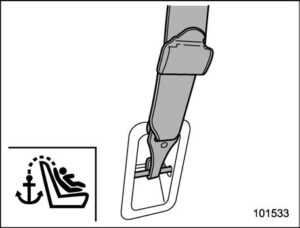

- To remove the child restraint system, press the release button on the seat-belt buckle and allow the belt to retract completely. The belt will return to the ELR mode.
NOTE
When the child restraint system is no longer in use, remove it and restore the ELR function of the retractor. That function is restored by allowing the seatbelt to retract fully.
Installing a forward-facing child restraint system
WARNING
- NEVER INSTALL A CHILD RESTRAINT SYSTEM IN THE FRONT PASSENGER’S SEAT. DOING SO RISKS SERIOUS INJURY OR DEATH TO THE CHILD BY PLACING THE CHILD’S HEAD TOO CLOSE TO THE SRS AIRBAG.
- Before installing a child restraint system, be sure to confirm that the seatback is securely locked into place. Otherwise, in an accident, serious injury or death could result.
- Place the child restraint system in the rear seating position. For models with rear seat reclining mechanisms, if there is a gap between the child restraint system and the seatback, adjust the seatback angle until good contact is achieved.
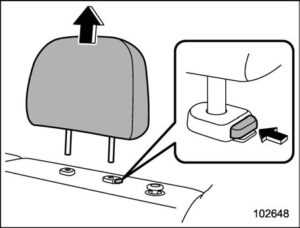
- Remove the head restraint of the rear seating position where the child restraint system is to be installed. For details, refer to “Head restraints”
P43.
CAUTION
Store the head restraint in the cargo area. Do not place the head restraint in the passenger compartment to prevent it from being thrown around in the passenger compartment at a sudden stop or a sharp turn.
WARNING
When you intend to install a child restraint system on the rear center seating position, if the child restraint system does not fit snugly against the contours of the rear center seat cushion, install the child restraint system on the window-side seating position to be safe. For details, refer to “Where to place a child restraint system” P63.
- Run the lap and shoulder belt through or around the child restraint system following the instructions provided by its manufacturer.
- When a child restraint system is installed on the rear center seating position, pass the rear center seat-belt through the belt guide properly. For details, refer to “Rear center seatbelt” P53.
- Insert the tongue plate into the buckle until you hear a click.
- Take up the slack in the lap belt.
- Pull out the seatbelt fully from the retractor to change the retractor over from the Emergency Locking Retractor (ELR) to the Automatic Locking Re-tractor (ALR) function. Then, allow the belt to rewind into the retractor. As the belt is rewinding, clicks will be heard which indicate the retractor functions as ALR.
- Before having a child sit in the child restraint system, try to move it back and forth and right and left to check if it is firmly secured. Sometimes a child restraint system can be more firmly secured by pushing it down into the seat cushion and then tightening the seatbelt. It should not be possible to move the child restraint system more than 1 in (2.5 cm) in any direction along the seatbelt path.
- Pull at the shoulder portion of the belt to confirm that it cannot be pulled out (ALR properly functioning).
- Latch the top tether hook onto the tether anchorage that is located behind the rear seat and tighten the top tether firmly. For additional instructions, refer to “Top tether anchorages” P75.
Read all Instructions for Installing child restraint Base Sedan User Guide
Subaru Impreza 2023 SUBARU advanced frontal airbag Base Sedan User Guide
2023 Subaru Impreza SUBARU frontal airbag Base Sedan Guidelines
SUBARU advanced frontal airbag system
Your vehicle is equipped with a SUBARU advanced frontal airbag system that com-plies with the new advanced frontal airbag requirements in the amended Federal Motor Vehicle Safety Standard (FMVSS) No. 208.
The SUBARU advanced frontal airbag system automatically determines the deployment force of the driver’s SRS frontal airbag at the time of deployment as well as whether or not to activate the front passenger’s SRS frontal airbag and, if activated, the deployment force of the SRS frontal airbag at the time of deployment.
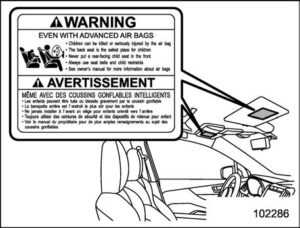
Your vehicle has warning labels on the driver’s and front passenger’s sun visors beginning with the phrase “EVEN WITH ADVANCED AIR BAGS” and a tag attached to the glove box lid beginning with the phrase “Even with Advanced Air Bags”. Make sure that you carefully read the instructions on the warning labels and tag.
Always wear your seatbelt. The SUBARU advanced frontal airbag system is a supplemental restraint system and must be used in combination with a seatbelt. All occupants should wear a seatbelt or be seated in an appropriate child restraint system. For the locations of the SRS airbags, refer to “Components” 1-51. In a moderate to severe frontal collision, the following components deploy.
- SRS frontal airbag for driver
- SRS frontal airbag for front passenger. SRS knee airbag for driver
- SRS curtain airbag*1
- When an offset frontal collision that is severe enough to deploy the front airbag occurs.
These components supplement the seatbelts by reducing the impact to the occupant’s head, chest and knees.
Driver’s SRS frontal airbag
The driver’s SRS frontal airbag uses a dual-stage inflator. The inflator operates in different ways depending on the severity of the impact.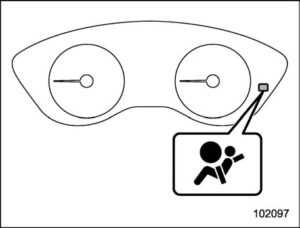
SRS airbag system warning light
Have the system inspected by your SUBARU dealer immediately if the SRS airbag system warning light illuminates.
NOTE
The driver’s SRS side airbag and SRS curtain airbag are not controlled by the SUBARU advanced frontal airbag system. Front passenger’s SRS frontal airbag The front passenger’s SRS frontal airbag uses a dual-stage inflator. The inflator operates in different ways depending on the severity of impact.
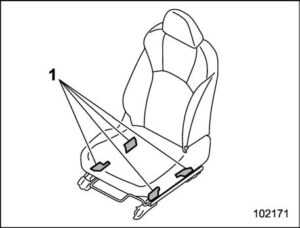
Occupant detection system sensors
The occupant detection system sensors are installed between the seat and seat rails, and monitor the physique and posture of the front passenger. Using this information, the occupant detection system determines whether the front passenger’s SRS frontal airbag should be deployed or not.
WARNING
Do not kick the front passenger seat or subject it to severe impact. Otherwise, the SRS airbag system warning light may illuminate to indicate a Seat, seatbelt and SRS airbags/SRS airbag (Supplemental Restraint System airbag) 1-55 malfunction of the front passenger occupant detection system. In this case, contact your SUBARU dealer immediately.
WARNING
Do not kick the front passenger seat or subject it to severe impact. Otherwise, the SRS airbag system warning light may illuminate to indicate a
Seat, seatbelt and SRS airbags/SRS airbag (Supplemental Restraint System airbag) 1-55 malfunction of the front passenger occupant detection system. In this case, contact your SUBARU dealer immediately.
CAUTION
Electronic devices* may affect the occupant detection system, especially under either of the following conditions.
- When placed on the front passenger’s seat while connected to the accessory power outlet
- When used by the front passenger
*Example: cell phones, laptops, portable music players, or electronic games. If either of the following situations occurs when using an electronic device in the vehicle, at first try to relocate that device to avoid it creating any interference.
- The SRS airbag system warning light illuminates.
- The front passenger’s frontal airbag ON and OFF indicators operate erratically.
If the interference remains, stop using the device in the vehicle.
The occupant detection system may not inflate the front passenger’s SRS frontal airbag even when the driver’s SRS frontal airbag deploys. This is normal. In this case, although the front passenger’s SRS
frontal airbag does not operate, the front passenger’s seatbelt pre tensioner operates with the driver’s seatbelt pre-tensioner. For details about the seatbelt pretensioner, refer to “Seatbelt pretensioners” �P57.
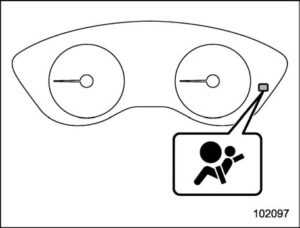
SRS airbag system warning light
If the seatbelt buckle switch and/or front passenger’s occupant detection system have failed, the SRS airbag system warning light will illuminate. Have the system inspected by your SUBARU dealer immediately if the SRS airbag system warning light illuminates. If your vehicle has sustained impact, this may affect the proper function of the SUBARU advanced frontal airbag system. Have your vehicle inspected at your SUBARU dealer. Do not use the front passenger’s seat while driving the vehicle to your SUBARU dealer.
NOTE
The front passenger’s SRS side airbag and SRS curtain airbag are not controlled by the SUBARU advanced frontal airbag system.
Passenger’s frontal airbag ON and OFF indicators

Read all Instructions for SUBARU advanced frontal airbag Base Sedan User Guide
Subaru Impreza 2023 SRS side,curtain airbag Base Sedan User Guide
SRS side airbag and SRS curtain airbag
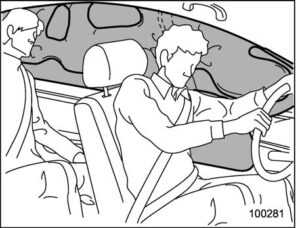
SRS side airbag
The SRS side airbag is stored in the door side of each front seat seatback, which bears an “SRS AIRBAG” label. In a moderate to severe side impact collision, the SRS side airbag on the impacted side of the vehicle deploys between the occupant and the door panel and supplements the seatbelt by reducing the impact on the occupant’s chest and waist. The SRS side airbag operates only for front seat occupants.
SRS curtain airbag
Your vehicle is equipped with a SUBARU SRS curtain airbag system that complies with the Federal Motor Vehicle Safety Standard (FMVSS) No. 226.
The SRS curtain airbag on each side of the cabin is stored in the roof side (between the front pillar and a point over the rear seat). An “SRS AIRBAG” mark is located at the top of each center pillar.
In a moderate to severe side impact collision, the SRS curtain airbag on the impacted side of the vehicle deploys between the occupant and the side window and supplements the seatbelt by reducing the impact on the occupant’s head.
In a rollover, SRS curtain airbags on both sides of the vehicle deploy between the occupant and the side window and supplement the seatbelt by reducing the impact to the occupant’s head. In an offset frontal collision, SRS curtain airbags on both sides of the vehicle deploy between the occupant and the side window and supplement the seatbelt by reducing the impact to the occupant’s head and chest.
Operation
The SRS side airbag and SRS curtain airbag can function only when the ignition switch is in the “ON” position. The following airbags deploy independently of each other since each has its own impact sensor.
- Driver’s SRS side airbag
- Front passenger’s SRS side airbag . SRS curtain airbag (right-hand side) . SRS curtain airbag (left-hand side)
- Therefore, they may not both deploy in the same accident. Also, the SRS side airbag and SRS curtain airbag deploys independently of the driver’s and front passenger’s SRS frontal airbags in the steering wheel and instrument panel. For the locations of the sensors and control modules, refer to “Components”
After deployment
After the deployment, the SRS side airbag immediately starts to deflate. The time required from detection of an impact to deflation of an SRS side airbag after deployment is shorter than the blink of an eye. The SRS curtain airbag remains inflated for a while following deployment then slowly deflates.
The SRS side airbag and SRS curtain airbag deploy even when no one occupies the seat on the side on which an impact is applied.
When the SRS side airbag and SRS curtain airbag deploy, a sudden, fairly loud inflation noise will be heard and some smoke will be released. These occurrences are a normal result of the deployment. This smoke does not indicate a fire in the vehicle.
CAUTION
Do not touch the SRS side airbag system components around the front seat seatback with bare hands right after deployment. Doing so can cause burns because the components can be very hot as a result of deployment. After deployment, do not touch any part of the SRS curtain airbag system (from the front pillar to the part of the roof side over the rear seat). Doing so can cause burns because the components can be very hot as a result of deployment.
Example of the type of accident
The SRS side airbag and SRS curtain airbag are designed as follows:
- To deploy in the event of an accident involving a moderate to severe side impact collision
- To function on a one-time-only basis The SRS side airbag and SRS curtain airbag are not designed to deploy in the following cases:
- In most lesser side impacts
- In most frontal or most rear impacts
(because the SRS side airbag and SRS curtain airbag deployment would not protect the occupant in those situations)
The SRS curtain airbags are also de-signed to deploy when the vehicle is in an extremely inclined state such as during a rollover. They are not designed to deploy in most lesser inclined state. SRS side airbag and SRS curtain airbag deployment depend on the level of force experienced in the passenger compartment during a side impact collision. That level differs from one type of collision to another, and it may have no bearing on the visible damage done to the vehicle itself.
Example of the type of accident in which the SRS side airbag will most likely deploy A severe side impact near the front seat
A severe side impact near the front seat
Examples of the types of accidents in which the SRS curtain airbag will most likely deploy
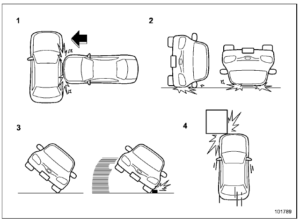
- The vehicle is involved in a severe side impact near the front seat or the rear seat.
- The vehicle rolls onto its side or the roof.
- The angle of vehicle tip-up is marginal or the skidding vehicle’s tires hit a curbstone laterally.
- An offset frontal collision that is severe enough to deploy the front airbag.
Examples of the types of accidents in which it is possible that the SRS side airbag and the SRS curtain airbag will deploy

- Hitting a curb, edge of pavement or hard surface
- Falling into or jumping over a deep hole 3 Landing hard or vehicle falling .It is possible that the SRS side and curtain airbags will deploy if a serious impact occurs to the underside of your vehicle. Some examples are shown in the illustration.
Examples of the types of accidents in which the SRS side airbag is unlikely to deploy
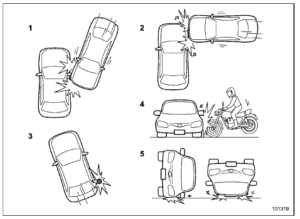
- The vehicle is involved in an oblique side on impact.
- The vehicle is involved in a side-on impact in an area outside the vicinity of the passenger compartment.
- The vehicle strikes a telephone pole or similar object.
- The vehicle is involved in a side-on impact with a motorcycle.
- The vehicle rolls onto its side or the roof.
There are many types of collisions that might not necessarily require SRS side airbag deployment. In the event of accidents like those illustrated, the SRS side airbag may not deploy depending on the level of accident forces involved.
Read all Instructions for SRS side,curtain airbag Base Sedan User Guide
Subaru 2023 Top Accessories
[amalinkspro_table id=”32446″ new-window=”on” nofollow=”on” addtocart=”off” /]
Subaru Impreza 2023 Keys Base Sedan User Guide
Keys
NOTE
For models with “keyless access with push-button start system”, refer to “Keyless access with push-button start system” �2-3.The following keys are provided with the vehicle.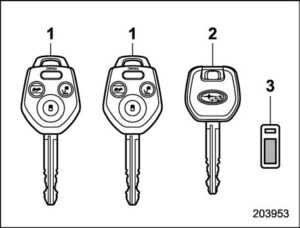
- Master keys
- Sub key
- Key number plat
- A key can be used in the following locations.
- Ignition switch
- Driver’s door
- Glove box
NOTE
Locking/unlocking using the remote keyless entry system can also be controlled with the buttons on the key. For detailed information, refer to “Remote keyless entry system” �2-19.
CAUTION
Do not attach a large key holder or key case to either key. If it bangs against your knees while you are driving, it could turn the ignition switch from the “ON” position to the “ACC” or “LOCK” position, thereby stopping the engine.
Key number plate
The key number is stamped on the key number plate attached to the key set. Write down the key number and keep it in another safe place, not in the vehicle. This number is needed to make a replacement key if you lose your key or lock it inside the vehicle. Refer to “Key replacement” 2-18.
Keyless access with a pushbutton start system (if equipped)
The following access key fobs are provided with the vehicle.
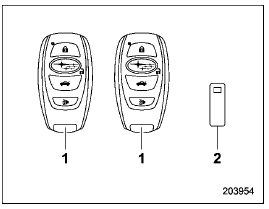
- Access key fobs
- Key number plate
The keyless access with a push-button start system allows you to perform the following functions when you are carrying the access key fob.
- Locking and unlocking of the doors and rear gate (5-door models)
- Refer to “Locking and unlocking by holding the access
key fob” �2-7.. Opening the trunk (sedan). Refer to “Locking and unlocking by holding the access key fob” 2-7. - Starting and stopping the engine. For detailed information, refer to “Starting and stopping the engine (models with push-button start system)” 7-12.
- Arming and disarming the alarm system. For detailed information, refer to “Alarm system” 2-27.
NOTE
- Locking/unlocking using the remote keyless entry system can also be controlled with the buttons on the access key fob. For detailed information, refer to “Remote keyless entry system” 2-19.
- Carefully store the key number plate supplied with the access key fob. It is necessary for vehicle repair and additional registration of access key fobs. For details, refer to “Key replacement”
An emergency key is attached to each access key fob.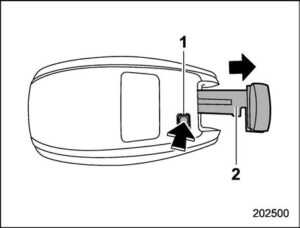
- Release button
- Emergency key
While pressing the release button of the access key fob, take out the emergency key. The emergency key is used for the following operations. Locking and unlocking the driver’s door. Locking and unlocking the glove box
NOTE
- The glove box can be kept locked when you leave your vehicle and the access key fob (with the emergency key removed) at a parking facility.
Safety precautions
If you wear an implanted pacemaker or an implanted defibrillator, stay at least 8.7 in (22 cm) away from the transmitting antennas installed on the vehicle. The radio waves from the transmitting antennas on the vehicle could adversely affect the operation of implanted pacemakers and implanted defibrillators.
- If you wear electronic medical equipment other than an implanted pacemaker or an implanted defibrillator, before using the keyless access with push-button start system, refer to “Radio waves used for the key-less access with push-button start system” mentioned later, and contact the electronic medical equipment manufacturer for more information. The radio waves from the transmitting antennas on the vehicle could adversely affect the operation of the electronic medical equipment. “Radio waves used for the keyless access with push-button start system”
- The keyless access with a push-button start system uses radio waves of the following frequency* in addition to the radio waves used for the remote keyless entry system. The radio waves are periodically output from the antennas installed on the vehicle as shown in the following illustrations. * Radio frequency: 134 kHz
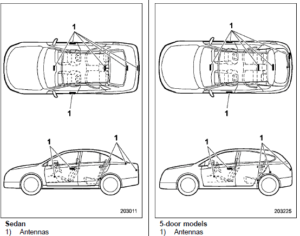
Read all Instructions for Keys Base Sedan User Guide
Subaru Impreza 2023 Unlock Using PIN Code Base Sedan User Guide
Unlock using PIN Code Access
When all doors including the rear gate (5-door models) are locked, you can unlock the doors (including rear gate) without a key by performing the following procedure.
- Sedan: Press the trunk opener button
- 5-door models: Press the rear lock button
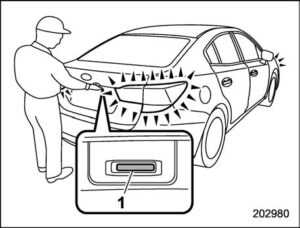
Trunk opener button (sedan)

NOTE
PIN Code Access will be helpful if the key fob is accidentally left in the vehicle. It is recommended that a 5-digit security code (PIN code) be registered.
Preparation for registering a PIN code
- Turn off the ignition switch.
- Close all doors (including trunk/rear gate).
- Press and hold the “ ” button on the access key fob. Then all doors (including rear gate) will be locked.
- Keep the “ ” button pressed, and press the trunk opener button (sedan)/rear lock button (5-door models) within 5 seconds after step 3
- Press and hold the trunk opener button (sedan)/rear lock button (5-door models) for more than 5 seconds. Confirm a chirp sound.
- Release the “ ” button and trunk opener button (sedan)/rear lock button (5-door models).
- Press the “ ” button on the access key fob while the chirp sounds. Then the chirp will stop and the preparation is complete.
NOTE
Press the button within 30 seconds of step 6 to end the preparation mode and move on to the registration stage. Unless the “ ” button is pressed within 30 seconds after step 6, the PIN code registration will be canceled.
Registration for a PIN code
For example, to register “32468” as the PIN code, perform the following procedure
- Press the trunk opener button (sedan)/rear lock button (5-door models) three times.
- After a chirp sounds once, press the trunk opener button (sedan)/rear lock button (5-door models) twice.
- After a chirp sounds once, press the trunk opener button (sedan)/rear lock button (5-door models) four times.
- After a chirp (ding) sounds once, press the trunk opener button (sedan)/rear lock button (5-door models) six times.
- After a chirp (ding) sounds once, press the trunk opener button (sedan)/rear lock button (5-door models) eight times.
- Perform steps 1 to 5 again within approximately 30 seconds after the chirp starts sounding intermittently.
- All doors will be unlocked and locked. Then the PIN code will be registered.
NOTE
- Press the trunk opener button (sedan)/rear lock button (5-door models) ten times to enter “0”.
- Change the PIN code frequently to protect your vehicle from theft.
- If you have lent your vehicle to another person, confirm that the PIN code has not been changed or deleted. If the PIN code has been changed or deleted, reregister a new PIN code.
- If you make an error during the registration procedure, press the “ ” or “ ” button on the access key fob. Then, start over from the procedure scribed in “Preparation for registering a PIN code”.
- To protect your vehicle from theft, you cannot register a string of the same five numbers together, such as “00000”, nor “12345” as a PIN code. . Do not register your vehicle license plate number or simple numbers such as “11122” or “12121” as a PIN code. Doing so will increase the risk of vehicle theft.
- When you try to register “22222”, the registered PIN code will be deleted. You cannot unlock the doors by PIN Code Access until a new code is registered. . After registering a new PIN code, make sure that you can unlock the doors using the PIN code.
- The PIN code cannot be deleted while the keyless access function is disabled by operating the access key fob.
- Reregister the PIN code in the following case.
- When you forget the PIN code
- When you want to change the PIN code
Unlocking
Perform steps 1 to 5 described in “Registration for a PIN code”.
NOTE
- You cannot unlock by PIN Code Access in the following cases.
- When the access key fob is within the operating ranges
- When the ignition switch is in the
“ACC” or “ON” position - If you make an operation error during the unlocking procedure, start over with the unlocking procedure after waiting for 5 seconds or longer.
- To protect your vehicle from theft, a buzzer will sound if incorrect PIN codes are entered five times continuously. If this occurs, you cannot unlock the doors by PIN Code Access for 5 minutes.
Read all Instructions for Unlock Using PIN Code Base Sedan User Guide
Subaru Impreza 2023 Remote keyless entry Base Sedan User Guide
Remote keyless entry system
CAUTION
- Do not expose the remote transmitter to severe shocks, such as those experienced as a result of dropping or throwing.
- Do not take the remote transmitter apart except when replacing the battery.
- Do not get the remote transmitter wet. If it gets wet, wipe it dry with a cloth immediately.
- When traveling in an airplane, do not press the button of the remote transmitter. If any button of the remote transmitter is pressed, radio waves are emitted and may affect the operation of the airplane. When carrying the remote transmitter in a bag, take measures to prevent the buttons from being pressed accidentally.

Access key fob
- Lock/arm button
- Unlock/disarm button
- Trunk lid opener/rear gate unlock button
- PANIC button

Transmitter
- Lock/arm button
- Unlock/disarm button
- Trunk lid opener/rear gate unlock button
- PANIC button
The remote keyless entry system has the following functions.
- Locking and unlocking the doors (and rear gate for 5-door models)
- Unlocking the trunk lid (sedan) or rear gate (5-door models)
- Sounding a panic alarm
- Arming and disarming the alarm system. For detailed information, refer to “Alarm system”2-27.
The operable distance of the remote keyless entry system is approximately 30 feet (10 meters). However, this distance will vary depending on environmental conditions. The system’s operable distance will be shorter in areas near a facility or electronic equipment emitting strong radio waves such as a power plant, broadcast station, TV tower, or remote controller of home electronic appliances.
NOTE
- For models with “keyless access with push-button start system”, the remote keyless entry system will not be activated when the push-button ignition switch is in any position other than the “OFF” position.
- For models without “keyless access with push-button start system”, the remote keyless entry system will not be activated when the key is inserted in the ignition switch.
- The hazard warning flashers will flash once or twice when the access key fob/transmitter button is pressed in the following cases.
- When locking the doors
- When unlocking the doors
- When opening the trunk lid (sedan)
- When unlocking the rear gate (5-door models)
- Operation of the hazard warning flashers in the above cases can be set to “On” or “Off” by a SUBARU dealer. Consult your SUBARU dealer for details.
- The setting of the remote trunk lid opener function can be set to “Pressing and holding” “Pressing twice” or “Non-operation” by a SUBARU dealer. Consult your SUBARU dealer for details (sedan).
Locking the doors
Press the lock/arm button to lock all doors and the rear gate (5-door models). An electronic chirp will sound once and the hazard warning flashers will flash once.
If any of the doors (or the rear gate/trunk lid) is not fully closed, the following will occur to alert you that the doors (or the rear gate/trunk lid) are not properly closed.
- An electronic chirp sounds five times. . The hazard warning flashers flash five times.
When you close the door, it will automatically lock and then the following will occur. . An electronic chirp sounds once. - The hazard warning flashers flash once.
Unlocking the doors
Press the unlock/disarm button to unlock the driver’s door. An electronic chirp will sound twice and the hazard warning flashers will flash twice. To unlock all doors including the rear gate (5-door models), briefly press the unlock/disarm button a second time within 5 seconds.
NOTE
If the interval between the first and second presses of the unlock/disarm button (for unlocking of all doors including the rear gate (5-door models)) is extremely short, the system may not respond.
Opening the trunk lid (sedan)
Press and hold the trunk lid opener button to open the trunk lid. An electronic chirp will sound twice and the hazard warning flashers will flash twice.
Unlocking the rear gate (5-door models)
Press the rear gate to unlock button to unlock the rear gate.
An electronic chirp will sound twice and the hazard warning flashers will flash twice.
Vehicle finder function
Use this function to find your vehicle parked among many vehicles in a large parking lot. Provided you are within 30 feet (10 meters) of the vehicle, pressing the lock/arm button three times in a 5-second period will cause your vehicle’s horn to sound once and its hazard warning flashers to flash three times.
Read all Instructions for Remote keyless entry Base Sedan User Guide
Subaru Impreza 2023 Door locks Base Sedan User Guide
Door locks
Locking and unlocking from the outside
NOTE
If you unlock the driver’s door with a key (including an emergency key) and open the door while the alarm system is armed, the alarm system is triggered and the vehicle’s horn sounds. In this case, perform any of the following operations:
- Models with “keyless access with push-button start system”:
- Press any button on the access key fob (except when the access key fob battery is discharged).
- Press the push-button ignition switch to “ACC”.
- Carry the access key fob and perform either of the following procedures.
- Grip the front door handle.
- Press the rear gate opener button.
- Models without “keyless access with push-button start system”:
- Press any button on the remote transmitter (except when the transmitter battery is discharged).
- Insert the key into the ignition switch and turn the ignition switch to “ON”.
For details about the alarm system, refer to “Alarm system” P136.
How to lock and unlock the vehicle using the key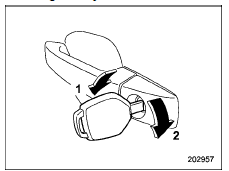
- Rotate the key toward the front to lock
- Rotate the key toward the rear to unlock.
In this case, only the driver’s side door is locked or unlocked.
NOTE
Models with “keyless access with push-button start system”:
The emergency key is directional. If the key cannot be inserted, change the direction that the grooved side is facing and insert it again.
How to lock the vehicle without using the key
To lock the door from outside without the key, the following methods are available.
Locking using lock lever
- Rotate the lock lever forward.
- Close the door.
In this way, only the door that was operated will be locked.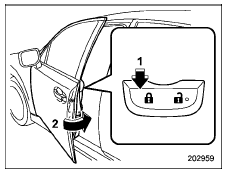
- Press the lock side of the power door Nocking switch.*
- Close the door.
For details about the power door locking switch, refer to “How to operate the power door locking switches” P134.
In this case, all closed doors, the rear gate, and the fuel filler lid are locked at the same time.
NOTE
Make sure that you do not leave the key inside the vehicle when locking the doors from the outside without the key.
Locking using a power door locking switch
How to use the lock lever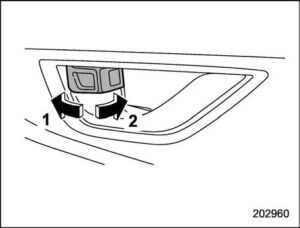
- Rotate the lock lever rearward to unlock
- Rotate the lock lever forward to the lock.
Always make sure that all doors and the rear gate are closed before starting to drive.
The red mark on the lock lever appears when the door is unlocked.
WARNING
- Keep all doors locked when you drive, especially when small children are in your vehicle.
Along with the proper use of seatbelts and child restraints, locking the doors reduces the chance of being thrown out of the vehicle in an accident.
It also helps prevent passengers from falling out if a door is accidentally opened, and intruders from unexpectedly opening doors and entering your vehicle.
- Do not pull the front inside door handle while operating the door lock. There is a risk that it will not be possible to open or lock the front doors.
How to operate the power door locking switches
All doors, the rear gate, and the fuel filler lid can be locked and unlocked using the power door lock switches located on the driver’s side and the front passenger’s side doors.
Read all Instructions for Door locks Base Sedan User Guide
Subaru Impreza 2023 Child safety locks Base Sedan User Guide
Child safety locks
Each rear door has a child safety lock. When the child safety lock lever is in the lock position, the door cannot be opened from the inside. The door can only be opened from the outside.
WARNING
Always turn the child safety locks to the “LOCK” position when children sit in the rear seat. Serious injury could result if a child accidentally opens the door and falls out.
Windows
WARNING
To avoid serious personal injury caused by entrapment, always conform to the following instructions without exception.
- When operating the power windows, be extremely careful to prevent anyone’s body parts or any other objects from being caught in the window.
- Always lock the passengers’ windows using the lock switch when children are riding in the vehicle.
- Always carry the key when you leave the vehicle for safety reasons and never allow an unattended child to remain in the vehicle. Failure to follow this procedure could result in injury to a child operating the power window.
NOTE
- If the power window system detects resistance, an impact or abnormality, the window operation may be automatically stopped to prevent further jamming, entrapment or malfunction.
- The closing window slides down slightly and stops.
- The opening window stops sliding down.
- The power window system may detect resistance, an impact or an abnormality in the following cases.
- A substantial-sized object is caught between the window and the window frame.
- A foreign object is caught between the window and the window frame.
- The vehicle drives over a deep pothole.
- The window cannot be closed for a few seconds after the window is automatically stopped by the system.
Power window operation
Power window switches
Driver’s side power window switches: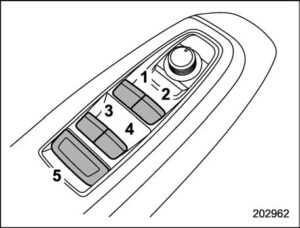
- For front left window (with one-touch auto up and down feature)
- For front right window (with one-touch auto up and down feature (if equipped))
- For rear left window
- For rear right window
- Lock switch
All door windows can be controlled by the power window switch cluster on the driver-side door. These switches illuminate when activated.
- Passenger’s side power window switches:
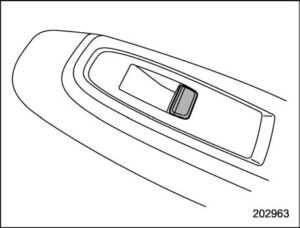
Each passenger’s window can be controlled by the power window switch located on the door. These switches illuminate when activated.
Operating the window
- Automatically close*
- Close
- Open
- Automatically open*
To stop the window halfway, operate the switch to the opposite side.
- Without a one-touch auto up-and-down feature
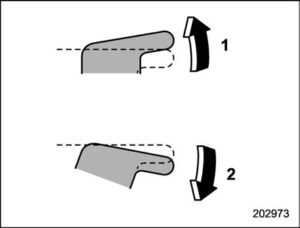
Read all Instructions for Child safety locks Base Sedan User Guide
Subaru Impreza 2023 Ignition switch, Meters and gauges Base Sedan User Guide
Ignition switch (models without “keyless access with push-button start system”)
WARNING
- Never turn the ignition switch to the “LOCK” position while the vehicle is being driven or towed because that will lock the steering wheel, preventing steering control. And when the engine is turned off, it takes a much greater effort than usual to steer.
- Before leaving the vehicle, . Before leaving the vehicle, always remove the key from the ignition switch for safety and never allow an unattended child to remain in the vehicle. Failure to follow this procedure could result in injury to a child or others. Children could operate the power windows, the moonroof or other controls or even make the vehicle move.
CAUTION
Do not attach a large key holder or key case to either key. If it banged against your knees or hands while you are driving, it could turn the ignition switch from the “ON” position to the “ACC” or “LOCK” position, thereby stopping the engine. Also, if the key is attached to a key holder or to a large bunch of other keys, centrifugal force may act on it as the vehicle moves, resulting in unwanted turning of the ignition switch.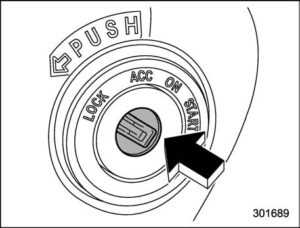 NOTE
NOTE
- Keep the ignition switch in the “LOCK” position when the engine is not running.
- Using electrical accessories for a long time with the ignition switch in the “ON” or “ACC” position can cause the battery to go dead.
- If the ignition switch will not move from the “LOCK” position to the “ACC” position, turn the steering wheel slightly to the left and right as you turn the ignition switch.
The ignition switch has four positions: LOCK, ACC, ON and START.
Key positions
CAUTION
Do not turn the ignition switch to the “START” position while the engine is running.
NOTE
- To turn the key from the “ACC” to “LOCK” position, the select lever must be in the “P” position (CVT models) and the key must be pushed in and turned. . If your registered key fails to start the engine, pull out the key once (the security indicator light will blink), and then insert the key again and turn it to the “START” position again to restart the engine.
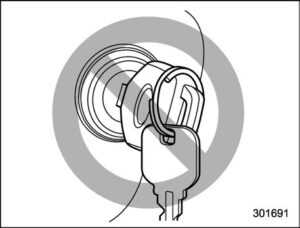
- The key grip is touching another key or a metallic key holder.
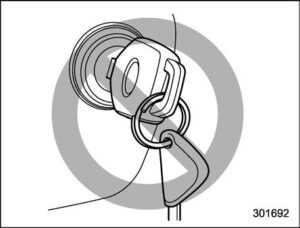
- The key is near another key that contains an immobilizer transponder.
- The key is near or touching another transmitter.
Key reminder chime
The reminder chime sounds when the driver’s door is opened and the ignition switch is in the “LOCK” or “ACC” position.
The chime stops under the following conditions:
- The ignition switch is turned to the “ON” position.
- The key is removed from the ignition switch.
The driver’s door is closed.
Ignition switch light (if equipped)
- For easy access to the ignition switch in the dark, the ignition switch light illuminates when the driver’s door is opened or when the driver’s door is unlocked using the remote keyless entry transmitter.
The light remains illuminated for several tens of seconds and then gradually turns off under the following conditions. - The driver’s door is closed.
- The doors are unlocked using the remote keyless entry transmitter.
The light turns off immediately under the following conditions.
- The ignition switch is turned to the “ON” position.
- All doors and the rear gate (5-door models) are locked using the remote keyless entry transmitter.
Push-button ignition switch (models with “keyless access with push-button start system”)
Safety precautions
Refer to “Safety precautions” 2-4.
Operating range for push-button start system
Sedan
- Antennas
- Operating range

5-door models
- Antennas
- Operating range
NOTE
- If the access key fob is not detected within the operating range of the antennas inside the vehicle, the push-button ignition switch and the engine start cannot be operated.
- Even when the access key fob is outside the vehicle, if it is placed too close to the glass, it may be possible to switch the power or to start the engine. . Do not leave the access key fob in the following places. It may become impossible to operate the push-button ignition switch and the engine start. It may also cause a false warning to issue although no malfunction actually occurs, or not to issue a warning when any malfunction occurs.
- On the instrument panel
- On the floor
- Inside the glove box
- Inside the door trim pocket
- On the rear seat
- On the rear shelf (sedan)
- Inside the trunk (sedan)
- In the cargo area (5-door models)
- When operating the push-button ignition switch or starting the engine, if the access key fob battery is discharged, perform the procedure described in “Access key fob – if access key fob does not operate properly” 9-19. In such a case, replace the battery immediately. Refer to “Replacing the battery of access key fob” 11-47.
Read all Instructions for Ignition switch, Meters and gauges Base Sedan User Guide
Subaru Impreza 2023 Illumination brightness and Warning indicator Base Sedan User Guide
2023 Subaru Impreza brightness and indicator Base Sedan Guidelines
Illumination brightness control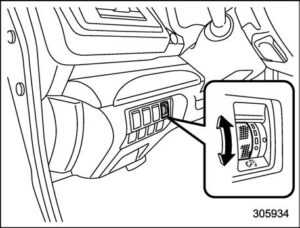
The illumination brightness of the instrument panel illuminates under the following conditions.
For models without an “AUTO” position
- The light switch is in the “ ” or “ ” position.
For models with the “AUTO” position:
- The light switch is in the “ ” or “ ” position when the ambient light is dark.
- The light control switch is in the “AUTO”
position and the headlights illuminate automatically. You can adjust the illumination brightness for better visibility. To brighten, turn the control dial upward. To darken, turn the control dial downward.
- The light switch is in the “ ” or “ ” position when the ambient light is dark.
- The light control switch is in the “AUTO” position and the headlights illuminate automatically.
You can adjust the illumination brightness for better visibility.
To brighten, turn the control dial upward. To darken, turn the control dial downward.
NOTE
- When the control dial is turned fully upward, the illumination brightness becomes the maximum and the automatic dimming function does not work at all.
- The brightness setting is not canceled even when the ignition switch is turned to the “LOCK”/“OFF” position.
Auto dimmer cancel function
When the ambient light is bright, the illumination brightness is set to the maximum regardless of the position of the control dial. In this case, you cannot adjust the illumination brightness by using the control dial. When the ambient light is dark, you can dim the illumination brightness as described above.
The operational/non-operational setting and sensitivity of the auto dimmer cancel function can be changed by your SUBARU dealer. Contact your SUBARU dealer for details.
Warning and indicator
Initial illumination for system check
Several of the warning and indicator lights illuminate when the ignition switch is initially turned to the “ON” position. This permits checking the operation of the bulbs. Apply the parking brake and turn the ignition switch to the “ON” position. For the system check, several of the following lights illuminate and then turn off after several seconds or after the engine has started.
- Seatbelt warning light (The seatbelt warning light turns off only when the driver fastens the seatbelt.)/Front pas-senger’s seatbelt warning light (The seatbelt warning light turns off only when the front seat passenger fastens the seatbelt.)
- Rear seatbelt warning light
- SRS airbag system warning light
- Front passenger’s frontal airbag ON indicator light
- Front passenger’s frontal airbag
- CHECK ENGINE warning light/Malfunction indicator light
- Coolant temperature low indicator light/Coolant temperature high warning light
- Charge warning light
- Oil pressure warning light: AT OIL TEMP warning light
- Low tire pressure warning light (U.S. spec. models)
- ABS warning light
- Brake system warning light
- Electronic parking brake light: Low fuel warning light
- AWD warning light
- Power steering warning light
- Vehicle Dynamics Control warning light/ Vehicle Dynamics Control operation indicator light
- Vehicle Dynamics Control OFF indicator light
If any lights fail to illuminate, it indicates a burned-out bulb or a malfunction of the corresponding system. Consult your authorized SUBARU dealer for repair.
Seatbelt warning light and chime
Your vehicle is equipped with a seatbelt warning device at the driver’s and passenger’s seats, as required by current safety standards.
Driver’s and front passenger’s seats
With the ignition switch turned to the “ON” position, this device reminds the driver and front passenger to fasten their seatbelts by illuminating the warning lights in the locations indicated in the following illustration and sounding a chime.

Driver’s seat

Front passenger’s seat
Operation
When the ignition switch is turned to the “ON” position, the driver’s and/or front passenger’s warning light will illuminate, then it will blink for several seconds. If the seatbelt of the driver’s seat is not fastened, the warning chime may make a peep sound.
NOTE
- If the driver’s and/or front passenger’s seatbelt(s) are/is not fastened while driving, the seatbelt warning system operates as follows according to the vehicle speed.
- The warning light will illuminate when driving approximately 4 mph (6 km/h) or less.
- The warning light will blink, and the warning chime will make a peep sound when driving between approximately 4 mph (6 km/h) and 13 mph (20 km/h). The warning chime will stop when the vehicle stops.
- The warning light will blink, and the warning chime will sound loud when 15 seconds have elapsed while driving between approximately 4 mph (6 km/h) and 13 mph (20 km/h).
- The warning light will blink, and the warning chime will sound loud when driving approximately more than 13 mph (20 km/h).
- The warning light will turn off and the warning chime will stop when the seatbelt is fastened.
If there is no passenger on the front passenger’s seat, the seatbelt warning system for the front passenger’s seat will be deactivated. The front passenger’s seatbelt warning system monitors whether or not there is a passenger in the front passenger’s seat.
CAUTION
Observe the following precautions. Failure to do so may prevent the device from functioning correctly or cause the device to fail.
- Do not install any accessory such as a table or TV onto the seat-back.
- Do not store a heavy load in the seatback pocket.
- Do not allow the rear seat occupant to place his/her hands or legs on the front passenger’s seatback, or allow him/her to pull the seatback.
- Do not use front seats with their backward-forward position and seatback not being locked into place securely. If any of them are not locked securely, adjust them again. For the adjusting procedure, refer to “Manual seat” P33.
If the seatbelt warning system for the front passenger’s seat does not function correctly (e.g., it is activated even when the front passenger’s seat is empty or it is deactivated even when the front passenger has not fastened his/her seatbelt), take the following actions.
- Ensure that no article is placed on the seat other than a child restraint system and its child occupant, although we strongly recommend that all children sit in the rear seat properly restrained.
- Ensure that there is no article left in the seatback pocket.
- Ensure that the backward-forward position and seatback of the front passenger’s seat are locked into place securely by moving the seat back and forth.
If still the seatbelt warning system for the front passenger’s seat does not function correctly after taking the relevant corrective actions described above, immediately contact your SUBARU dealer for an inspection.
Read all Instructions for Illumination brightness and Warning indicator Base Sedan User Guide
Subaru Impreza 2023 Door open warning light and Base Sedan User Guide
Door open warning light
The warning light illuminates if any door or the rear gate is not fully closed. This function is effective even if the ignition switch is in the “LOCK”/“OFF” or “ACC” position, or the key is removed from the ignition switch.
For some models, only the open doors are indicated by the warning lights. Always make sure this light is not illuminated before you start to drive.
Engine hood open warning light
The warning light illuminates if the engine hood is not fully closed. This function is effective even if the ignition switch is in the
“LOCK”/“OFF” or “ACC” position, or the key is removed from the ignition switch. Always make sure this light is not illuminated
before you start to drive.
All-Wheel Drive warning light
This light blinks if the vehicle is driven with tires of differing diameters fitted on the wheels or with excessively low air pressure in any of the tires.
WARNING
If the AWD warning light flashes, promptly park in a safe location then check whether all four tires are the same diameter and whether any of the tires have a puncture or has lost air pressure for some other reason. Continuing to drive with the AWD warning light flashing can lead to powertrain damage.
NOTE
If the temporary spare tire is used, the AWD warning light may flash. Use of the temporary spare tire should therefore be restricted to the minimum time necessary. Replace the temporary spare tire with a conventional tire as soon as possible.
Power steering warning light
While the engine is running, this warning light illuminates when a malfunction has been detected in the electric power steering system.
CAUTION
When the power steering warning light is illuminated, there may be more resistance when the steering wheel is operated. Drive carefully to the nearest SUBARU dealer and have the vehicle inspected immediately.
NOTE
If the steering wheel is operated in the following ways, the power steering control system may temporarily limit the power assist in order to prevent the system components, such as the control computer and drive motor, from overheating.
- The steering wheel is operated frequently and turned sharply while the vehicle is maneuvered at extremely low speeds, such as while frequently turning the steering wheel during parallel parking.
- The steering wheel remains in the fully turned position for a long period of time.
At this time, there will be more resistance when steering. However, this is not a malfunction. Normal steering force will be restored after the steering wheel is not operated for a while and the power steering control system has an opportunity to cool down. However, if the power steering is operated in a non-standard way which causes power assist limitation to occur too frequently, that may result in a malfunction of the power steering control system.
Vehicle Dynamics Control warning light/Vehicle Dynamics Control operation indicator
light Vehicle Dynamics Control warning light
CAUTION
The Vehicle Dynamics Control system provides its ABS control through the electrical circuit of the ABS. Accordingly, if the ABS is inoperative, the Vehicle Dynamics Control system becomes unable to provide ABS control. As a result, the Vehicle Dynamics Control system also becomes inoperative, causing the warning light to illuminate. Although both the Vehicle Dynamics Control system and ABS are inoperative in this case, the ordinary functions of the brake system are still available. You will be safe while driving with this condition, but drive carefully and have your vehicle checked at a SUBARU dealer as soon as possible.
NOTE
- If the electrical circuit of the Vehicle Dynamics Control system itself malfunctions, the warning light only
illuminates. At this time, the ABS (Anti-lock Brake System) remains fully operational. - The warning light illuminates when the electronic control system of the ABS/Vehicle Dynamics Control system malfunctions.
- The Vehicle Dynamics Control warning light, ABS warning light, and brake system warning light illuminate simultaneously if the EBD system malfunctions. For further details of the EBD system malfunction warning, refer to “Electronic Brake Force Distribution (EBD) system warning”
The Vehicle Dynamics Control system is probably inoperative under any of the following conditions. Have your vehicle checked at a SUBARU dealer immediately?
- The warning light does not illuminate when the ignition switch is turned to the “ON” position.
- The warning light illuminates while the vehicle is running.
NOTE
- If the warning light behavior is as described in the following examples, the Vehicle Dynamics Control system may be considered normal.
- The warning light illuminates when the ignition switch is turned to the “ON” position and turns off approximately 2 seconds after the engine has started.
- The warning light illuminates right after the engine is started but turns off immediately, remaining off.
- The warning light illuminates after the engine has started and turns off while the vehicle is subsequently being driven.
- The warning light illuminates during driving, but it turns off immediately and remains off.
- The warning light illuminates when the engine has stalled and continues to illuminate after the engine has been restarted However, it will turn off once the vehicle starts moving.
Vehicle Dynamics Control operation indicator light
The indicator light flashes during activation of the skid suppression function and during activation of the traction control function.
Vehicle Dynamics Control operation indicator light
The indicator light flashes during activation of the skid suppression function and during activation of the traction control function.
NOTE
- The light may remain illuminated for a short period of time after the engine has been started, especially in cold weather. This does not indicate the existence of a problem. The light should turn off as soon as the engine has warmed up.
- The indicator light illuminates when the engine has developed a problem and the CHECK ENGINE warning light/malfunction indicator light is on.
The Vehicle Dynamics Control system is probably malfunctioning under the following condition. Has your vehicle been checked at a SUBARU dealer as soon as possible? The light does not turn off even after the lapse of several minutes (the engine has warmed up) after the engine has started.
Read all Instructions for the Door open warning light and Base Sedan User Guide
Subaru Impreza 2023 Combination meter display Base Sedan User Guide
Combination meter display (color LCD) (if equipped)
WARNING
Always pay adequate attention to safe driving when operating the combination meter display (color LCD) while the vehicle is in motion. When operation of the combination meter display (color LCD) interferes with your ability to concentrate on driving, stop the vehicle before performing operations on the screen. Also, do not concentrate on the display while driving. Doing so may cause you to look away from the road and could result in an accident. Various information will be shown on the combination meter display (color LCD). Also, a warning message will appear on the display if a malfunction is detected. In addition, several settings for the displayed content can be performed.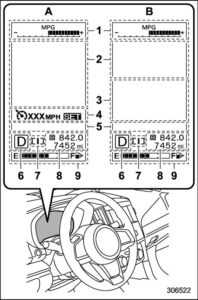
Combination meter display (color LCD)
- ECO gauge (Refer to “ECO gauge” �3-11.)
- Warning screen (Refer to “Warning screen” �3-35.)/Basic screen (Refer to “Basic screens” �3-36.)
- EyeSight screen
- Cruise control information display*
- Telltale screen (Refer to “Telltale screen” �3-35.)
- Select lever/gear position indicator (Refer to “Select lever/gear position indicator (CVT models)” �3-30.)
- SI-DRIVE indicator light (if equipped) (Refer to “SI-DRIVE” �7-31.)
- Odometer (Refer to “Odometer” �3-9.)/ Double trip meter (Refer to “Double trip meter” �3-9.)
- Fuel gauge (Refer to “Fuel gauge” �3- 10
- Models without the EyeSight system
- Models with the EyeSight system: when the EyeSight system is deactivated.
- Models with the EyeSight system: when the EyeSight system is activated.
- For models with the EyeSight system, the cruise control information display will not be shown when the EyeSight system is deactivated.
Basic operation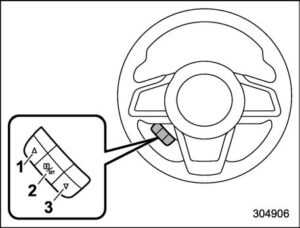
Control switch
- (Up)
- /SET (Enter)
- (Down)
By operating or off the control switch, the screens and selected items can be switched. When the “ /SET” switch is pulled toward you, the item can be selected and set. If there are some useful messages, such as vehicle information, warning information, etc., they will interrupt the current screen, and appear on the display accompanied by a beep. If such a screen is displayed, take proper action according to the message shown on the screen. The warning screen will return to the original screen after a few seconds. While the “ ” information reminder is shown on the display, it may be possible to display the warning screen again. To recall the message marked with “ ” on the display, pull the “ /SET” switch on the steering wheel toward you.
NOTE
When the multi-function display (color LCD) is set to the setting screen, the combination meter display (color LCD) cannot be controlled by pulling on the and “ /SET” on the control switch.
Welcome screen (opening animation) and Good-bye screen (ending animation)
When the driver’s door is opened and closed after unlocking the door, the welcome screen (opening animation) will appear on the combination meter display (color LCD) for approximately 20 seconds. When the ignition switch is turned to the “LOCK”/“OFF” position, the combination meter display (color LCD) gradually turns off showing the goodbye screen (ending animation).
NOTE
- The welcome screen and the good-bye screen may differ in the actual words and appearance.
- Once the welcome screen appears, it takes a certain period of time to display it again.
- If the ignition switch is operated after unlocking the driver’s door, the welcome screen will not appear even when the driver’s door is opened and closed.
- The welcome screen will disappear when you lock the driver’s door by using the remote keyless entry system (all models) or the keyless access function (if equipped) while the welcome screen is displayed.
- The welcome screen including the multi-function display (color LCD) (if equipped) and the audio/navigation unit can be set to on or off. For details, refer to “Welcome Screen” 3-38.
Read all Instructions for the Combination meter display Base Sedan User Guide
Subaru Impreza 2023 Multi-function display Base Sedan User Guide
2023 Subaru Impreza Multi-Function Display Base Sedan Guidelines
Multi-function display (color LCD) (if equipped)
NOTE
For models with multi-function display (color LCD), refer to “Multi-function display (color LCD)” P 3-46..
- Outside temperature indicator
- X-MODE indicator (if equipped)
- Driving information display
- Clock With the ignition switch in the “ACC” position, the clock appears on the display. With the ignition switch in the “ON” position, the outside temperature indicator, driving information display and clock all appear on the display.
NOTE
The indicated values vary in accordance with changes in the vehicle’s running conditions. Also, the indicated values may differ slightly from the actual values and should thus be treated only as a guide.
Driving information display
NOTE
You can set the units for both the multifunction display (black and white) and the combination meter at the same time. For details about setting the language and units, refer to “Type A combination meter” P 3-11 or “Menu screens” P 3-38.
How to change the information display
INFO button
Pressing the INFO button on the steering wheel switches changes the display to the following sequence.
Driving range on remaining fuel
- When setting the displayed unit as MPH
- When setting the displayed unit as km/h
- The driving range indicates the distance that can be driven taking into account the amount of fuel remaining in the tank and the average rate of fuel consumption.

- When setting the displayed unit as MPH
When setting the displayed unit as km/h If the driving range is shown as “ ”, there is only a tiny amount of fuel left in the tank.
NOTE
The driving range on the remaining fuel is only a guide. The indicated value may differ from the actual driving range on the remaining fuel, so you must immediately fill the tank when the low fuel warning light illuminates.
Average fuel consumption
- Displays the driving range per gallon of fuel
- Displays the driving range per liter of fuel
- Displays the fuel consumption per 100 km This display shows the average rate of fuel consumption since the trip meter was last reset.

TRIP RESET switch
Press the TRIP RESET switch to switch between the displays for the average fuel consumption that corresponds to the A trip meter mileage and the average fuel consumption that corresponds to the B trip meter mileage. When the trip meter display is reset, the corresponding average fuel consumption value is also reset.
NOTE
- When the trip meter display is reset, the average fuel consumption corresponding to that trip meter display is not shown until the vehicle has subsequently covered a distance of 1 mile (or 1 km).
- The units for measuring average fuel consumption cannot be changed.
Current fuel consumption
- Displays the driving range per gallon of fuel
- Displays the driving range per liter of fuel
- Displays the fuel consumption per 100 km
This indication shows the rate of fuel consumption at the present moment.
Journey time (models without combination meter display (color LCD)) The journey time shows the time that has elapsed since the ignition switch was turned to the “ON” position
The journey time shows the time that has elapsed since the ignition switch was turned to the “ON” position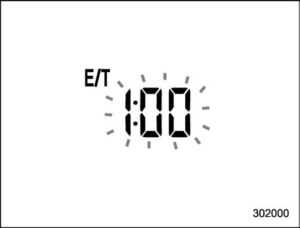
The journey time indication flashes each time a complete hour has elapsed. If the display is giving a reading other than the journey time, the display switches to the journey time, flashes for 5 seconds, and returns to its original reading each time a complete hour has elapsed.
NOTE
The journey time is reset when the ignition switch is turned to the “ACC” or “LOCK”/“OFF” position.
Read all Instructions for the Multi-function display Base Sedan User Guide
Subaru Impreza 2023 Clock and Light Control Base Sedan User Guide
Clock
For models with a SUBARU genuine navigation and/or audio system, the clock can be adjusted using either auto mode or manual mode.
- Auto mode: automatic clock adjustment
- Manual mode: manual clock adjustment
CAUTION
The clock in the multi-function display (color LCD) cannot be adjusted, if the SUBARU genuine navigation and/or audio system is removed.
Setting the clock manually
Multi-function display (black and white)
- Turn the ignition switch to “ON
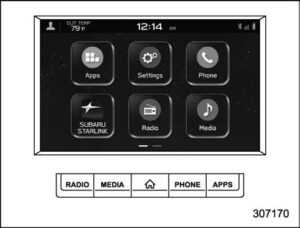
- Press (HOME).
- Touch (Settings).
- ? “General”
- ? “Clock”
- ? “Time Setting””

- ? “Manual”
- ? or
- ? “OK”
NOTE
The clock setting screen can also be displayed by touching the clock on the status bar.
inch display models
- Turn the ignition switch to the “ON” position.
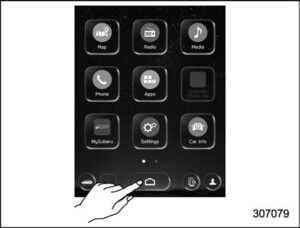
- Touch (HOME).
- ? (Settings)
- ? “General”
- ? “Clock”
- ? “Time Setting”
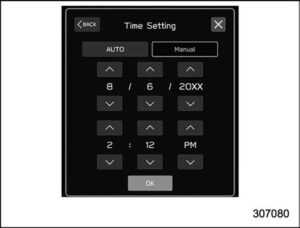
- ? “Manual”
- ? or
- ? “OK”
NOTE
The clock setting screen can also be displayed by touching the clock on the status bar.
Press the “+” button or the “−” button beside the clock.
& Setting the Clock Automatically
Dual 7.0-inch display models
- Turn the ignition switch to the “ON” position.
- Press (HOME).
- Touch (Settings).
- ? “General”
- ? “Clock”
- ? “Time Setting”
Read all Instructions for the Clock and Light Control Base Sedan User Guide
Subaru Impreza 2023 Mirrors And Horn Base Sedan User Guide
Mirrors
Always check that the inside and outside mirrors are properly adjusted before you start driving.
Inside mirror
- Normal position
- Anti-glare position
Push the tab on the mirror for normal use. To reduce glare from the headlights of the vehicle behind you, pull the tab to the antiglare position.
Auto-dimming mirror/compass with Home Link® (if equipped)
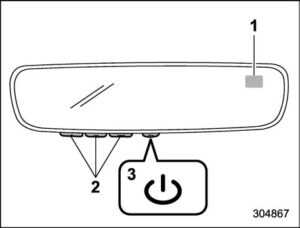
- Compass
- Switch
During nighttime driving, the auto-dimming feature senses distracting glare from vehicle headlights behind you and automatically dims to eliminate the glare and preserve your vision.
To Operate the Auto-Dimming Feature
Press the “ ” switch to turn the auto-dimming feature on/off. The auto-dimming feature is enabled when the switch’s green LED indicator is on. The auto-dimming feature will default to on with each ignition cycle.
To Operate the Compass Feature
- To turn the compass feature on/off, press and hold the switch for more than 3 seconds or until the display turns on/off. The compass feature will default to one with each ignition cycle.
- If the display reads “C”, slowly drive the vehicle in circles until compass is calibrated.
Compass calibration zones
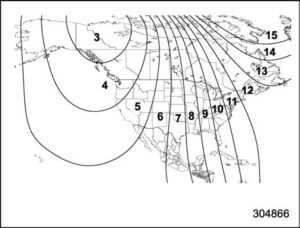
- To adjust for compass zone variance:
- Find your current location and zone number on the map.
- Press and hold the “ ” switch for more than 6 seconds or until a zone number appears in the display.
- Once the zone number appears in the display, toggle the “ ” switch again until your current location zone number appears. After you stop pressing the switch, your new zone number will be saved. Within a few seconds, the display will show a compass direction.
- If the vehicle’s magnetics have changed or if the compass appears inaccurate, recalibrate the compass. Press and hold the “ ” switch for more than 9 seconds or until a “C” appears in the display. Once a “C” appears in the display, slowly drive the vehicle in circles until the compass is calibrated.
Home Link® Wireless Control System
The Home Link® Wireless Control System provides a convenient way to replace up to three hand-held radio-frequency remotes used to activate devices such as gate operators, garage door openers, entry door locks, security systems, and even home lighting. The below steps are generic programming instructions; for Genie and Sommer garage door openers, please go directly to the Hom Link website. Additional information and programming videos can be found at www.HomeLink.com and www.youtube.com/Home Link Gentex.
CAUTION
- Before programming Home Link to a garage door opener or gate operator, make sure that people and objects are out of the way of
the device to prevent potential harm or damage. - When programming a garage door opener, it is advised to park outside of the garage.
- Do not use Home Link with any garage door opener that lacks safety stop and reverse features, as required by U.S. federal safety standards (this includes any garage door opener model manufactured before April 1, 1982). A garage door that cannot detect an object signaling the door to stop and reverse does not meet current U.S. federal safety standards.
- It is also recommended that a new battery be placed in the handheld remote (garage door opener remote) of the device for quicker and more accurate training.
- Some vehicles may require the ignition switch to be turned to the “ON” or “ACC” position for programming and/or operation of the Home Link.
- Keep the hand-held remote (garage door opener remote) of the device you are programming for use in other vehicles as well as
for future Home Link programming. It is also suggested that upon the sale of the vehicle, the programmed Home Link buttons
be erased for security purposes. Refer to “Erasing Home Link Buttons” �P3-83.
Programming a New Home Link Button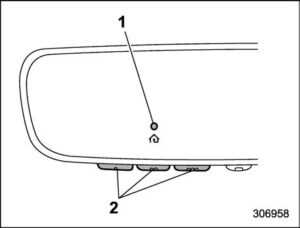
- Indicator Light
- Home Link buttons
- Press and release the Home Link button that you would like to program. The Home Link indicator light will flash orange slowly (if not, refer to “Erasing Home Link Buttons” �P3-83.
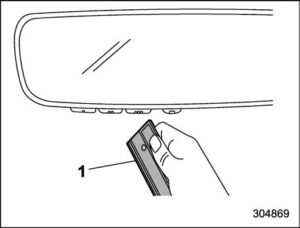
- Garage door opener remote
- Position the hand-held remote (garage door opener remote) 1 to 3 inches (2 to 8 cm) away from the Home Link button that you would like to program.
NOTE
Some hand-held remotes (garage door opener remotes) may actually train better at a distance of 6 to 12 inches (15 to 30 cm). Keep this in mind if you have difficulty with the programming process.
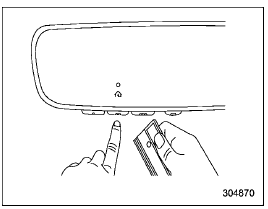
- While the Home Link indicator light is flashing orange, press and hold the hand-held remote button. Continue pressing the hand-held remote button until the Home Link indicator light changes from orange to green. You may now release the hand-held remote button.Indicator light
- Press the Home Link button that you would like to program and observe the indicator light.
- If the indicator light remains constant green, your device should operate when the Home Link button is pressed. At this point, if your device operates, programming is complete.
- If the indicator light rapidly flashes green, firmly press, hold for two seconds, and release the Home Link button up to three times to complete the programming process. At this point, if your device operates, programming is complete. If the device does not operate, continue with the next step of the programming instructions.
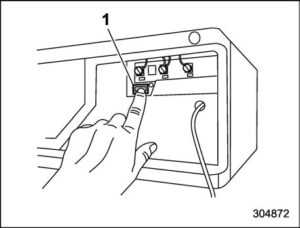
- At the garage door opener motor, (security gate motor, etc.) locate the “Learn”, “Smart”, or “Program” button.
This can usually be found where the hanging antenna wire is attached to the motor-head unit (see the device’s manual to identify this button). The name and color of the button may vary by manufacturer.
A ladder and/or second person may simplify the following steps. - Firmly press and release the “Learn”, “Smart”, or “Program” button. You now have 30 seconds in which to complete step 7.
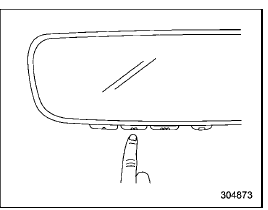
- Return to the vehicle and firmly press, hold for two seconds and release the Home Link button up to three times. At this point programming is complete and your device should operate when the Home Link button is pressed and released.
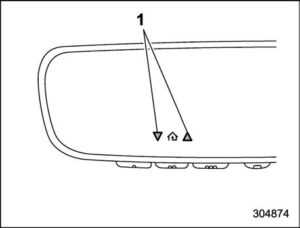 Status indicators
Status indicators - If status indicator arrows appear next to the indicator light, please refer to “Garage Door Two-Way Communication” �P3-84.
In the event that there are still programming difficulties or questions, additional Home Link information and programming videos can be found at www.HomeLink.com and www.youtube.com/HomeLinkGentex. For Genie and Sommer garage door openers please go directly to the Home Link website.
Read all Instructions for Mirrors And Horn Base Sedan User Guide
Subaru Impreza 2023 Climate Controls and Audio Base Sedan User Guide
Climate control panel
WARNING
- The cooling function operates only when the engine is running.
- Do not leave children or adults
who would normally require the support of others alone in your vehicle? Pets should not be left alone either. On hot, sunny days, temperatures in a closed vehicle could quickly become high enough to cause severe or possibly fatal injuries to people or animals.
Type A
- Airflow mode selection dial (Refer to “Airflow mode selection” P 4-7.)
- Fan speed control dial (Refer to “Fan speed control” P 4-9.)
- Temperature control dial (Refer to “Temperature control” P 4-8.)
- Air conditioner button (Refer to “Air conditioner control” P 4-9.)
- Air inlet selection button (Refer to “Air inlet selection” P 4-9.)
- Rear window defogger button and mirror heater button (if equipped) (Refer to “Defogger and deicer” P 3-87.)
Type B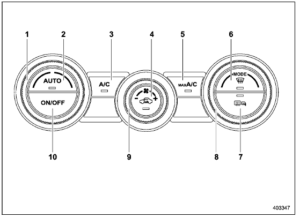
- Temperature control dial (Refer to “Automatic climate control operation (type B and C)” P 4-6 and/or “Temperature control” P 4-8.)
- AUTO button (Refer to “Automatic climate control operation (type B and C)” P 4-6.)
- Air conditioner button (Refer to “Air conditioner control” P 4-9.)
- Air inlet selection button (Refer to “Air inlet selection” P 4-9.)
- MAX A/C button (Refer to “MAX A/C mode (for type B and C)” P 4-8.)
- Defroster button (Refer to “Defrosting” P 4-10.)
- Rear window defogger button and mirror heater button (Refer to “Defogger and deicer” P 3-87.)
- Airflow mode selection dial (Refer to “Airflow mode selection” P 4-7.)
- Fan speed control dial (Refer to “Fan speed control” P 4-9.)
- ON/OFF button (Refer to “Automatic climate control operation (type B and C)” P 4-6.)
NOTE
The climate control screen is displayed on the multi-function display (color LCD). Refer to “Climate control screen” P 3-49.
Type C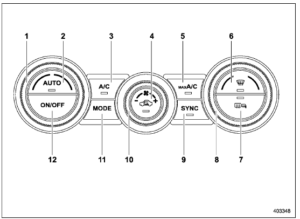
- Driver’s side temperature control dial(Refer to “Automatic climate control operation (type B and C)” P 4-6 and/or “Temperature control” P 4-8.)
- AUTO button (Refer to “Automatic climate control operation (type B and C)” P 4-6.)
- Air conditioner button (Refer to “Air conditioner control” P 4-9.)
- Air inlet selection button (Refer to “Air inlet selection” P4-9.)
- MAX A/C button (Refer to “MAX A/C mode (for type B and C)” P 4-8.)
- Defroster button (Refer to “Defrosting” P 4-10.)
- Rear window defogger button and mirror heater button (Refer to “Defogger and deicer” P 3-87.)
- Passenger’s side temperature control dial (Refer to “Temperature control” P 4-8.)
- SYNC button (Refer to “SYNC mode (type C)” P 4-8.)
- Fan speed control dial (Refer to “Fan speed control” P 4-9.)
- Airflow mode selection button (Refer to “Airflow mode selection” P 4-7.)
- ON/OFF button (Refer to “Automatic climate control operation (type B and C)” P 4-6.)
NOTE
The climate control screen is displayed on the multifunction display (color LCD). Refer to “Climate control screen” P 3-49.
Subaru Impreza 2023 Audio Base Sedan User Guide
Antenna
Roof antenna (for Rod type)
CAUTION
- Be sure to remove the antenna rod before entering garages, parking towers, and other locations with low ceilings.
- Remove the antenna rod before washing your car at a car wash. If the antenna rod remains attached, it may scratch the roof.
- When reinstalling the removed antenna rod, be sure to fully tighten it.
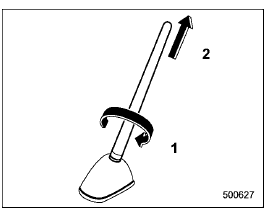
- Unscrew
- Remove
The roof antenna is installed in the center at the rear part of the roof. The antenna rod can be removed by unscrewing it from its base.
Roof antenna (for Shark fin type)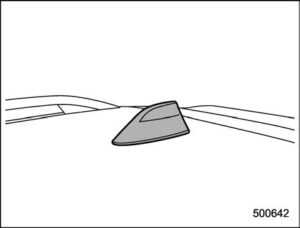
The roof antenna is installed in the center of the roof at the rear.
Audio set
If your vehicle is equipped with a genuine SUBARU navigation system or audio system, refer to the separate navigation/ audio Owner’s Manual for details.
NOTE
The climate control screen is displayed on the multifunction display (color LCD).
The roof antenna is installed in the center at the rear part of the roof. The antenna rod can be removed by unscrewing it from its base.
WARNING:
who would normally require the support of others alone in your vehicle? Pets should not be left alone either. On hot, sunny days, temperatures in a closed vehicle could quickly become high enough to cause severe or possibly fatal injuries to people or animals.
Read all Instructions for Climate Controls and Audio Base Sedan User Guide
Subaru Impreza 2023 Accessory Power And Cargo Area Base Sedan User Guide
Accessory power outlets
Electrical power (12 V DC) is available at any of the accessory power outlets when the ignition switch is in either the “ACC” or “ON” position. Accessory power outlets are located in the following places.
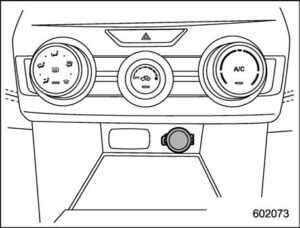
Power outlet below the climate control dials
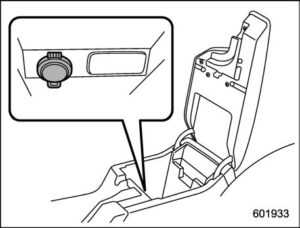
Power outlet in the center console You can use an in-vehicle electrical appliance by connecting it to an outlet. The maximum power rating of an appliance that can be connected is 120 W.
CAUTION
- Do not attempt to use a cigarette lighter in the accessory power outlets.
- Do not place any foreign objects, especially metal ones such as coins or aluminum foil, into the accessory power outlet. That
could cause a short circuit. Always put the cap on the accessory power outlet when it is not in use. - Use only electrical appliances which are designed for 12 V DC. The maximum power rating of an appliance that can be connected is 120 W. Do not use an appliance which exceeds the indicated wattage for each outlet.
- When using appliances connected to two outlets simultaneously, the total power consumed by them must not exceed120 W. Overloading the accessory power outlet can cause a short circuit. Do not use double adapters or more than one electrical
appliance. - If the plug on your electric appliance is either too loose or too tight for the accessory power outlet, this can result in a poor
contact or cause the plug to get stuck. Only use plugs that fit properly. - Use of an electric appliance in the accessory power outlet for a long period of time, while the engine is not running, can cause battery discharge.
- Before driving your vehicle, make sure that the plug and the cord on your electrical appliance will not interfere with your shifting gears and operating the accelerator and brake pedals. If they do, do not use the electrical appliance while driving.

NOTE
When the lid of the center console is closed, an opening remains between the center console and the lid to allow the power outlet in the center console to be used. Pass the cord of the electrical appliance through this opening.
Use with a cigarette lighter (dealer option)
To use the accessory power outlet as a cigarette lighter socket, purchase the cigarette lighter plug, which is an optional accessory. A cigarette lighter plug is available from your SUBARU dealer. The cigarette lighter operates only when the ignition switch is in the “ON” or “ACC” position. To use the cigarette lighter, push in the knob and wait a few moments. It will automatically spring up when ready for use.
WARNING
To avoid being burned, never grasp the lighter by the end with the heating element. Doing so could result in injury and could also da-mage the heating element.
CAUTION
- Do not hold the lighter pushed in, because it will overheat.
- The electrical power socket is originally designed to use a genuine SUBARU cigarette lighter plug. Do not use a non-genuine cigarette lighter plug in the socket. Doing so may cause a short circuit and overheating, resulting in a fire.
- If the socket is ever used for a plug-in accessory such as a cell phone, that may damage the portion of the socket’s internal mechanism that causes a cigarette lighter plug to “pop out” after its lighter element is heated. Therefore, do not place a cigarette lighter plug in a socket that has been used, even once, to power a plug-in accessory
- Doing so may cause the plug to stick and overheat, creating a potential fire hazard.
USB power supply
CAUTION
- The specification of a USB terminal that can be used is the A type
- If a different specification of the terminal is connected, a power supply or charging may not be possible, or the device may malfunction.
- There is a risk that a connected device may malfunction or data may be damaged. The connection of a device shall be performed at your responsibility.
- To avoid an electric shock or malfunction, observe the following precautions.
- Do not connect a USB hub.
- Do not insert any metal or other foreign object into the USB terminal.
- Do not spill water or other liquid on the USB terminal.
- Be careful not to pull the connected cable. Doing so could break the USB terminal and the connected device.
NOTE
- The USB power supply is designed to supply a maximum rated power of DC 5 V/2.1 A or DC 5 V/1 A. Before connecting a device, be sure to read the instruction manual of the device and check whether or not this specification of the output is supported by the device. If a device that requires power exceeding the maximum rating is connected, a power supply or charging may not be possible. Even if charging could be completed, the time required for charging may be longer than when the genuine charger for that device is used.
- Depending on the device, charging may be possible only when a special cable is used. In this case, be sure to connect the device using the special cable.
- When a device that communicates with a PC is connected, a power supply or charging may not be possible.
- When connecting a device for charging, disconnect the device promptly after charging is completed.
How to use the USB power supply
Use the USB terminal to use or charge an electronic device. When the ignition switch is in the “ACC” or “ON” position, power can be supplied to the electronic device. Up to DC 5 V can be supplied from each to the terminal.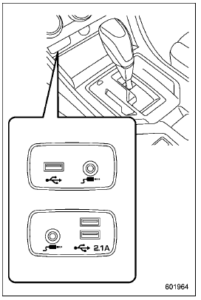
Read all Instructions for Accessory Power And Cargo Area Base Sedan User Guide
Subaru Impreza 2023 Cargo area cover (5-door models) Base Sedan User Guide
Cargo area cover (if equipped)
The cargo area cover is provided for covering the cargo area and to protect its contents from direct sunlight. This cover is detachable to make room for additional cargo.
Using the cover
To extend the cover, pull the end of the cover out of the housing, then insert its hooks into the catches as shown. To rewind it, unhook it from the catches and it will rewind automatically. You should hold on to the cover and guide it back into the cover housing while it is rewinding.
WARNING
Do not place anything on the extended cover. Putting excessive weight on the extended cover can break it and an object on the cover could tumble forward in the event of a sudden stop or collision. This could cause serious injury.
CAUTION
Be careful not to scratch the rear gate stays while extending and re-winding the cover. Scratches on the stays could cause leakage of gas from the stays, which may result in their inability to hold the rear gate open.
To install the front part of the cover
CAUTION
For models with a reclining rear seatback, when reclining, move the front part of the cover back so that it is not damaged.

- Align the right side of the front cover with the triangle mark before fixing the cover in place.
- Align the left side of the front cover with the triangle mark before fixing the cover in place.
- Push the front cover to the right side and adjust the size of the bar as necessary.
To remove the front cover
- Push the front cover to the right side and shorten the bar.
- Remove the front cover.
To remove the cover housing
- Rewind the cover.

- Push the cover housing to the right side and shorten it.
- Take it off the retainer.
Stowage of the cargo area cover
The cargo area cover can be stowed in under the cargo floor.
- Pull the strap to open the center part of the cargo floor lid, and then remove the lid.
- Remove the left and right parts of the cargo floor lid.

- Stow the cover housing in the cargo area end.
To install the cover housing
- Insert the protrusion located on the right end of the sleeve into the recess of the retainer.

- Push the cover housing to the right side and shorten the bar.
- Insert the other protrusion into the recess of the other retainer.
Cargo Tie-Down Hooks
The cargo area is equipped with several tie-down hooks so that cargo can be secured with a cargo net or ropes. When using the tie-down hooks, turn them down out of the storing recesses.
CAUTION
The cargo tie-down hooks are designed only for securing light cargo. Never try to secure cargo that exceeds the capacity of the hooks. The maximum load capacity is 22 lbs (10 kg) per hook.
Under-floor storage compartment (if equipped)
The storage compartment is located under the floor of the cargo area and can be used to store small items. Pull the strap to open the center part of the cargo floor lid, and then remove the lid.
NOTE
When storing a flat tire, put the storage tray in the trunk.
CAUTION
Always keep the lid of the storage compartment closed while driving to reduce the risk of injury in the event of a sudden stop or an accident.
Do not store spray cans, containers with flammable or corrosive liquids or any other dangerous items in the storage compartment.
Read all Instructions for Cargo area cover (5-door models) Base Sedan User Guide
Subaru Impreza 2023 Fuel Base Sedan User Guide
Fuel
CAUTION
The use of a fuel that is low in quality or the use of an inappropriate fuel additive may cause damage to the engine and/or fuel system.
Some gas stations, particularly those in high-altitude areas, offer fuels posted as regular octane gasoline with an octane rating below 87 AKI (90 RON). Use of those fuels is not recommended.
Fuel requirements
The engine is designed to operate using unleaded gasoline with an octane rating of 87 AKI (90 RON) or higher.
Fuel octane rating
Using gasoline with a lower octane rating can cause persistent and heavy knocking, which can damage the engine. Do not be concerned if your vehicle sometimes knocks lightly when you drive up a hill or when you accelerate. Contact your SUBARU dealer if you use a fuel with the specified octane rating and your vehicle knocks heavily or persistently.
RON
This octane rating is the Research Octane Number.
AKI
This octane rating is the average of the Research Octane and Motor Octane numbers and is commonly referred to as the Anti Knock Index (AKI).
Unleaded gasoline
The neck of the fuel filler pipe is designed to accept only an unleaded gasoline filler nozzle. Under no circumstances should leaded gasoline be used because it will damage the emission control system and may impair drivability and fuel economy.
Reformulated gasoline
SUBARU supports the use of reformulated gasoline when available. Reformulated gasoline has been blended to burn more cleanly and reduce vehicle emissions.
MMT
Some gasoline contains an octane-enhancing additive called MMT (Methylcyclopentadienyl Manganese Tricarbonyl). If you use such fuels, your emission control system performance may deteriorate and the CHECK ENGINE warning light/Mal-function indicator light may turn on. If this happens, return to your authorized SUBARU dealer for service. If it is determined that the condition is caused by the type of fuel used, repairs may not be covered by your warranty.
Gasoline for cleaner air
Your use of gasoline with detergent additives will help prevent deposits from forming in your engine and fuel system. This helps keep your engine in tune and your emission control system working properly, and is a way of doing your part for cleaner air. If you continuously use high-quality fuel with the proper detergent and other additives, you should never need to add any fuel system cleaning agents to your fuel tank. Many types of gasoline are now blended with materials called oxygenates. The use of these fuels can also help keep the air cleaner. Oxygenated blend fuels, such as ethanol (ethyl or grain alcohol) may be used in your vehicle but should contain no more than 10% ethanol for the proper operation of your SUBARU. Do not use any gasoline that contains more than 10% ethanol, including from any pump labeled, E15, E30, E50 or E85 (which are only some examples of fuel containing more than 10% ethanol). In addition, some gasoline suppliers are now producing reformulated gasoline, which are designed to reduce vehicle emissions.
SUBARU approves the use of reformulated gasoline. If you are not sure what the fuel contains, you should ask your service station operators if their gasoline contains detergents and oxygenates and if they have been reformulated to reduce vehicle emissions. As additional guidance, only use fuels suited for your vehicle as explained in the following description.
- Fuel should be unleaded and have an octane rating no lower than that specified in this manual.
- Methanol (methyl or wood alcohol) is sometimes mixed with unleaded gasoline. Methanol can be used in your vehicle ONLY if it does not exceed 5% of the fuel mixture AND if it is accompanied by sufficient quantities of the proper solvents and corrosion inhibitors required to prevent damage to the fuel system. Do not use fuel containing methanol EXCEPT under these conditions.
- If undesirable driveability problems are experienced and you suspect they may be fuel related, try a different brand of gasoline before seeking service at your SUBARU dealer.
- Fuel system damage or driveability problems that result from the use of improper fuel are not covered under the SUBARU Limited Warranty.
CAUTION
Do not let fuel spill on the exterior surfaces of the vehicle. Because fuel may damage the paint, be sure to wipe off any spilled fuel quickly. Paint damage caused by spilled fuel is not covered under the SUBARU Limited Warranty.
Fuel filler lid and cap
Locations of the fuel filler lid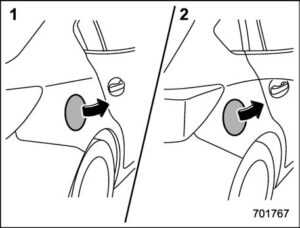
Fuel filler lid
- Sedan
- 5-door models
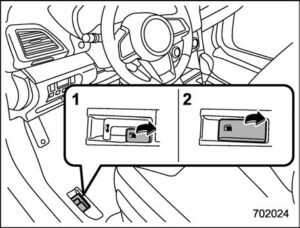
Fuel filler lid release lever
- Sedan
- 5-door models
Refueling
Only one person should be involved in refueling. Do not allow others to approach the area of the vehicle near the fuel filler pipe while refueling is in progress. Be sure to observe any other precautions that are posted at the service station.
- Before refueling, stop the vehicle, then turn off the ignition switch to turn off all the electrical components. At this time, the fuel filler lid also unlocks.
NOTE
When you lock the door, the fuel filler lid also locks. To unlock the fuel filler lid, perform one of the operations below.- Press the unlock button on the key fob.
- Press the unlock side of the power door locking switch.2. Push the rear side of the fuel filler lid.
- The fuel filler lid opens automatically.
- Open it further by hand.
WARNING
Before opening the fuel filler cap, first, touch the vehicle body or a metal portion of the fuel pump or similar object to discharge any static electricity that may be present on your body. If your body is carrying an electrostatic charge, there is a possibility that an electric spark could ignite the fuel, which could burn you. To avoid acquiring a new static electric charge, do not get back into the vehicle while refueling is in progress.
Read all Instructions for Fuel Base Sedan User Guide
Subaru Impreza 2023 Starting and Stopping Engine Base Sedan User Guide
Starting and stopping the engine (models without pushbutton start system)
Safety precautions
Refer to “Safety precautions” �P 2-4.
Operating range for pushbutton start system
Refer to “Operating range for push-button start system” �P 3-6.
Starting engine
WARNING
- There are some general precautions when starting the engine. Carefully read the precautions described in “Starting engine” �P 7-9.
- If the indicator on the push-button ignition switch flashes in green after the engine has started, never drive the vehicle.
The steering is still locked, and it may result in an accident.
NOTE
It may be difficult to start the engine when the battery has been disconnected and reconnected (for maintenance or other purposes). This difficulty is caused by the electronically controlled throttle’s self-diagnosis function. To overcome it, keep the ignition switch in the “ON” position for approximately 10 seconds before starting the engine.
CAUTION
- When the operation indicator on the push-button ignition switch is flashing in orange, there may be a malfunction with the vehicle.
Contact a SUBARU dealer immediately. - If the indicator on the push-button ignition switch is flashing in green after the engine has started, it means that the steering is still locked. Depress the brake pedal while moving the steering wheel to the right and left, and press the push-button ignition switch.
- Do not continue pushing the push-button ignition switch for more than 10 seconds. Doing so could cause a malfunction. If the engine does not start, stop pushing the push-button ignition switch. Instead, press the pushbutton ignition switch without depressing the brake pedal to switch the power status to “OFF”. Wait 10 seconds, and then push the push-button ignition switch to start the engine.
NOTE
- After the engine starts, the engine speed will be kept high.
- When the push-button ignition switch is pressed while depressing the clutch pedal (MT models) or the brake pedal (CVT models), the engine
starter operates for a maximum of 10 seconds and after starting the engine, the starter stops automatically. - When the push-button ignition switch is pressed while depressing the clutch pedal (MT models) or the brake pedal (CVT models), the engine can be started regardless of the status of the push-button ignition switch.
- If the security indicator light illuminates when you attempt to start the engine but the engine does not start, press the push-button ignition switch
to switch the power to “OFF” and then try to start the engine again. - If the engine does not start, press the push-button ignition switch without depressing the clutch pedal (MT models) or the brake pedal (CVT models) to switch the power to “OFF”. Then, while depressing the clutch pedal (MT models) or the brake pedal (CVT models) more forcefully, press the push-button ignition switch.
- The engine start procedures may not function depending on the radio wave conditions around the vehicle. In such a case, refer to “Starting engine” �9- 20.
- If the vehicle battery is discharged, the steering cannot be unlocked. Charge the battery.
- Do not shift the select lever (CVT models) or shift lever (MT models) while the starter is cranking.

- Operation indicator
- Push-button ignition switch
When the push-button ignition switch is pressed while depressing the clutch pedal (MT models) or the brake pedal (CVT models), the engine will start. The starting procedure for the engine is as follows.
MT models
- Carry the access key fob, and sit in the driver’s seat.
- Apply the parking brake.
- Shift the shift lever in neutral.
- Depress the brake pedal.
- Depress the clutch pedal until the indicator on the push-button ignition switch turns green.
- While depressing the clutch pedal, press the push-button ignition switch.
Starting engine
General precautions when starting the engine
WARNING
- Never start the engine from outside the vehicle (except when using the remote engine start system). It may result in an accident.
- Do not leave the engine running in locations with poor ventilation, such as a garage and indoors. The exhaust gas may enter the vehicle or indoors, and it may result in carbon monoxide poisoning.
- Do not start the engine near dry foliage, paper, or other flammable substances. The exhaust pipe and exhaust emissions can create a fire hazard at high temperatures.
CAUTION - If the engine is stopped while driving, the catalyst may overheat and burn.
- When starting the engine, be sure to sit in the driver’s seat (except when using the remote engine start system).
NOTE
- While pressing the select lever button in, the indicator on the push-button ignition switch will not turn green even when the select lever is in the “P” position.
- In case the engine does not start by the normal engine start procedure, move the select lever to the “P” position, and switch the power to “ACC”.
Depress the brake pedal, and press the push-button ignition switch for at least 15 seconds. The engine may start. Only use this engine start procedure in case of emergency. - When the engine is not started, the brake pedal may feel stiff. In such a case, depress the brake pedal more forcefully than usual. Check that the operation indicator on the push-button ignition switch turns green, and press the push-button ignition switch to start the engine.
Stopping the engine
- Stop the vehicle completely.
- Move the select lever to the “P” position (CVT models).
- Press the push-button ignition switch.
Read all Instructions for Starting and Stopping the Engine Base Sedan User Guide
Subaru Impreza 2023 Continuously Variable Transmission Base Sedan User Guide
2023 Subaru Impreza Variable Transmission Base Sedan Guidelines
Continuously variable transmission
WARNING
Do not shift from the “P” or “N” position into the “D” or “R” position while depressing the accelerator pedal. This may cause the vehicle to jump forward or backward.
CAUTION
- Observe the following precautions. Otherwise, the transmission could be damaged.
- Shift into the “P” or “R” position only after the vehicle has completely stopped.
- Do not shift from the “D” position into the “R” position or vice versa until the vehicle has completely stopped.
- Do not race the engine for more than 5 seconds in any position except the “N” or “P” position when the brake is applied or when chocks are used in the wheels. This may cause the transmission fluid to overheat.
- Never move the vehicle as follows. Doing so may result in an unexpected accident or malfunction.
- Moving rearward by inertia with the select lever set in a forward driving position.
- Moving forward by inertia with the select lever set in the “R” position.
- When parking the vehicle, first securely apply the parking brake and then place the select lever in the “P” position. Avoid parking for a long time with the select lever in any other position as doing so could result in a dead battery.
Continuously variable transmission features
The continuously variable transmission is electronically controlled and provides an infinite number of forward speeds and 1 reverse speed. It also has a manual mode or an “L” position.
NOTE
- When the engine coolant temperature is still low, the transmission will shift at higher engine speeds than when the coolant temperature is sufficiently high in order to shorten the warm-up time and improve drive ability. The gearshift timing will automatically shift to the normal timing after the engine has warmed up.
- Immediately after transmission fluid is replaced, you may feel that the transmission operation is somewhat unusual. This results from invalidation of data which the on-board computer has collected and stored in memory to allow the transmission to shift at the most appropriate times for the current condition of your vehicle. Optimized shifting will be restored as the vehicle continues to be driven for a while.
- continuous heavy load conditions such as when towing a camper or climbing a long, steep hill, the engine speed or the vehicle speed may automatically be reduced. This is not a malfunction. This results from the engine control function maintaining the cooling performance of the vehicle. The engine and vehicle speed will return to a normal speed when the engine is able to maintain the optimum cooling performance after the heavy load decreases. Driving under a heavy load must be performed with extreme care. Do not try to pass a vehicle in front when driving on an uphill slope while towing.
- The continuously variable transmission is a chain-type system that provides superior transmission efficiency for maximum fuel economy. At times, depending on varying driving conditions, a chain operating sound may be heard that is characteristic of this type of system.
Select lever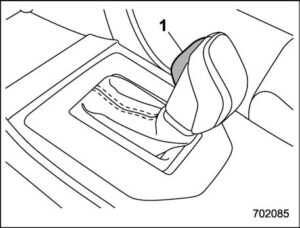
- Select lever button
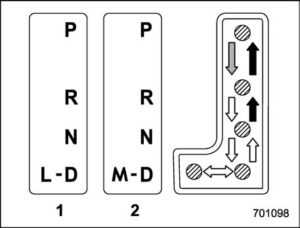
- Models with “L” position
- Models with manual mode
With the brake pedal depressed, shift while pressing the select lever button in.
- Shift while pressing the select lever button in.
- Shift without pressing the select lever button.
The select lever has four positions, “P”, “R”, “N”, “D” and it also has an “L” or “M” gate.
NOTE
For some models, to protect the engine while the select lever is in the “P” or “N” position, the engine is controlled so that the engine speed may not become too high even if the accelerator pedal is depressed hard.
P (Park)
This position is for parking the vehicle and starting the engine. In this position, the transmission is mechanically locked to prevent the vehicle from rolling freely. When you park the vehicle, first apply the parking brake firmly, then shift into the “P” position. Do not hold the vehicle with only the mechanical friction of the transmission. To shift the select lever from the “P” position to any other position, you should depress the brake pedal fully then move the select lever. This prevents the vehicle from lurching when it is started.
R (Reverse)
This position is for backing the vehicle. To shift from the “N” to “R” position, stop the vehicle completely then move the lever to the “R” position while pressing the select lever button in. When the ignition switch has been turned to the “ACC” position, the movement of the select lever from the “N” to the “R” position is only possible by depressing the brake pedal. For details, refer to “Shift lock function” P 7-29.
N (Neutral)
This position is for restarting a stalled engine. In this position, the transmission is neutral, meaning that the wheels and transmission are not locked. Therefore, the vehicle will roll freely, even on the slightest incline unless the parking brake or foot brake is applied. Avoid coasting with the transmission in neutral. Engine braking has no effect in this condition.
WARNING
Do not drive the vehicle with the select lever in the “N” (neutral) position. Engine braking has no effect in this condition and the risk of an accident is consequently increased.
Read all Instructions for Continuously Variable Transmission Base Sedan User Guide
Subaru Impreza 2023 Power Steering Base Sedan User Guide
Power Steering
Power steering warning light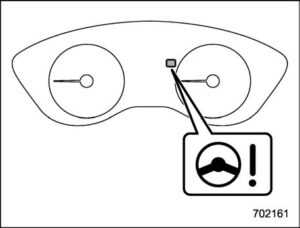
Power steering system features
The vehicle is equipped with an electric power steering system. When the ignition switch is turned to the “ON” position, the power steering warning light on the com-bination meter illuminates to inform the driver that the warning system is functioning properly. Then, if the engine started, the warning light turns off to inform the driver that the steering power assist is operational.
CAUTION
When the power steering warning light is illuminated, there may be more resistance when the steering wheel is operated. Drive carefully to the nearest SUBARU dealer and have the vehicle inspected immediately.
NOTE
If the steering wheel is operated in the following ways, the power steering control system may temporarily limit the power assist in order to prevent the system components, such as the control computer and drive motor, from overheating.
- The steering wheel is operated frequently and turned sharply while the vehicle is maneuvered at extremely low speeds, such as while frequently turning the steering wheel during parallel parking.
- The steering wheel remains in the fully turned position for a long period of time. At this time, there will be more resistance when steering. However this is not a malfunction. Normal steering force will be restored after the steering wheel is not operated for a while and the power steering control system has an opportunity to cool down. However, if the power steering is operated in a non-standard way which causes power assist limitation to occur too frequently, this may result in a malfunction of the power steering control system.
Braking
Braking tips
WARNING
Never rest your foot on the brake pedal while driving. This can cause dangerous overheating of the brakes and needless wear on the brake pads and linings.
When the brakes get wet
When driving in rain or after washing the vehicle, the brakes may get wet. As a result, brake stopping distance will be longer. To dry the brakes, drive the vehicle at a safe speed while lightly depressing the brake pedal to heat up the brakes.
Use of engine braking
Remember to make use of engine braking in addition to foot braking. When descending a grade, if only the foot brake is used, the brakes may start working improperly because of brake fluid overheating, caused by overheated brake pads. To help prevent this, shift into a lower gear to get stronger engine braking.
Braking when a tire is punctured
Do not depress the brake pedal suddenly when a tire is punctured. This could cause a loss of control of the vehicle. Keep driving straight ahead while gradually reducing speed. Then slowly pull off the road to a safe location.
Brake system
Two separate circuits
Your vehicle has two separate circuit brake systems. Each circuit works diagonally across the vehicle. If one circuit of the brake system should fail, the other half of the system still works. If one circuit fails, the brake pedal will go down much closer to the floor than usual and you will need to press it down much harder. And a much longer distance will be needed to stop the vehicle.
Brake booster
The brake booster uses an engine manifold vacuum and a vacuum pump to assist braking force. Do not turn off the engine while driving because that will turn off the brake booster, resulting in poor braking power. The brakes will continue to work even when the brake booster completely stops functioning. If this happens, you will have to depress the pedal much harder than during normal braking, and the braking distance will increase.
Supplemental booster function when vacuum pressure fails
While the ignition switch is turned “ON” and the engine is running, the supple-mental booster function operates when the brake booster performance is decreased due to insufficient vacuum boost. When the brake pedal is depressed while the supplemental booster function is operating, an operation sound and brake pedal vibration may be generated. This is not a malfunction.
Brake assist system
WARNING
Do not be overconfident about the brake assist. It is not a system that brings more braking ability to the vehicle beyond its braking capability. Always use the utmost care when driving regarding vehicle speed and safe distance.
CAUTION
When you need to brake suddenly, continue depressing the brake pedal strongly to bring the effect of the brake assist. Brake assist is a driver assistance system. It assists the brake power when the driver cannot depress the brake pedal strongly and the brake power is insufficient. Brake assist generates the brake power according to the speed at which the driver depresses the brake pedal.
NOTE
When you depress the brake pedal strongly or suddenly, the following phenomena occur. However, even though these occur, they do not indicate any malfunctions, and the brake assist system is operating properly.
- You might feel that the brake pedal is applied by lighter force and generates a greater braking force.
- You might hear an ABS operating noise from the engine compartment.
Disc brake pad wear warning indicators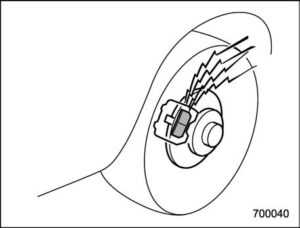
The disc brake pad wear warning indicators on the disc brakes give a warning noise when the brake pads are worn.
If a squeaking or scraping noise is heard from the disc brakes while braking, immediately have your vehicle checked by your SUBARU dealer.
ABS (Anti-lock Brake System)
The ABS prevents the lock-up of wheels which may occur during sudden braking or braking on slippery road surfaces. This helps prevent the loss of steering control and directional stability caused by wheel lock-up. When the ABS is operating, you may hear a chattering noise or feel a slight vibration in the brake pedal. This is normal when the ABS operates. The ABS will not operate when the vehicle speed is below approximately 6 mph (10 km/h).
Read all Instructions for Power Steering Base Sedan User Guide
Subaru Impreza 2023 Vehicle Dynamics Control Base Sedan User Guide
Vehicle Dynamics Control system
Safety precautions
WARNING
Always use the utmost care in driving – overconfidence because you are driving a vehicle with the Vehicle Dynamics Control system could easily lead to a serious accident.
CAUTION
- Even if your vehicle is equipped with the Vehicle Dynamics Control system, winter tires should be used when driving on snow covered or icy roads; in addition, vehicle speed should be reduced considerably. Simply having a Vehicle Dynamics Control system does not guarantee that the vehicle will be able to avoid accidents in any situation.
- Activation of the Vehicle Dynamics Control system is an indication that the road on which the vehicle is traveling has a slippery surface; since having Vehicle Dynamics Control is no guarantee that full vehicle control will be maintained at all times and under all conditions, its activation should be seen as a sign that the speed of the vehicle should be reduced considerably.
- Whenever suspension components, steering components, or an axle are removed from a vehicle, have an inspection of that system performed by an authorized SUBARU dealer.
- The following precautions should be observed in order to ensure that the Vehicle Dynamics Control system is operating properly:
- All four wheels should be fitted with tires of the same size, type, and brand. Furthermore, the amount of wear should be the same for all four tires.
- Keep the tire pressure at the proper level as shown on the vehicle placard attached to the driver’s side door pillar.
- Use only the specified temporary spare tire to replace a flat tire. With a temporary spare tire, the effectiveness of the Vehicle Dynamics Control system is reduced and this should be taken into account when driving the vehicle in such a condition.
- If non-matching tires are used, . If non-matching tires are used,
- The Vehicle Dynamics Control system helps prevent unstable vehicle motion such as skidding using control of the brakes and engine power. Do not turn off the Vehicle Dynamics Control system unless it is absolutely necessary. If you must turn off the Vehicle Dynamics Control system, drive very carefully according to the road surface conditions.
System features
In the event of wheelspin and/or skidding on a slippery road surface and/or during cornering and/or an evasive maneuver, the Vehicle Dynamics Control system adjusts the engine’s output and the wheels’ respective braking forces to help maintain traction and directional control.
- Traction Control Function
The traction control function is designed to prevent the spinning of the driving wheels on slippery road surfaces, thereby helping to maintain traction and directional control. Activation of this function is shown by flashing the Vehicle Dynamics Control operation indicator light.
Skid Suppression Function
The skid suppression function is designed to help maintain directional stability by suppressing the wheels’ tendency to slide sideways during steering operations. Activation of this function is shown by flashing the Vehicle Dynamics Control operation indicator light.
NOTE
-
- The Vehicle Dynamics Control system may be considered normal when the following conditions occur.
- Slight twitching of the brake pedal is felt.
The vehicle or steering wheel shakes to a small degree. - An operating sound from the engine compartment is heard briefly when starting the engine and when driving off after starting the engine.
- The brake pedal seems to jolt when driving off after starting the engine.
- In the circumstances shown in the following list, the vehicle may be less stable than it feels to the driver. The Vehicle Dynamics Control system may therefore operate. Such an operation does not indicate a system malfunction.
- On gravel-covered or rutted roads
- On unfinished roads
- When the vehicle is towing a trailer
- When the vehicle is fitted with snow tires or winter tires.
- Activation of the Vehicle Dynamics Control system will cause the operation of the steering wheel to feel slightly different compared to that for normal conditions.
- It is always important to reduce speed when approaching a corner, even if your vehicle is equipped with the Vehicle Dynamics Control system.
- Always turn off the engine before replacing a tire. Failure to do so may render the Vehicle Dynamics Control system unable to operate correctly.
Vehicle Dynamics Control system monitor
Refer to “Vehicle Dynamics Control warning light/Vehicle Dynamics Control operation indicator light” �P 3-23 and “Vehicle
Dynamics Control OFF indicator light”�P 3-24.
Vehicle Dynamics Control OFF switch
Vehicle Dynamics Control OFF switch
Press or turn the Vehicle Dynamics Control OFF switch to deactivate the Vehicle Dynamics Control system. Creating adequate driving wheel slips by deactivating the Vehicle Dynamics Control system may help to recover from the loss of traction. Use the Vehicle Dynamics Control OFF switch as necessary.
- A standing start on a steeply sloping road with a snowy, gravel-covered, or otherwise slippery surface
- Extrication of the vehicle when its wheels are stuck in mud or deep snow
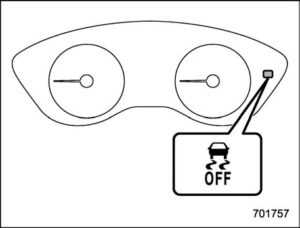
Vehicle Dynamics Control OFF indicator light
When the switch is pressed or turned during engine operation, the Vehicle Dynamics Control OFF indicator light on the combination meter illuminates. The Vehicle Dynamics Control system will be deactivated and the vehicle will behave like a model not equipped with the Vehicle Dynamics Control system. When the switch is pressed again (type A) or turned to the “NORMAL” side (type B) to reactivate the Vehicle Dynamics Control system, the Vehicle Dynamics Control OFF indicator light turns off.
With the Vehicle Dynamics Control system deactivated, traction and stability enhancement offered by the Vehicle Dynamics Control system is unavailable. Therefore, you should not deactivate the Vehicle Dynamics Control system except under the above-mentioned situations.
NOTE
- When the switch has been pressed (type A) or turned (type B) to deactivate the Vehicle Dynamics Control system, the Vehicle Dynamics Control system automatically reactivates itself the next time the ignition switch is turned to the “LOCK”/ “OFF” position and the engine is restarted.
- If the switch is pressed (type A) or turned (type B) and held for 30 seconds or longer, the indicator light turns off, the Vehicle Dynamics Control system is activated, and the system ignores any further pressing of the switch. To make the switch usable again, turn the ignition switch to the “LOCK”/“OFF” position and restart the engine.
- When the switch is pressed (type A) or turned (type B) to deactivate the Vehicle Dynamics Control system, the vehicle’s running performance is comparable to that of a vehicle that does not have a Vehicle Dynamics Control system. Do not deactivate the Vehicle Dynamics Control system except when absolutely necessary.
- Even when the Vehicle Dynamics Control system is deactivated, components of the brake control system may still activate. When the brake control system is activated, the Vehicle Dynamics Control operation indicator light flashes.
Tire pressure monitoring system (TPMS) (U.S.-spec. models)
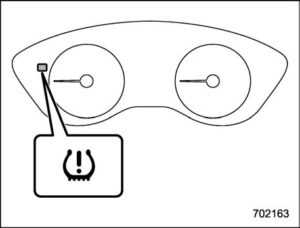
Low tire pressure warning light
The tire pressure monitoring system provides the driver with a warning message when tire pressure is severely low.
The tire pressure monitoring system will activate only when the vehicle is driven at speeds above 20 mph (32 km/h). Also, this system may not react immediately to a sudden drop in tire pressure (for example, a blow-out caused by running over a sharp object).
WARNING
- If the low tire pressure warning light illuminates while driving, never brake suddenly. Instead, perform the following procedure.
Otherwise, an accident involving serious vehicle damage and serious personal injury could occur.
- Keep driving straight ahead while gradually reducing speed.
- Slowly pull off the road to a safe location.
- Check the pressure for all four tires and adjust the pressure to the COLD tire pressure shown on the tire inflation pressure label. The tire inflation pressure label is located on the door pillar on the driver’s side.
Even when the vehicle is driven a very short distance, the tires get warm and their pressures increase accordingly. Be sure to
let the tires cool thoroughly before adjusting their pressures to the standard values shown on the tire inflation pressure label. Refer to “Tires and wheels” �11-21 The tire pressure monitoring system
does not function when the vehicle is stationary. After adjusting the tire pressures, increase the vehicle speed to at least 20 mph (32 km/h) to start the TPMS rechecking of the tire inflation pressures. If the tire pressures are now above the severe low-pressure threshold, the low tire pressure warning light should turn off a few minutes later.
If this light still illuminates while driving after adjusting the tire pressure, a tire may have significant damage and a fast leak that causes the tire to lose air rapidly.
If you have a flat tire, replace it with a spare tire as soon as possible. - When a spare tire is mounted or a wheel rim is replaced without the original pressure sensor/transmitter being transferred, the low tire pressure warning light will illuminate steadily after blinking for approximately one minute.
This indicates the TPMS is unable to monitor all four road wheels.
Contact your SUBARU dealer as soon as possible for tire and sensor replacement and/or system resetting. - When a tire is repaired with liquid sealant, the tire pressure warning valve and transmitter may not operate properly. If a liquid sealant is used, contact your nearest SUBARU dealer or another qualified service shop as soon as possible.
Make sure to replace the tire pressure warning valve and transmitter when replacing the tire. You may reuse the wheel if there is no damage to it and if the sealant residue is properly cleaned off. Do not inject any tire liquid or aerosol tire sealant into the tires, as this may cause a malfunction of the tire pressure sensors. If the light illuminates steadily after blinking for app proximately one a minute, promptly contact a SUBARU dealer to have the system inspected.
Read all Instructions for Vehicle Dynamics Control Base Sedan User Guide
Subaru Impreza 2023 Cruise control Base Sedan User Guide
Cruise control (if equipped)
NOTE
For models with the EyeSight system: Refer to the Owner’s Manual supplement Cruise control enables you to maintain a constant vehicle speed without holding your foot on the accelerator pedal and it is operative when the vehicle speed is 20 mph (30 km/h) or more.
WARNING
Do not use the cruise control under any of the following conditions. These may cause loss of vehicle control.
- Driving up or down a steep grade
- Driving on slippery or winding roads
- Driving in heavy traffic
- When using the cruise control, always set the speed appropriately according to the speed limit, traffic flow, road conditions, and other conditions.
NOTE
Make sure the cruise control system is turned off when the cruise control is not in use to avoid unintentionally setting of the cruise control.
To set the cruise control
Cruise control main button
- Press the cruise control main button.

The cruise control indicator light on the combination meter will illuminate Depress the accelerator pedal until the vehicle reaches the desired speed.
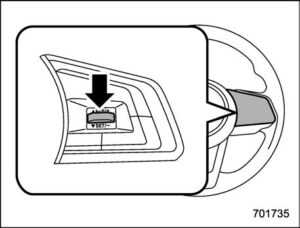
Press the “RES/SET” switch to the “SET” side and release it. Then release the accelerator pedal.
NOTE
When setting a cruise speed for the first time during a drive, both “SET” and “RES” may be used to set the initial cruise speed.
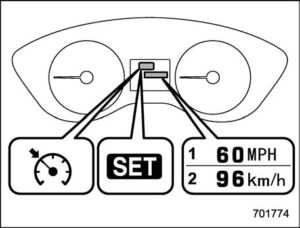
Cruise control set indicator light (type A)
- When setting the displayed unit as “MPH”
- When setting the displayed unit as “km/h”
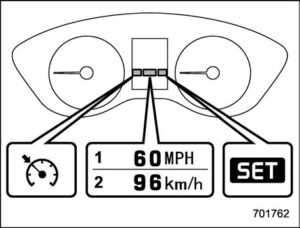
Cruise control set indicator light (type B)
- When setting the displayed unit as “MPH”
- When setting the displayed unit as “km/h”
At this time, the cruise control set indicator light is illuminated in the combination meter. The set speed will be shown on the combination meter. You can change the displayed unit by operating the combination meter display.
- For type A meter details, refer to “Combination meter settings” P 3-11.
- For type B meter details, refer to “Screen Settings” P 3-38
- The vehicle will maintain the desired speed.
- Vehicle speed can be temporarily increased while driving with the cruise control activated. Simply depress the accelerator pedal to accelerate the vehicle. When the accelerator pedal is released, the vehicle will return to and maintain the previous cruising speed.
To temporarily cancel the cruise control
The cruise control can be temporarily canceled in the following ways.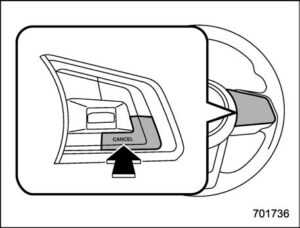
- Press the “CANCEL” button.
- Depress the brake pedal.
- Depress the clutch pedal (MT models only).
WARNING
For CVT models, you can cancel the cruise control by shifting the select lever into the “N” position. However, do not shift the lever into the “N” position while driving except in case of an emergency. If the select lever is shifted into the “N” position, the engine brake will no longer work. This could result in an accident. cruise control is canceled. The cruise control set indicator light in the combination meter turns off when the cruise control is canceled.
To resume the cruise control after it has been temporarily canceled and with a vehicle speed of approximately 20 mph (30 km/h) or more, press the “RES/SET” switch to the “RES” side to return to the original cruising speed automatically. The cruise control set indicator light in the combination meter will automatically illuminate at this time.
Read all Instructions for Cruise control Base Sedan User Guide
Subaru Impreza 2023 Rear View Camera Base Sedan User Guide
Rear Cross Traffic Alert (RCTA)
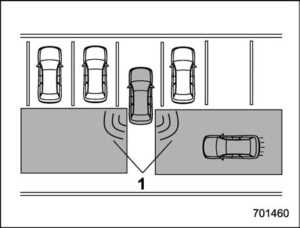
Operating range
The system notifies the driver of another vehicle approaching from either side when driving in reverse. This feature helps the driver check the rear and side areas of the vehicle when moving backward.
If the system detects a vehicle approaching from either side while moving backward, it warns the driver of dangers in the following way.
- The BSD/RCTA approach indicator light(s) on the outside mirror(s) flashes.
- A warning buzzer sounds.
- An icon appears on the rear view camera screen (audio/navigation monitor)
Limitations of the detectability of RCTA
Since the detectability of RCTA is limited, the RCTA may not operate properly in angled parking.
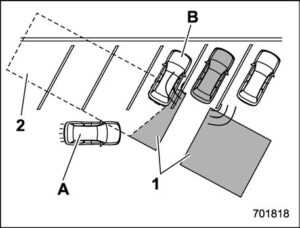
Example 1
- The detection range of the radar sensors
- Area out of detection range of the radar sensors
- Vehicle that may not be detected.
- Parked vehicle
WARNING
An approaching vehicle (A) may not be detected because the detection range is limited by the parked vehicle (B). Always be sure to check the surroundings when reversing the vehicle.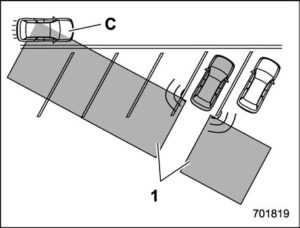
Example 2
- The detection range of the radar sensors
- Vehicle that may be detected
NOTE
The system may detect that a vehicle (C) is passing in front of your vehicle. Always be sure to check the surroundings when reversing the vehicle.
System operation
Operating conditions
The BSD/RCTA will operate when all of the following conditions are met.
- The BSD/RCTA will operate when all of the following conditions are met.
- The ignition switch is in the “ON” position.
- The BSD/RCTA warning light and BSD/ RCTA OFF indicator light are turned off. . The EyeSight warning indicator is off. . The vehicle is driven at speeds above 7 mph (12 km/h) (except when reversing).
- The select lever is in the “R” position (when reversing).
- The BSD/RCTA will not operate in the following situations.
- The BSD/RCTA OFF indicator light is on.
- The vehicle speed is below 6 mph (10 km/h) even when the BSD/RCTA OFF indicator light remains off (except when reversing).
NOTE
- In the following case, the BSD/RCTA will stop operating and the BSD/RCTA warning light will appear. If the BSD/RCTA warning light appears, have your vehicle inspected at a SUBARU dealer as soon as possible.
- When a malfunction occurs in the system, including the BSD/RCTA approach indicator light.
- In the following cases, the BSD/ RCTA will temporarily stop operating (or may stop operating) and the BSD/RCTA OFF indicator light will appear.
- When the radar sensor becomes significantly misaligned (If the orientation of the radar sensor is shifted for any reason, readjustment is required. Have the sensor adjusted at a SUBARU dealer.)
- When a large amount of snow or ice sticks to the rear bumper surface around the radar sensors.
- When the vehicle is driven on a snow-covered road or in an environment in which there are no objects around (such as in a desert) for a long time.
- When the temperature around the radar sensors increased excessively due to long driving on uphill grades in summer, etc.
- When the temperature around the radar sensors becomes extremely low.
- When the vehicle battery voltage lowers.
- When an overvoltage occurs in the vehicle battery.
- When the above conditions are corrected, the BSD/RCTA will resume operation and the BSD/RCTA OFF indicator light will disappear. How-ever, if the BSD/RCTA OFF indicator light has appeared for a prolonged time, have the system inspected at a SUBARU dealer as soon as possible.
- The detectability of the radar sensors is restricted. The BSD/RCTA detection may be impaired and the system may not operate properly under the following conditions.
- When the rear bumper around the radar sensors is distorted.
- When ice, snow or mud adheres to the rear bumper surface around the radar sensors.
- When stickers, etc. are affixed on the areas of the radar sensors on the rear bumper.
- During adverse weather conditions such as rain, snow or fog
- When driving on wet roads such as snow-covered roads or through puddles
- The radar sensors may not detect or may have difficulty detecting the following.
- Small motorcycles, bicycles, pedestrians, stationary objects on the road or roadside, etc.
- Vehicles with body shapes that the radar may not reflect (vehicles with a low body height such as sports cars or a trailer with no cargo).
- Vehicles that are not approaching your vehicle even though they are in the detection area (either on a neighboring lane to the rear or beside your vehicle when reversing). (The system deter-mines the presence of approaching vehicles based on data detected by the radar sensors.)
- Vehicles traveling at significantly different speeds
- Vehicles driving parallel to your vehicle at almost the same speed for a prolonged time
- Oncoming vehicles
- Vehicles in a lane beyond the neighboring lane
- Vehicles travelling at a significantly lower speed that you are trying to overtake
- On a road with extremely narrow lanes, the system may detect vehicles driving in a lane next to the neighboring lane.
- When the 8-inch audio/navigation system is performing a software update, the RCTA warning icons may not be displayed on the audio/navigation screen until the update is complete.
BSD/RCTA approach indicator light/warning buzzer
When the BSD/RCTA is active, the BSD/RCTA approach indicator light will operate to alert the driver when there are vehicles in the neighboring lanes. When reversing the vehicle, the BSD/RCTA approach indicator light and warning buzzer will operate to alert the driver that a vehicle is approaching from the left or right side.
BSD/RCTA approach indicator light
BSD/RCTA approach indicator light
It is mounted in each side of the outside mirrors.
The indicator light will illuminate when a vehicle approaching from behind is detected. The indicator light will flash to warn the driver of dangers under the following conditions.
While the indicator light illuminates, if you operate the turn signal lever toward the side in which this light turned on.
When reversing the vehicle while the system detects a vehicle approaching from either side.
BSD/RCTA approach indicator light dimming function When the headlights are turned on, the brightness of the BSD/RCTA approach indicator light will be reduced.
NOTE
You may have difficulty recognizing the BSD/RCTA approach indicator light under the following conditions.
-
- When affected by direct sunlight
- When affected by the headlight beams from the vehicles behind
- While the illumination brightness control dial is in the fully upward position, even if the headlights are turned on, the brightness of the BSD/RCTA approach indicator light will not be reduced. For details about the illumination brightness control dial, refer to “Illumination bright-ness control” 3-12..
Read all Instructions for Rear View Camera Base Sedan User Guide
Subaru Impreza 2023 Reverse Automatic Braking Base Sedan User Guide
Reverse Automatic Braking (RAB) System (If Equipped)
Reverse Automatic Braking (RAB) is a system designed to help avoid collisions or reduce collision damage when reversing the vehicle. If a wall or an obstacle is detected in the reversing direction, the system will notify the driver with a warning sound and may activate the vehicle’s brakes automatically.
WARNING
- Reverse Automatic Braking (RAB) is not a system intended to replace the driver’s responsibility to check their surroundings for vehicles or obstacles to avoid a collision.
- The driver is responsible for driving safely. Before reversing, be sure to first depress the brake pedal and visually check the surroundings.
- There are some cases in which the vehicle cannot avoid collision, because the system operation has limitations. The warning sound or automatic braking may be delayed or may not operate at all even when an obstacle is present.
- Make sure to set the Automatic Braking function to OFF when the vehicle is on the free roller or on the chassis dynamometer. Other-wise, the vehicle may move and it may cause an accident.
- Make sure to set the Automatic Braking function to OFF when towing a trailer. Otherwise, the vehicle may move and it may cause an accident.
- The system is not designed to detect people (including children), animals or other moving objects.
- Depending on the vehicle condition or the surrounding environment, the sonar sensor’s ability to detect objects may become unstable.
NOTE
The Reverse Automatic Braking (RAB) system records and stores the following data when automatic braking operates. It does not record conversations, personal information or other audio
Data.
- Distance from the object
- Vehicle speed
- Accelerator pedal operation status . Brake pedal operation status
- Select lever position
- Outside temperature
- The sensitivity setting of the sonar sensors
SUBARU and third parties contracted by SUBARU may acquire and use the recorded data for the purpose of vehicle research and development. SUBARU and third parties contracted by SUBARU will not disclose or provide the acquired data to any other third party except under the following con-ditions. - The vehicle owner has given his/her consent.
- The disclosure/provision is based on a court order or other legally enforceable request.
- Data that has been modified so that the user and vehicle cannot be identified is provided to a research institution for statistical processing or similar purposes.
Reverse Automatic Braking (RAB) System Overview
The Reverse Automatic Braking (RAB) system will operate the following 2 functions using 4 sonar sensors.
- Sonar Audible Alarm function
The Reverse Automatic Braking (RAB) system detects objects rearward and warns the driver by warning message on the center information display and warning beeps. - Automatic Braking function
The Automatic Braking function detects objects rearward and if there is a high risk of a collision, the system decelerates the vehicle and controls the braking to reduce damage.

- When reversing
- When either strong automatic braking or torque control is applied to prevent collision (in this case, short warning beeps or continuous warning beeps will sound)
- When the vehicle is stopped by the system (in this case, the continuous beep will remain sounding)
- Object (e.g., a wall)
Detecting range
- Detecting range (width): Approximately 6 in (15 cm) outside of the vehicle width
- The range that the system cannot detect: Approximately 20 in (50 cm) behind the rear of the vehicle
- Detecting range (length): Approximately 5 ft (1.5 m) from the rear of the vehicle
WARNING
If your vehicle is trapped on a railroad crossing and you are trying to escape by reversing through the crossing gate, the system may recognize the crossing gate as an obstacle and the brake may activate. In this case, remain calm and either continue to depress the accelerator pedal or cancel the system. To cancel the system, refer to “Canceling the Reverse Automatic Braking (RAB) System Operation” P 7-69.
Operating Conditions
The Reverse Automatic Braking (RAB) system will operate when all of the following conditions are met.
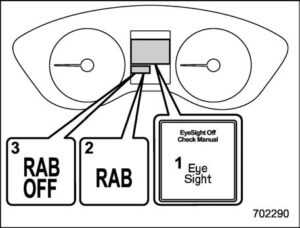
- EyeSight warning indicator
- RAB warning indicator
- RAB OFF indicator
- The ignition switch is in the “ON” position.
- The EyeSight warning indicator is off. . The RAB warning indicator is off.
- The RAB OFF indicator is off.
- The select lever is in the “R” position. Sonar Audible Alarm function
- The Sonar Audible Alarm is set to “ON” . The vehicle speed is from 0 to 9 mph (0 to 15 km/h).
Automatic Braking function - The Automatic Braking is set to “ON”. The vehicle speed is from 1 to 9 mph (1.5 to 15 km/h).
NOTE
- In the following cases, the Reverse Automatic Braking (RAB) system will not operate. Promptly contact a SUBARU dealer to have the system inspected.
- The EyeSight warning indicator is illuminated.
- The RAB warning indicator is illuminated.
- In the following cases, the Reverse Automatic Braking (RAB) system cannot be operated.
- The (EyeSight Temporary Stop indicator: White) is illuminated, and the messages corresponding to the EyeSight temporary stop are dis-played on the combination meter display (color LCD). For details, refer to the Owner’s Manual supplement for the EyeSight system.
- The RAB OFF indicator is illuminated.
- In the following cases, the functions may not be able to properly work. Promptly contact a SUBARU dealer to have the system inspected.
- A sticker, paint, or a chemical is applied to the sonar sensors or the rear bumper near the sonar sensor.
- The rear bumper is modified.
- The rear bumper has been re-moved and attached.
- The ground clearance is changed due to the vehicle’s loading condition or modification.
- There is damage to the sonar sensors or the rear bumper near the sonar sensor.
- The rear bumper is exposed to strong impact, or the rear bumper is deformed.
- On a steep hill, the system’s automatic braking ability will be reduced. . The system is designed to avoid collisions by automatic hard braking when the vehicle’s reversing speed is less than approximately 3 mph (5 km/h). However, the system does not guaran-tee that the vehicle will be able to avoid collisions in any situation.
- If the vehicle is reversed at an extremely slow speed, the driver’s operation may be prioritized. In this branch or railroad crossing bars are present in the reversing direction.
- When reversing on a gravel or grassy area.
- When reversing in an area where objects or walls are adjacent to the vehicle such as narrow tunnels, narrow bridges, narrow roads or narrow garages.
- Wheel track or hole is present in the ground of the reversing direction.
- When reversing over a drainage cover (grating cover).
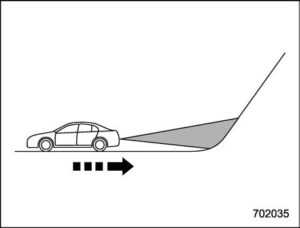
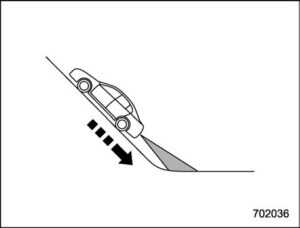
-
- The path of the reversing direction is inclined such as on a steep uphill.
- When reversing downhill.

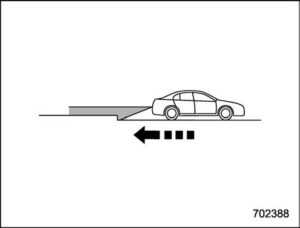
-
- Reversing in a garage with a low ceiling or a tunnel.
- There is a patch of snow rear-ward.
- There is a puddle of water.
- There is an obstacle that is next to an object.
- Going back along a wall.
- The area where the road starts touching dirt and snow
- When reversing on an uneven road.
- In circumstances such as the following, it may not be possible to avoid a collision even when the system operates normally.
- Roads are slippery.
- The tire air pressure is not cor-rect.
- The tires have become worn.
- Tire chains are installed.
- Tires which are not the designated size are installed.
- Emergency repairs were performed using a puncture repair kit.
- The suspension was modified.
- Vehicle driving is unstable due to accident or malfunction.
- The brake warning light is illuminated.
Read all Instructions for Reverse Automatic Braking Base Sedan User Guide
Subaru Impreza 2023 New vehicle break-in driving Base Sedan User Guide
https://autouserguide.com/subaru/impreza/subaru-impreza-2023-new-vehicle-break-in-driving-base-sedan-user-guide/
New vehicle break-in driving – the first 1,000 miles (1,600 km)
The performance and long life of your vehicle are dependent on how you handle and care for your vehicle while it is new. Follow these instructions during the first 1,000 miles (1,600 km):
- Do not race the engine. And do not allow engine speed to exceed 4,000 rpm except in an emergency.
- Do not drive at one constant engine or vehicle speed, either fast or slow.
- Avoid starting suddenly and rapid acceleration, except in an emergency.
- Avoid hard braking, except in an emergency.
- The same break-in procedures should be applied to an overhauled engine, newly mounted engine or when brake pads are replaced with new ones.
Fuel economy hints
The following suggestions will help to save your fuel.
- Select the proper gear position for the speed and road conditions.
- Avoid sudden acceleration or deceleration. Always accelerate gently until you reach the desired speed. Then try to maintain that speed for as long as possible.
- Do not pump the accelerator and avoid racing the engine.
- Avoid unnecessary engine idling.
- Keep the engine properly tuned.
- Keep the tires inflated to the correct pressure shown on the tire inflation pressure label, which is located under the door latch on the driver’s side. Low pressure will increase tire wear and fuel consumption.
- Use the air conditioner only when necessary.
- Keep the front and rear wheels in proper alignment.
- Avoid carrying unnecessary luggage or cargo.
Engine exhaust gas (carbon monoxide)
- Never inhale engine exhaust gas. Engine exhaust gas contains carbon monoxide, a colorless and odorless gas which is dangerous, or even lethal, if inhaled.
- Always properly maintain the engine exhaust system to prevent engine exhaust gas from entering the vehicle.
- Never run the engine in a closed space, such as a garage, except for the brief time needed to drive the vehicle in or out of it.
- Avoid remaining in a parked vehicle for a lengthy time while the engine is running. If that is unavoidable, then use the ventilation fan to force fresh air into the vehicle.
- Always keep the front ventilator inlet grille free from snow, leaves or other obstructions to ensure that the ventilation system always works properly.
- If at any time you suspect that exhaust fumes are entering the vehicle, have the problem checked and corrected as soon
as possible. If you must drive under these conditions, drive only with all windows fully open. - Keep the rear gate closed while driving to prevent exhaust gas from entering the vehicle.
NOTE
Due to the expansion and contraction of the metals used in the manufacture of the exhaust system, you may hear a crackling sound coming from the exhaust system for a short time after the engine has been shut off. This sound is normal.
Catalytic converter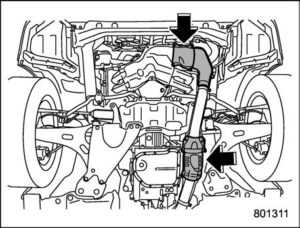
The catalytic converter is installed in the exhaust system. It serves as a catalyst to reduce HC, CO and NOx in exhaust gases, thus providing cleaner exhaust.
To avoid damage to the catalytic converter:
- Use only unleaded fuel. Even a small amount of leaded fuel will damage the catalytic converter.
- Never start the engine by pushing or pulling the vehicle.
- Avoid racing the engine.
- Never turn the ignition switch to the “OFF” position while the vehicle is moving.
- Keep your engine tuned up. If you feel backfiring or incomplete combustion), have your vehicle checked and repaired by an authorized SUBARU dealer.
- Do not apply undercoating or rust-prevention treatment to the heat shield of the catalytic converter and the exhaust system.
- Do not drive with an extremely low fuel level.
WARNING
- Avoid fire hazards. Do not drive or park the vehicle anywhere near flammable materials (e.g., grass, paper, rags or leaves),
because the catalytic converter operates at very high temperatures. - Keep everyone and flammable materials away from the exhaust pipe while the engine is running. The exhaust gas is very hot.
Periodic inspections
To keep your vehicle in the best condition at all times, always have the recommended maintenance services listed in the maintenance schedule in the “Warranty and Maintenance Booklet” performed at the specified time or mileage intervals.
Driving in foreign countries
When planning to use your vehicle in another country:
- Confirm the availability of the correct fuel. Refer to “Fuel requirements” P299.
- Comply with all regulations and requirements of each country
Driving tips for AWD models
WARNING
- Always maintain a safe driving speed according to the road and weather conditions in order to avoid having an accident on a
sharp turn, during sudden braking or under other similar conditions. - Always use the utmost care in driving – overconfidence because you are driving an All- Wheel Drive vehicle could easily lead to a serious accident.
- When replacing or installing tire(s), all four tires must be the same for following items.
- Size
- Speed symbol
- Load index
- Circumference
- Construction
- Manufacturer
- Brand (tread pattern)
- Degrees of wear
- For the items (a) to (c), you must obey the specification that is printed on the tire inflation pressure label. The tire inflation pressure
label is located on the driver’s door pillar. If all the four tires are not the same for items (a) to (h), serious mechanical damage could be caused to the drivetrain of the car, and affect the followings.- Ride
- Handling
- Braking
- Speedometer/Odometer calibration
Clearance between the body and tires It also may be dangerous and lead to loss of vehicle control, and it can lead to an accident.
CAUTION
If you use a temporary spare tire to replace a flat tire, be sure to use the original temporary spare tire stored in the vehicle. Using other sizes may result in severe mechanical damage to the drivetrain of your vehicle.
Read all Instructions for New vehicle break-in driving Base Sedan User Guide
Subaru Impreza 2023 Winter driving Base Sedan User Guide
Winter driving
Operation during cold weather
Maintenance
Carry some emergency equipment, such as a window scraper, a bag of sand, flares, a small shovel and jumper cables.
Check the battery and cables. Cold temperatures reduce battery capacity. The battery must be in good condition to provide enough power for cold winter starts.
It normally takes longer to start the engine in very cold weather conditions. Use an engine oil of a proper grade and viscosity for cold weather. Using heavy summer oil will make it harder to start the engine. Keep the door locks from freezing by squirting them with deicer or glycerin.
Forcing a frozen door open may damage or separate the rubber weather strips around the door. If the door is frozen, use hot water to melt the ice, and afterward thoroughly wipe the water away.
Use a windshield washer fluid that contains an antifreeze solution. Do not use engine antifreeze or other substitutes because they may damage the paint of the vehicle. If you fill the reservoir tank with a fluid with a different concentration from the one used previously, purge the old fluid from the piping between the reservoir tank and washer nozzles by operating the washer for a certain period of time. Otherwise, if the concentration of the fluid remaining in the piping is too low for the outside temperature, it may freeze and block the nozzles.
CAUTION
Adjust the washer fluid concentration appropriately for the out-side temperature. If the concentration is inappropriate, sprayed washer fluid may freeze on the windshield and obstruct your view, and the fluid may freeze in the reservoir tank.. State or local regulations on volatile organic compounds may restrict the use of methanol, a common windshield washer anti-freeze additive. Washer fluids containing non-methanol anti-freeze agents should be used only if they provide cold weather protection without damaging your vehicle’s paint, wiper blades or washer system.
Before driving your vehicle
Before entering the vehicle, remove any snow or ice from your shoes because that could make the pedals slippery and driving dangerous. While warming up the vehicle before driving, check that the accelerator pedal, brake pedal, and all other controls operate smoothly. Clear away ice and snow that has accumulated under the fenders to avoid making steering difficult. During severe winter driving, stop when and where it is safe to do so and check under the fenders periodically.
Parking in cold weather
WARNING
Snow can trap dangerous exhaust gases under your vehicle. Keep snow clear of the exhaust pipe and from around your vehicle if you park the vehicle in snow with the engine running.
CAUTION
- Do not use the parking brake when parking for long periods in cold weather since it could freeze in that position.
- When the vehicle is parked in When the vehicle has been left snow or when it snows, raise the wiper blades off the glass to prevent damage to them. parked after use on roads heavily covered with snow, or has been left parked during a snowstorm, icing may develop on the brake system, which could cause poor braking action. Check for snow or ice buildup on the suspension, disc brakes and brake hoses underneath the vehicle. If there is caked snow or ice, remove it, being careful not to damage the disc brakes, brake hoses or ABS harness. When parking for long periods in cold weather, you should observe the following tips. When parking for long periods in cold weather, you should observe the following tips. When parking for long periods in cold weather, you should observe the following tips.
Refueling in cold weather
To help prevent moisture from forming in the fuel system and the risk of its freezing, use of an antifreeze additive in the fuel tank is recommended during cold weather. Use only additives that are specifically designed for this purpose. When an anti-freeze additive is used, its effect lasts longer if the tank is refilled whenever the fuel level reaches half empty.
If your SUBARU is not going to be used for an extended period, it is best to have the fuel tank filled to capacity . Opening rear gate (models with power rear gate)
CAUTION
Before operating the power rear gate, check that there is no frost or snow between the power rear gate and the vehicle body. If you notice frost or snow etc. on the power rear gate, remove it. If you forcibly operate the power rear gate with frost or snow, it may cause a malfunction.
Driving on snowy and icy roads
To prevent skidding and slipping, avoid sudden braking, abrupt acceleration, high-speed driving, and sharp turning when driving on snowy or icy roads.
Always maintain ample distance between your vehicle and the vehicle ahead of you to avoid the need for sudden braking. To supplement the foot brake, use the engine brake effectively to control the vehicle’s speed. (Shift into a lower gear when necessary.)
Avoid shifting down abruptly. Such behavior can cause the wheels to lock, possibly leading to loss of vehicle control.
An anti-lock brake system (ABS) enhances your vehicle’s braking performance on snowy and icy roads. For information on braking on slippery surfaces, refer to “ABS (Anti-lock Brake System)” P 7-35 and “Vehicle Dynamics Control system” P 7-37.
WARNING
For models with cruise control:
Do not use the cruise control on slippery roads such as snowy or icy roads. This may cause loss of vehicle control.
CAUTION
Avoid prolonged continuous driving in snowstorms. Snow will enter the engine’s intake system and may hinder the airflow, which could result in engine shutdown or even breakdown.
Wiper operation when snowing
Before driving in cold weather, make sure the wiper blade rubbers are not frozen to the windshield or rear window.
If the wiper blade rubbers are frozen to the windshield or rear window, perform the following procedure.
- To thaw the windshield wiper blade rubbers, use the defroster with the airflow selection in “ ” and the temperature set for maximum warmth until the wiper blade rubbers are completely thawed. Refer to “Climate control” P 4-1.
- If your vehicle is equipped with a wiper deicer, use it. It is helpful to thaw the windshield wiper blade rubbers. Refer to “Defogger and deicer” P 3-87.
- To thaw the rear wiper blade rubber, use the rear window defogger. Refer to “Defogger and deicer” P 3-87.
When driving in snow, if frozen snow starts to stick on the surface of the windshield despite wiper operation, use the defroster with the airflow selection in “ ” and the temperature set for maximum warmth. After the windshield gets warmed enough to melt the frozen snow on it, wash it away using the windshield washer. Refer to “Windshield washer” P 3-76.
Snow stuck on the wiper arm prevents the wiper from working effectively. If snow is stuck on the wiper arm, pull off the road to a safe place, then remove it. If you stop the vehicle at road side, use the hazard warning flasher to alert other drivers. Refer to “Hazard warning flasher” P 3-8.
Driving on snowy and icy roads
To prevent skidding and slipping, avoid sudden braking, abrupt acceleration, high-speed driving, and sharp turning when driving on snowy or icy roads.
Always maintain ample distance between your vehicle and the vehicle ahead of you to avoid the need for sudden braking. To supplement the foot brake, use the engine brake effectively to control the vehicle speed. (Shift into a lower gear when necessary.)
Avoid shifting down abruptly. Such behavior can cause the wheels to lock, possibly leading to loss of vehicle control.
An anti-lock brake system (ABS) enhances your vehicle’s braking performance on snowy and icy roads. For information on braking on slippery sur-faces, refer to “ABS (Anti-lock Brake System)” and “Vehicle Dynamics Control system” .
WARNING
Do not use the cruise control on slippery roads such as snowy or icy roads. This may cause loss of vehicle control.
CAUTION
Avoid prolonged continuous driving in snowstorms. Snow will enter the engine’s intake system and may hinder the airflow, which could result in engine shutdown or even breakdown.
Read all Instructions for Winter driving Base Sedan User Guide
Subaru Impreza 2023 Loading vehicle and towing Base Sedan User Guide
Loading your vehicle
WARNING
- Never allow passengers to ride on a folded rear seatback in the cargo area. Doing so may result in serious injury.
- Never stack luggage or other cargo higher than the top of the seatback because it could tumble forward and injure passengers in the event of a sudden stop or accident. Keep luggage or cargo low, as close to the floor as possible.
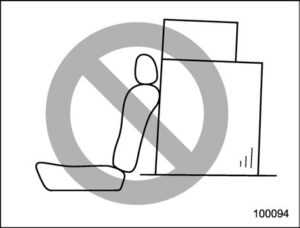
WARNING
- When you carry something inside the vehicle, secure it whenever you can to prevent it from being thrown around inside the vehicle during sudden stops, sharp turns or in an accident.
- Do not pile heavy loads on the roof. These loads raise the vehicle’s center of gravity and make it more prone to tip over. If the wheels are stuck, cut the steering wheel at a sharp angle may cause the steering components to be deformed. If you hear any abnormal noise while driving or if you notice any abnormalities due to rough running, contact a SUBARU dealer for an inspection as soon as possible.
- Avoid driving over curbs. Tires, wheels, suspensions, and the mechanical components under the vehicle body may be unnoticeably damaged by the impact of striking a curb or driving on a rough road. If driving over a curb is unavoidable, ride over it slowly and at a right angle to the curb. When parking your vehicle, make sure that the tires are not pressed against the curb.
- Do not drive for a long time while the vehicle is tilted to the left or right.
CAUTION
Do not carry spray cans, containers with flammable or corrosive liquids, or any other dangerous items inside the vehicle.
NOTE
For better fuel economy, do not carry unneeded cargo.
Vehicle capacity weight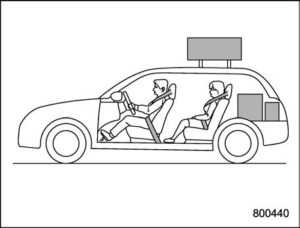

Vehicle placard
The load capacity of your vehicle is determined by weight, not by available cargo space. The maximum load you can carry in your vehicle is shown on the vehicle placard attached to the driver’s side door pillar. It includes the total weight of the driver and all passengers and their belongings, any optional equipment such as a trailer hitch, roof rack or bike carrier, etc., and the tongue load of a trailer.
GVWR and GAWR (Gross Vehicle Weight Rating and Gross Axle Weight Rating)
Certification label
The certification label attached to the bottom of driver’s side door pillar shows GVWR (Gross Vehicle Weight Rating) and GAWR (Gross Axle Weight Rating). The GVW (Gross Vehicle Weight) must never exceed the GVWR. GVW is the combined total of weight of the vehicle, fuel, driver, all passengers, luggage, any optional equipment and trailer tongue load. Therefore, the GVW changes de-pending on the situation. The GVWR equals Curb Weight (actual weight of your vehicle – including standard equipment, fluids, emergency tools and spare tire assembly) plus the vehicle capacity weight.
In addition, the total weight applied to each axle (GAW) must never exceed the GAWR. The front and rear GAWs can be adjusted by relocating luggage inside the vehicle. Even if the total weight of your luggage is lower than the vehicle capacity weight, either front or rear GAW may exceed the GAWR, depending on the distribution of the luggage.
When possible, the load should be evenly distributed throughout the vehicle. If you carry heavy loads in the vehicle, you should confirm that GVW and front and rear GAWs are within the GVWR and GAWR by putting your vehicle on a vehicle scale, found at a commercial weighing station.
Do not use replacement tires with a lower load range than the originals because they may lower the GVWR and GAWR limitations. Replacement tires with a higher load range than the originals do not increase the GVWR and GAWR limitations.
Roof rails (if equipped)
Cargo can be carried on the roof after securing the crossbars to the roof rails and installing an appropriate carrying attachment. When installing crossbars and a carrying attachment, follow the manufacturer’s instructions. The roof rail system is designed to carry loads (cargo, crossbars and carrying attachment) of no more than 176 l bs (80 kg). Be sure not to exceed your vehicle’s GVWR and GAWR.
CAUTION
- When using a carrying attachment, make sure that the total carrying load of the cargo, cross-bars and carrying attachment does not exceed 176 l bs (80 kg). Overloading may cause damage to the vehicle. Read the manufacturer’s instructions and pay attention to not exceeding the load limit of the parts..
- For cargo-carrying purposes, the roof rails must be used together with the SUBARU recommended crossbars and any appropriate carrying attachment that may be needed. The roof rails must never be used alone to carry cargo. Otherwise, damage to the roof or paint, or a dangerous road hazard due to loss of cargo could result.
NOTE: Remember that the vehicle’s center of gravity is altered with the weight of the load on the roof, thus affecting driving characteristics.
Drive carefully. Avoid rapid starts, hard cornering, and abrupt stops. Crosswind effects will be increased.
Roof tent (models with roof rails)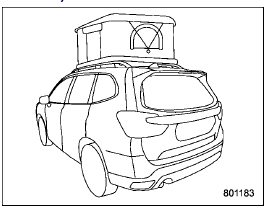
WARNING
Adding weight to the vehicle’s roof can adversely affect handling, braking, and rollover resistance. The vehicle must never be driven with a total roof rail load in excess of 176 l bs (80 kg).
CAUTION
- The roof rail load limit for stationary vehicles (700 l bs (317 kg) (for Forester), 800 l bs (360 kg) ( f o r S u b a r u F o r e s t e r Wilderness)) applies only when the vehicle is parked and the load is evenly distributed left/right and front/rear and the roof crossbars and roof tent are tightly secured to the vehicle. If these conditions are not met, the load limit will be lower.
- The maximum load limit of the roof crossbars must be obtained from the manufacturer or retailer of the roof rack. When driving the vehicle, the maximum roof rail load is 176 l bs (80 kg) or the crossbar load limit (whichever is lower).
- The maximum load limit of the roof crossbars must be obtained from the manufacturer or retailer of the roof rack. When driving the vehicle, the maximum roof rail load is 176 l bs (80 kg) or the crossbar load limit (whichever is lower).
- Roof tents can only be used on vehicles originally equipped with roof rails. Otherwise, damage to the vehicle’s roof may occur.
On vehicles equipped with roof rails, roof tents may be used under certain conditions at your own risk.
When driving the vehicle
The total weight on the roof rails, including the roof crossbars and roof tent, must not exceed the vehicle’s roof rail load of 176 l bs (80 kg), evenly distributed.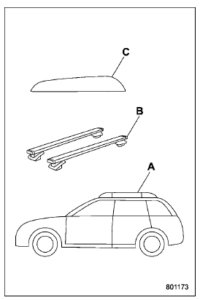
- Roof rails
- Roof crossbars
- C: Roof tent
- B + C < 176 l bs (80 kg)
When the vehicle is parked on level ground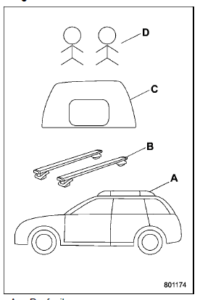
The total weight on the roof rails –including the roof crossbars, roof tent, and all occupants and contents in the roof tent must not exceed either the vehicle’s roof rail load limit (700 lbs (317 kg)), evenly distributed or the load limit of the roof crossbars, whichever is lower.
Read all Instructions for Loading vehicle and towing Base Sedan User Guide
Subaru Impreza 2023 Park Vehicle In Emergency Base Sedan User Guide
If you park your vehicle in case of an emergency
The hazard warning flasher should be used in day or night to warn other drivers when you have to park your vehicle under emergency conditions.
Avoid stopping on the road. It is best to safely pull off the road if a problem occurs. The hazard warning flasher can be activated regardless of the ignition switch position. Turn on the hazard warning by pushing the hazard warning flasher switch. Turn it off by pushing the switch again.
NOTE
When the hazard warning flasher is on, the turn signals do not work.
Temporary spare tire
WARNING
When a spare tire is mounted or a wheel rim is replaced without the original pressure sensor/transmitter being transferred, the low tire pressure warning light will illuminate steadily after blinking for approximately one minute. This indicates the tire pressure monitoring system (TPMS) is unable to monitor all four road wheels. Contact your SUBARU dealer as soon as possible for tire and sensor replacement and/or system resetting.
CAUTION
Never use any temporary spare tire other than the original. Using other sizes may result in severe mechanical damage to the drive train of your vehicle. The temporary spare tire is smaller and lighter than a conventional tire and is designed for emergency use only. Re-move the temporary spare tire and re-install the conventional tire as soon as possible because the spare tire is de-signed only for temporary use.
Check the inflation pressure of the temporary spare tire periodically to keep the tire ready for use. The correct pressure is 60 psi (420 kPa, 4.2 k gf/cm2).
When using the temporary spare tire, note the following.
- Drive with caution when the temporary spare tire is installed. Avoid hard acceleration and braking, or fast cornering, as control of the vehicle may be lost.
- Do not exceed 50 mph (80 km/h).
- Do not put a tire chain on the temporary spare tire. Because of the smaller tire size, a tire chain will not fit properly.
- Do not use two or more temporary spare tires at the same time.
- Do not drive over obstacles. This tire has a smaller diameter, so road clearance is reduced.

- Tread wear indicator bar
- Indicator location mark
- When the wear indicator appears on the tread, replace the tire.
- The temporary spare tire must be used only on a rear wheel. If a front wheel tire gets punctured, replace the wheel with a rear wheel and install the temporary spare tire in place of the removed rear wheel.
Maintenance tools
Your vehicle is equipped with the following maintenance tools.
- Jack
- Jack handle
- Screwdriver
- Towing hook (eye bolt)
- Wheel nut wrench
Tool locations
- Jack handle
- Sedan
- 5-door models
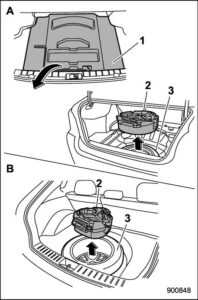
- Under-floor storage compartment (if equipped) (Refer to “Under-floor storage compartment (sedan)” �P 6-16.)
- Tool bucket
- Spare tire
- Sedan
- door models

- Wheel nut wrench
- Screwdriver
- Jack
- Towing hook (eye bolt)
A jack handle is stored under the floor of the trunk (sedan) or the cargo area (5-door models). Other tools are stored in the tool bucket that is located in the recess of the spare tire wheel. Store the tools in the tool bucket as illustrated in order that all tools are ready for use at any time.
Using the jack
- Park on a hard, level surface, when-ever possible, then stop the engine.
- Apply the parking brake securely and shift the shift lever in reverse (MT models) or the select lever to the “P” (Park) position (CVT models).
- Turn on the hazard warning flasher and unload all occupants and luggage from the vehicle.
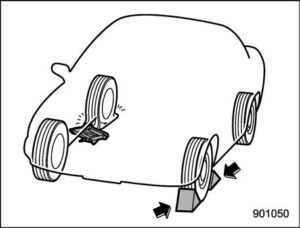
- Put wheel blocks at the front and rear of the tire diagonally opposite the tire that you are going to replace.
- Take out the jack, jack handle and wheel nut wrench.


- Place the jack under the side sill at the front or rear jack-up point closest to the tire that you are going to replace.
 Turn the jackscrew by hand until the jack head engages firmly into the jack-up point.
Turn the jackscrew by hand until the jack head engages firmly into the jack-up point.
Read all Instructions for Park Vehicle In Emergency Base Sedan User Guide
Subaru Impreza 2023 Jump starting Base Sedan User Guide
WARNING
- Battery fluid is SULFURIC ACID.
Do not let it come in contact with the eyes, skin, clothing or the vehicle. If battery fluid gets on you, thoroughly flush the exposed area with water immediately. Get medical help if the fluid has entered your eyes. If battery fluid is accidentally swallowed, immediately drink a large amount of milk or water, and obtain immediate medical help. Keep everyone including children away from the battery. - The gas generated by a battery explodes if a flame or spark is brought near it. Do not smoke or light a match while jump-starting.
- Never attempt jump-starting if the discharged battery is frozen. It could cause the battery to burst or explode.
- Whenever working on or around a battery, always wear suitable eye protectors, and remove metal objects such as rings, bands or other metal jewelry.
- Be sure the jumper cables and clamps. Keep your fingers, hands, clothing, hair, and tools away from the cooling fan, belt and any other moving engine parts. Removing rings, watches and ties is advisable.
- Jumpstarting is dangerous if it is done incorrectly. If you are un-sure about the proper procedure for jump starting, consult a competent mechanic.
When your vehicle does not start due to a run-down (discharged) battery, the vehicle may be jump-started by connecting your battery to another battery (called the booster battery) with jumper cables.
How to jump-start
- Make sure the booster battery is 12 volts and the negative terminal is grounded.
- If the booster battery is in another vehicle, do not let the two vehicles touch.
- Turn off all unnecessary lights and accessories.
- Connect the jumper cables exactly in the sequence illustrated.

- Booster battery
- Strut mounting nut
- Connect one jumper cable to the positive (+) terminal on the discharged battery.
- Connect the other end of the jumper cable to the positive (+) terminal of the booster battery.
- Connect one end of the other cable to the negative (−) terminal of the booster battery.
- Connect the other end of the cable to the strut mounting nut of the vehicle with the discharged battery.
Make sure that the cables are not near any moving parts and that the cable clamps are not in contact with any other metal. - Start the engine of the vehicle with the booster battery and run it at moderate speed. Then start the engine of the vehicle that has the discharged battery.
- When finished, carefully disconnect the cables in exactly the reverse order.
Engine overheating
WARNING
Never remove the radiator cap until the engine has been shut off and has fully cooled down. When the engine is hot, the coolant is under pressure. Removing the cap while the engine is still hot could release a spray of boiling hot coolant, which could burn you very seriously.
If the engine overheats, safely pull off the road and stop the vehicle in a safe location.
If steam is coming from the engine compartment
If the engine overheats, safely pull off the road and stop the vehicle in a safe location.
If no steam is coming from the engine compartment
- Keep the engine running at idling speed.
- Open the engine hood to ventilate the engine compartment. Refer to “Engine hood” �P 11-5.
Confirm that the cooling fan is turning. If the fan is not turning, immediately turn off the engine and contact an authorized SUBARU dealer for repair.
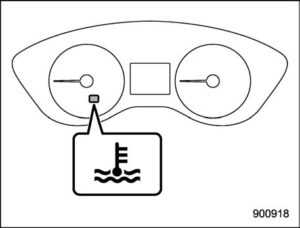 Coolant temperature high warning light (red)
Coolant temperature high warning light (red) - After the coolant temperature, high warning light that has blinked or illuminated in RED turns off, turn off the engine.
For details about the warning light, refer to “Coolant temperature low indicator light/ Coolant temperature high warning light” �P 3-16. - After the engine has fully cooled down, check the coolant level in the reserve tank.
If the coolant level is below the “LOW” mark, add coolant up to the “FULL” mark.
NOTE - If there is no coolant in the reserve tank, add coolant to the reserve tank. Then remove the radiator cap and fill the radiator with coolant. If you remove the radiator cap from a hot radiator, first wrap a thick cloth around the radiator cap, then turn the cap counterclockwise slowly without pressing down For details about how to check the coolant level or how to add coolant, refer to “Engine coolant”. until it stops. Release the pressure from the radiator. After the pressure has been fully released, remove the cap by pressing down and turning it.
Towing
If towing is necessary, it is best done by your SUBARU dealer or a commercial towing service. Observe the following procedures for safety.
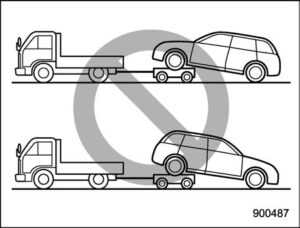
WARNING
Never tow AWD models with the front wheels raised off the ground while the rear wheels are on the ground, or with the rear wheels raised off the ground while the front wheels are on the ground. This will cause the vehicle to spin away due to the operation or deterioration of the center differential.
Towing hooks and tie-down hooks/holes
CAUTION
Use only the specified towing hooks and tie-down hooks/holes. Never use suspension parts or other parts of the body for towing or tie-down purposes.
Front towing hook
- Take the towing hook, screwdriver and jack handle out of the cargo area.
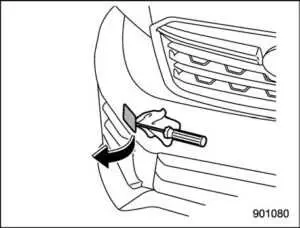
- Cover the tip of a flat-head screwdriver with vinyl tape or cloth so that it will not scratch the bumper. Insert the flathead screwdriver into the cutout of the cover and pry open the cover.

- Screw the towing hook into the threaded hole until its thread can no longer be seen.
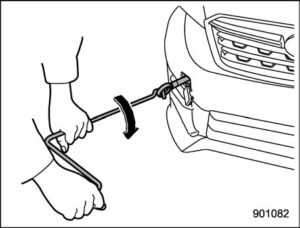
Read all Instructions for Jump starting Base Sedan User Guide
Subaru Impreza 2023 Access key fob Base Sedan User Guide
Access key fob –If the Access key fob Does Not Operate Properly
CAUTION
Keep metallic objects, magnetic sources, and signal transmitters away from the area between the access key fob and the push-button ignition switch. They may interfere with the communication between the access key fob and the push-button ignition switch.
The following functions may be inoperable because of strong radio signals in the surrounding area or a low battery condition of the access key fob.
- Locking/unlocking doors (including the rear gate)
- Switching power status
- Starting engine
In such cases, perform the following procedure. When the battery of the access key fob is discharged, replace it with a new one. Refer to “Replacing battery of access key fob” P 11-47.
Locking and unlocking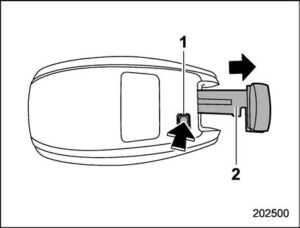
- Release button
- Emergency key
While pressing the release button of the access key fob, take out the emergency key.
Lock or unlock the driver’s door with the emergency key in the procedure described in “Locking and unlocking from the outside” P 2-23.
NOTE
After locking or unlocking, be sure to attach the emergency key back to the access key fob.
Switching power status
- Apply the parking brake.
- Shift the select lever to the “P” (Park) position.
- Depress the brake pedal.

- Hold the access key fob with the buttons facing you, and touch the push-button ignition switch with it. When the communication between the access key fob and the vehicle is completed, a chime (ding) will sound. At the same time, the status of the push-button ignition switch changes to either of the following.
- When the keyless access with the push-button start system is deactivated: “ACC”
- Under other conditions: “ON”
- When the keyless access with the push-button start system is deactivated, press the push-button ignition switch with the brake pedal released. The status of the push-button ignition switch then changes to “ON”.
NOTE
If the power does not switch even though the above procedure was followed precisely, contact your SUBARU dealer.
Starting engine
- Apply the parking brake.
- Shift the select lever to the “P” (Park) position.
- Depress the brake pedal.
- Hold the access key fob with the buttons facing you, and touch the push-button ignition switch with it. When the communication between the access key fob and the vehicle is completed, a chime (ding) will sound. At the same time, the push-button ignition switch turns to the “ACC” or “ON” position.
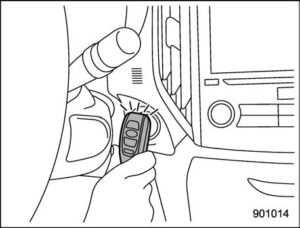
- After the push-button ignition switch turns to the “ACC” or “ON” position, while depressing the brake pedal, press the push-button ignition switch.
If the engine does not start even though the above procedure was followed precisely, contact your SUBARU dealer.
Rear gate – if the rear gate cannot be opened
In the event that you cannot open the rear gate by operating the rear gate opener button, you can open it from inside the cargo area.
- Remove the access cover at the bottom center of the rear gate trim using a flat-head screwdriver wrapped with vinyl tape or cloth.
- Locate the rear gate open lever behind the rear gate trim.
CAUTION
Never operate the rear gate open lever with your fingers because doing so may cause an injury. Always use a flat-head screwdriver or a similar tool.

- To open the rear gate, turn the lever to the right position.
Moonroof (if equipped) – if the moonroof does not close
If the moonroof does not close, we recommend that you have the system checked by a SUBARU dealer.
If your vehicle is involved in an accident
CAUTION
If your vehicle is involved in an accident, be sure to inspect the ground under the vehicle before restarting the engine. If you find that fuel has leaked on the ground, do not try to restart the engine. The fuel system has been damaged and is in need of repair. Immediately contact the nearest automotive service facility. We recommend that you consult your SUBARU dealer.
Your vehicle has a fuel pump shut-off system. When the vehicle sustains an impact in an accident, etc., the fuel pump shut-off system stops supplying the fuel in order to minimize fuel leakage. However, depending on the impact conditions at the time of the collision, the fuel pump shut-off system may not operate.
Perform the following procedures to restart the engine after the system is activated.
Models without “keyless access with push-button start system”:
- Turn the ignition switch to the “LOCK” or “ACC” position.
- Restart the engine.
Models with “keyless access with push-button start system”:
- Turn the push-button ignition switch to the “ACC” or “OFF” position.
- Restart the engine.
Automatic door locking/unlocking operation when involved in an accident
When the automatic door locking/unlocking function is ON, all the doors will be locked automatically while driving. For further details, refer to “Automatic door locking/unlocking” P2-25.
When the vehicle sustains a strong impact which may trigger the airbags to deploy, the door locks may be unlocked automatically to enable emergency escape. Generally, an impact sustained from a rear-end collision does not trigger the airbags to deploy. However, if the impact is strong enough to deploy the airbags, it can also trigger the unlocking function.
Under such circumstances, the automatic door unlocking function will be suspended and the doors will remain unlocked. Confirm the safety of the surroundings first and carry out the following to retrieve the automatic door locking/unlocking function.
Read all Instructions for Access key fob Base Sedan User Guide
Subaru Impreza 2023 Exterior care Base Sedan User Guide
Exterior care
Washing
CAUTION
- When washing the vehicle, the brakes may get wet. As a result, the brake stopping distance will be longer. To dry the brakes, drive the vehicle at a safe speed while lightly depressing the brake pedal to heat up the brakes.
- Do not wash the engine compartment and area adjacent to it. If water enters the engine air intake or electrical parts, it will cause engine trouble or a malfunction of electrical equipment.
- When washing inner fenders, underbody, bumpers, and protruding objects such as exhaust pipes and exhaust finishers, be careful to prevent injuries from contacting sharp ends.
- Do not use any organic solvents when washing the surface of the bulb assembly cover. However, if a detergent with organic solvents is used to wash the cover surface, completely rinse off the detergent with water. Otherwise, the cover surface may be damaged.
- For 5-door models, since your vehicle is equipped with a rear wiper, automatic car-wash brushes could become tangled around it, damaging the wiper arm and other components. Ask the automatic car-wash operator not to let the brushes touch the wiper arm or to fix the wiper arm on the rear window glass with adhesive tape before operating the machine.
- For models with rod-type roof antennae, remove the antenna rod before washing your car at a car wash. If the antenna rod remains attached, it may scratch the roof. When reinstalling the removed antenna rod, be sure to fully tighten it.
NOTE
- When having your vehicle washed in an automatic car wash, make sure beforehand that the car wash is of a suitable type
- The rearview camera lens has a hard coating to help prevent scratches. However, when washing the vehicle or cleaning the camera lens, be careful not to scratch the camera lens. Do not use a washing brush directly on the camera lens. The image quality of the rearview camera may deteriorate.
The best way to preserve your vehicle’s beauty is frequent washing. Wash the vehicle at least once a month to avoid contamination by road grime.
Wash dirt off with a wet sponge and plenty of lukewarm or cold water. Do not wash the vehicle with hot water and in direct sunlight.
Salt, chemicals, insects, tar, soot, tree sap, and bird droppings should be washed off using a light detergent, as required. If you use a light detergent, make certain that it is a neutral detergent. Do not use strong soap or chemical detergents. All cleaning agents should be promptly flushed from the surface and not allowed to dry there. Rinse the vehicle thoroughly with plenty of lukewarm water. Wipe the remaining water off with a chamois or soft cloth. Wear rubber gloves and use a hand brush when washing down the underbody, inner fenders, and suspension to effectively remove mud and dirt off.
Washing the underbody
Chemicals, salts and gravel used for deicing road surfaces are extremely corrosive, accelerating the corrosion of underbody components, such as the exhaust system, fuel, and brake lines, brake cables, floor pan and fenders, and suspension. Thoroughly flush the underbody and inside of the fenders with lukewarm or cold water at frequent intervals to reduce the harmful effects of such agents.
Mud and sand adhering to the underbody components may accelerate their corrosion. After driving off-road or on muddy or sandy roads, wash the mud and sand off the underbody. Carefully flush the suspension and axle parts, as they are particularly prone to mud and sand buildup. Do not use a sharp-edged tool to remove caked mud.
CAUTION
- Be careful not to damage brake hoses, sensor harnesses, and other parts when washing suspension components.
- Be careful not to flush the engine bottom for a long time. It may cause damage of some electrical parts.
Using a warm water washer
- Keep a good distance of 12 in (30 cm)or more between the washer nozzle and the vehicle.
- Do not wash the same area continuously.
- If a stain will not come out easily, wash by hand. Some warm water washers are of the high temperature, high pressure type, and they can damage or deform the resin parts such as moldings, or cause water to leak into the vehicle.
Waxing and polishing
Always wash and dry the vehicle before waxing and polishing.
Use a good quality polish and wax and apply them according to the manufacturer’s instructions. Wax or polish when the painted surface is cool.
Be sure to polish and wax the chrome trim, as well as the painted surfaces. Loss of wax on a painted surface leads to loss of the original luster and also quickens the deterioration of the surface. It is recommended that a coat of wax be applied at least once a month, or whenever the surface no longer repels water.
If the appearance of the paint has diminished to the point where the luster or tone cannot be restored, lightly polish the sur-face with a fine-grained compound. Never polish just the affected area, but include the surrounding area as well. Always polish in only one direction. A No. 2000 grain compound is recommended. Never use a coarse-grained compound. Coarse-grained compounds have a smaller grain-size number and could damage the paint.
After polishing with a compound, coat with wax to restore the original luster. Frequent polishing with a compound or an incorrect polishing technique will result in removing the paint layer and exposing the undercoat. When in doubt, it is always best to contact your SUBARU dealer or an auto paint specialist.
CAUTION
Do not use any agents with organic solvents on the surface of the bulb assembly cover. However, if a polish or wax with organic solvents is applied to the cover surface, completely wipe off the polish or wax. Otherwise, the cover surface may be damaged.
NOTE
- Be careful not to block the windshield washer nozzles with wax when waxing the vehicle.
- Do not wipe the rearview camera with alcohol, benzene, or paint thinner. Otherwise, discoloration may occur. To remove contamination, wipe the camera with a cloth moistened with diluted neutral detergent and then wipe it with a soft, dry cloth.
- When waxing the vehicle, be careful not to apply the wax to the rearview camera. If it comes in contact with the camera, moisten a clean cloth with diluted neutral detergent to remove the wax.
- For Subaru Forester Wilderness models, if the wax gets onto the hood decal when you are waxing your vehicle, this could enhance the reflective appearance of the hood decal and impair the anti-reflective function.
Cleaning alloy wheels
- Promptly wipe the alloy wheels clean of any kind of grime or agent. If dirt is left on too long, it may be difficult to clean off.
- Do not use soap-containing grit to clean any kind of grime or agent. If dirt is left on too long, it may be difficult to clean off.
- Do not use soap-containing grit to clean the wheels. Be sure to use a neutral cleaning agent, and later rinse thoroughly with water. Do not clean the wheels with a stiff brush or expose them to a high-speed washing device.
- Clean the vehicle (including the alloy wheels) with water as soon as possible when it has been splashed with seawater, exposed to sea breezes, or driven on roads treated with salt or other agents.
Corrosion protection
Your SUBARU has been designed and built to resist corrosion. Special materials and protective finishes have been used on most parts of the vehicle to help maintain a fine appearance, strength, and reliable operation.
Most common causes of corrosion
The most common causes of corrosion are:
- The accumulation of moisture-retaining dirt and debris in body panel sections, cavities, and other areas.
- Damage to paint and other protective coatings caused by gravel and stone chips or minor accidents.
Corrosion is accelerated on the vehicle when:
- It is exposed to road salt or dust control chemicals or used in coastal areas where there is more salt in the air, or in areas where there is considerable industrial pollution.
- It is driven in areas of high humidity, especially when temperatures range just above freezing.
- Dampness in certain parts of the vehicle remains for a long time, even though other parts of the vehicle may be dry.
- High temperatures will cause corrosion to parts of the vehicle that cannot dry quickly due to a lack of proper ventilation.
To help prevent corrosion
Wash the vehicle regularly to prevent corrosion of the body and suspension components. Also, wash the vehicle promptly after driving on any of the following surfaces.
- Roads that have been salted to prevent them from freezing in winter
- Mud, sand, or gravel
- Coastal roads
After the winter has ended, it is recommended that the underbody be given a very thorough washing.
Before the beginning of winter, check the condition of underbody components, such as the exhaust system, fuel and brake lines, brake cables, suspension, steering system, floor pan, and fenders. If any of them are found to be rusted, they should be given an appropriate rust prevention treatment or should be replaced. Contact your SUBARU dealer to perform this kind of maintenance and treatment if you need assistance. Repair chips and scratches in the paint as soon as you find them.
Read all Instructions for Exterior care Base Sedan User Guide
Subaru Impreza 2023 Cleaning Interior Base Sedan User Guide
Cleaning the interior
Use a soft, damp cloth to clean the climate control panel, audio equipment, instrument panel, center console, combination meter panel, and switches. (Do not use organic solvents.)
CAUTION
Do not use sharp instruments or window cleaner containing abrasives to clean the inner surface of the rear window. They may damage the conductors printed on the window.
Seat fabric
Remove loose dirt, dust or debris with a vacuum cleaner. If the dirt is caked on the fabric or hard to remove with a vacuum cleaner, use a soft brush then vacuum it. Wipe the fabric surface with a tightly wrung cloth and dry the seat fabric thoroughly. If the fabric is still dirty, wipe using a solution of mild soap and lukewarm water then dry thoroughly.
If the stain does not come out, try a commercially-available fabric cleaner. Use the cleaner on a hidden place and interior make sure it does not affect the fabric adversely. Use the cleaner according to its instructions.
CAUTION
When cleaning the seat, do not use benzene, paint thinner, or any similar materials. Doing so could damage the surface and cause the color to deteriorate.
Leather seat materials
The leather used by SUBARU is a high-quality natural product that will retain its distinctive appearance and feel for many years with proper care.
Allowing dust or road dirt to build up on the surface can cause the material to become brittle and to wear prematurely. Regular cleaning with a soft, moist, natural fiber cloth should be performed monthly, taking care not to soak the leather or allow water to penetrate the stitched seams.
A mild detergent suitable for cleaning woolen fabrics may be used to remove difficult dirt spots, rubbing with a soft, dry cloth afterward to restore the luster. If your SUBARU is to be parked for a long time in bright sunlight, it is recommended that the seats and head restraints be covered, or the windows shaded, to prevent fading or shrinkage.
Minor surface blemishes or bald patches may be treated with a commercial leather spray lacquer. You will discover that each leather seat section will develop soft folds or wrinkles, which is characteristic of genuine leather.
Synthetic leather upholstery
The synthetic leather material used on the SUBARU may be cleaned using mild soap or detergent and water, after first vacuuming or brushing away loose dirt. Allow the soap to soak in for a few minutes and wipe off with a clean, damp cloth. Commercial foam-type cleaners suitable for synthetic leather materials may be used when necessary.
CAUTION
Strong cleaning agents such as solvents, paint thinners, window cleaners or fuel must never be used on leather or synthetic interior materials. Doing so could damage the surface and cause the color to deteriorate.
Water-repellent seat material (if equipped)
The water repellency of the seat fabric will decrease over time. Do not apply the additional water-repellent coating.
Seatbelt
For details about how to clean the seatbelt, refer to “Seatbelt maintenance” P 1-20.
Climate control panel, audio panel, instrument panel, console panel, and switches
Use a soft, damp cloth to clean the climate control panel, audio equipment, instrument panel, center console, combination meter panel, and switches.
CAUTION
- Do not use organic solvents such as paint thinners or fuel, or strong cleaning agents that contain those solvents. Doing so could damage the surface and cause the color to deteriorate.
- Do not use chemical solvents that contain silicone on the vehicle audio system, electrical components of the air-conditioner, or any switches. If silicone adheres to these parts, it may cause damage to electrical components.
Monitor
To clean the audio/navigation/multi-function display monitor, wipe it with a silicone cloth or with a soft cloth. If the monitor is extremely dirty, clean it with a soft cloth moistened with neutral detergent then carefully wipe off any remaining detergent.
CAUTION
- Do not spray neutral detergent directly onto the monitor. Doing so could damage the monitor’s components.
- Do not wipe the monitor with a hard cloth. Doing so could scratch the monitor.
- Do not use cleaning fluid that contains thinner, fuel, or any other volatile substance. Such cleaning fluid could erase the lettering on the switches at the bottom of the monitor.
- Read all Instructions for Cleaning Interior Base Sedan User Guide
-
Subaru Impreza 2023 Maintenance schedule Base Sedan User Guide
- https://autouserguide.com/subaru/impreza/subaru-impreza-2023-maintenance-schedule-base-sedan-user-guide/
-
Maintenance schedule
U.S. models
The scheduled maintenance items required to be serviced at regular intervals are shown in the “Warranty and Maintenance Booklet”. For details, read the separate “Warranty and Maintenance Booklet”.Canada models
The scheduled maintenance items required to be serviced at regular intervals are shown in the “Warranty and Service Booklet”. For details, read the separate “Warranty and Service Booklet”.Except for U.S. and Canadian models
Some items of your vehicle are required to be serviced at scheduled intervals. For details about your maintenance schedule, read the separate “Warranty and Maintenance Booklet”.NOTE
For models with a multi-function display (color LCD), you can set a reminder to be displayed when a scheduled maintenance item is almost due. For details, refer to “Maintenance settings” P3-60.Maintenance precautions
When maintenance and service are required, it is recommended that all work be done by an authorized SUBARU dealer.
If you perform maintenance and service by yourself, you should familiarize yourself with the information provided in this section on general maintenance and service for your SUBARU. Incorrect or incomplete service could cause improper or unsafe vehicle operation. Any problems caused by improper maintenance and service performed by you are not eligible for warranty coverage.WARNING
- Always select a safe area when performing maintenance on your vehicle.
- Always be very careful to avoid injury when working on the vehicle. Remember that some of the materials in the vehicle may be hazardous if improperly used or handled, for example, battery acid.
- Your vehicle should only be serviced by persons fully competent to do so. Serious personal injury may result to persons, not experienced in servicing vehicles.
- Always use the proper tools and make certain that they are well-maintained.
- Never get under the vehicle supported only by a jack. Always use safety stands to support the vehicle.
- Never keep the engine running in a poorly ventilated area, such as a garage or other closed areas.
- Do not smoke or allow open flames around the fuel or battery. This will cause a fire.
- Because the fuel system is under pressure, replacement of the fuel filter should be performed only by your SUBARU dealer.
- Wear adequate eye protection to guard against getting oil or fluids in your eyes. If something does get in your eyes, thoroughly
wash them out with clean water. - Do not tamper with the wiring of the SRS airbag system or seatbelt pre-tensioner system, or at- tempt to take its connectors apart, as this may activate the system or render it inoperative. NEVER use a circuit tester for this wiring. If your SRS airbag or seatbelt pre-tensioner needs service, consult your nearest SUBARU dealer.
- Check the inside of the engine compartment to see if there are any clothes and tools left. If they are left inside, they may be a cause of malfunction and fire.
NOTE
SUBARU does not endorse the use of non-SUBARU-approved flushing systems and strongly advises against performing these services on a SUBARU vehicle. Non-SUBARU-approved flushing systems use chemicals and/or solvents that have not been tested or approved by SUBARU. SUBARU warranties do not cover any part of the vehicle which is damaged by adding or applying chemicals and/or solvents other than those approved or recommended by SUBARU.Before checking or servicing the engine compartment
- Always stop the engine and apply the parking brake firmly to prevent the vehicle from moving.
- Always let the engine cool down. Engine parts become very hot when the engine is running and remain hot for some time after the engine has stopped.
- Do not spill engine oil, engine coolant, brake fluid, or any other fluid on hot engine components. This may cause a fire.
- When the ignition switch is in the “ON” position, the cooling fan may operate suddenly even when the engine is stopped. If your body or clothes come into contact with a rotating fan, that could result in serious injury. To avoid the risk of injury, perform the following precautions.
- Models with push-button start system: Always turn the push-button ignition switch to the “OFF” position and confirm that the operation indicator on the switch is turned off. Then take the access key fob out of the vehicle.
- Models without push-button start system: Always remove the key from the ignition switch.
- Before performing any servicing on a vehicle equipped with a remote engine start system (a dealer option), temporarily place the remote engine start system in service mode to prevent it from unexpectedly starting the engine. 450 Maintenance precautions
When checking or servicing the engine compartment
 CAUTION
CAUTION- Do not touch the engine cover while checking the components in the engine compartment. Doing so may cause your hand
to slip off the cover and result in an unexpected injury. - Do not touch the oil filter until the engine has cooled down completely. Doing so may result in a burn or other injury. Note that the oil filter becomes very hot when the engine is running and remains hot for some time after the engine has stopped.
-
When checking or servicing the engine compartment while the engine is running
WARNING
A running engine can be dangerous. Keep your fingers, hands, clothing, hair and tools away from the cooling fan, drive belt, and any other moving engine parts. Removing rings, watches and ties are advisable. - Read all Instructions for Maintenance schedule Base Sedan User Guide
-
Subaru Impreza 2023 Engine hood Base Sedan User Guide
- https://autouserguide.com/subaru/impreza/subaru-impreza-2023-engine-hood-base-sedan-user-guide/
-
Engine hood
CAUTION
- Be extremely careful not to catch fingers or other objects when closing the engine hood.
- Do not push the hood forcibly to close it. It could deform the metal.
- Be extremely careful opening the engine hood when the wind is strong. The engine hood could close suddenly, possibly causing injuries from slamming.
- Do not install accessories other than genuine SUBARU parts to the engine hood. If the engine hood becomes too heavy, the stay may not be able to support holding it open.
- Check that the end of the hood stay is inserted into the slot. If it is not inserted properly, the hood may drop and cause injury
To open the hood:
- If the wiper blades are lifted off the windshield, return them to their original position.

- Pull the hood release knob under the instrument panel.

- Release the secondary hood release by moving the lever between the front grille and the hood toward the left.

- Lift up the hood, release the hood prop from its retainer and put the end of the hood prop into the slot in the hood. Hold the grip for handling the hood prop.
To close the hood:
- Lift the hood slightly and remove the hood prop from the slot in the hood and return the prop to its retainer.
- Lower the hood to a height of approximately 7.8 to 11.8 in (20 to 30 cm) above its closed position and then let it drop.
- After closing the hood, be sure the hood is securely locked.
If this does not close the hood, release it from a slightly higher position.
WARNING
Always check that the hood is properly locked before you start driving. If it is not, it might fly open while the vehicle is moving and block your view, which may cause an accident and serious bodily injury.Engine compartment overview
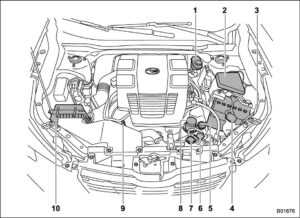
- Brake fluid reservoir/Clutch fluid reservoir (MT models) (pages 11-15)
- The fuse box (pages 11-37)
- Battery (pages 11-36)
- Windshield washer tank (pages 11-30)
- Radiator cap (pages 11-11)
- Engine oil filler cap (pages 11-8)
- Engine coolant reservoir (pages 11-11)
- The engine oil filter (pages 11-10)
- Engine oil level gauge (pages 11-9)
- Air cleaner case (pages 11-12)
Engine oil
CAUTION
- If the level gauge cannot be pulled out easily, twist the level gauge right and left, then gently pull it out. Otherwise, you may be injured accidentally straining yourself.
- Use only engine oil with the recommended grade and viscosity.
- Be careful not to spill engine oil when adding it. If oil touches the exhaust pipe, it may cause a bad smell, smoke, and/or a fire. If engine oil gets on the exhaust pipe, be sure to wipe it off.
Engine oil consumption
Some engine oil will be consumed while driving. The rate of consumption can be affected by such factors as transmission type, driving style, terrain, and temperature. Under the following conditions, oil consumption can be increased and may require refilling between maintenance intervals.
- When the engine is new and within the break-in period.
- When the engine oil is of lower quality.
- When the incorrect oil viscosity is used.
- When engine braking is employed (repeatedly).
- When the engine is operated at high engine speeds (for extended periods of time).
- When the engine is operated under heavy loads (for extended periods of time).
- When towing a trailer
- When the engine idles for extended periods of time.
- When the vehicle is operated in stop-and-go and/or heavy traffic situations.
- When the vehicle is used under severe thermal conditions.
- When the vehicle accelerates and decelerates frequently.
Under these or similar conditions, you should check your oil at least every 2nd fuel fill-up and change your engine oil more frequently. Different drivers in the same car may experience different results. If your oil consumption rate is greater than expected, contact your authorized SUBARU dealer who may perform a test under controlled conditions.
- Read all Instructions for Engine hood Base Sedan User Guide
-
Subaru Impreza 2023 Cooling system Base Sedan User Guide
- https://autouserguide.com/subaru/impreza/subaru-impreza-2023-cooling-system-base-sedan-user-guide/
-
Safety precautions
WARNING
Never remove the radiator cap until the engine has been shut off and has cooled down completely. Since the coolant is under pressure, you may suffer serious burns from a spray of boiling hot coolant when the cap is removed.CAUTION
- Vehicles are filled at the factory with SUBARU SUPER COOLANT which does not require the first change for 11 years/137,500 miles (11 years/220,000 km). This coolant should not be mixed with any other brand or type of coolant during this period. Mixing with a different coolant will reduce the life of the coolant. When necessary to top up the coolant for any reason, use only SUBARU SUPER COOLANT.
If SUBARU SUPER COOLANT is diluted with another brand or type, the maintenance interval is shortened to that of the mixing coolant. - Do not splash the engine coolant over painted parts. The alcohol contained in the engine coolant may damage the paint surface.
Cooling fan, hose, and connections
Your vehicle employs an electric cooling fan which is thermostatically controlled to operate when the engine coolant reaches a specific temperature.

Coolant temperature high warning light (red)
If the radiator cooling fan does not operate even when the coolant temperature high warning light blinks or illuminates in RED, the cooling fan circuit may be defective. Refer to “Coolant temperature low indicator light/Coolant temperature high warning light” Check the fuse and replace it if necessary. Refer to “Fuses” 11-37. If the fuse is not blown, have the cooling system checked by your SUBARU dealer. If the frequent addition of coolant is necessary between vehicle service visits, it is recommended that you have your vehicle inspected by an authorized SUBARU dealer to check for leaks, damage, or looseness.
Engine coolant
Checking the coolant level
WARNING
Never remove the radiator cap until the engine has been shut off and has cooled down completely. Since the coolant is under pressure, you may suffer serious burns from a spray of boiling hot coolant when the cap is removed.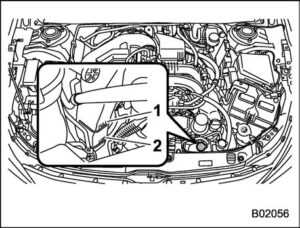
- “FULL” level mark
- “LOW” level mark
Check the coolant level at each fuel stop.
- Check the coolant level on the outside of the reservoir while the engine is cool.
- If the level is close to or lower than the “LOW” level mark, add coolant up to the “FULL” level mark. If the reserve tank is empty, remove the radiator cap and refill coolant up to just below the filler neck as shown in the following illustration.
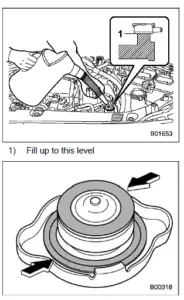
- After refilling the reserve tank and the radiator, reinstall the cap and check that the rubber gaskets inside the radiator cap are in the proper position.
CAUTION
- Be careful not to spill engine coolant when adding it. If coolant touches the exhaust pipe, it may cause a bad smell, smoke, and/or a fire. If engine coolant gets on the exhaust pipe, be sure to wipe it off.
- Do not splash the engine coolant over painted parts. The alcohol contained in the engine coolant may damage the paint surface.
Changing the coolant
It may be difficult to change the coolant. Has the coolant been changed by your SUBARU dealer if necessary? The coolant should be changed according to the maintenance schedule in the “Warranty and Maintenance Booklet”.
Air cleaner element
WARNING
Do not operate the engine with the air cleaner element removed. The air cleaner element not only filters intake air but also stops flames if the engine backfires. If the air cleaner element is not installed when the engine backfires, you could be burned.CAUTION
When replacing the air cleaner element, use a genuine SUBARU air cleaner element. If it is not used, there is the possibility of causing a negative effect to the engine.The air cleaner element functions as a filter screen. When the element is perforated or removed, engine wear will be excessive and engine life shortened.
It is not necessary to clean or wash the air cleaner element.Replacing the air cleaner element
Replace the air cleaner element according to the maintenance schedule in the “Warranty and Maintenance Booklet”. Under extremely dusty conditions, replace it more frequently. It is recommended that you always use genuine SUBARU parts.

Clips
- Unsnap the two clips holding the air cleaner case (rear).
- Open the air cleaner case and pull the cover rearward while lifting it up.
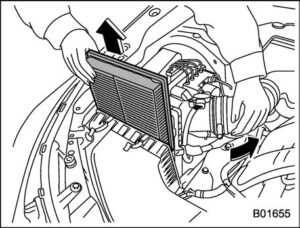
- Remove the air cleaner element.
- Clean the inside of the air cleaner case (both front and rear) with a damp cloth and install a new air cleaner element.

- To install the air cleaner case (rear), insert the three projections on the air cleaner case (rear) into the slits on the air cleaner case (front).
- Install in the reverse order of removal.
NOTE
Install the air cleaner element so that the surface with “UPR” printed on it faces upward. - Vehicles are filled at the factory with SUBARU SUPER COOLANT which does not require the first change for 11 years/137,500 miles (11 years/220,000 km). This coolant should not be mixed with any other brand or type of coolant during this period. Mixing with a different coolant will reduce the life of the coolant. When necessary to top up the coolant for any reason, use only SUBARU SUPER COOLANT.
- Read all Instructions for Cooling system Base Sedan User Guide
-
Subaru Impreza 2023 Brake fluid Base Sedan User Guide
- https://autouserguide.com/subaru/impreza/subaru-impreza-2023-brake-fluid-base-sedan-user-guide/
-
Brake fluid
Checking the fluid level
WARNING
- Never let brake fluid contact your eyes because brake fluid can be harmful to your eyes. If brake fluid gets in your eyes, immediately flush them thoroughly with clean water. For safety, when performing this work, wearing eye protection is advisable.
- Brake fluid absorbs moisture from the air. Any absorbed moisture can cause a dangerous loss of braking performance.
- If the vehicle requires frequent refilling, there may be a leak. If you suspect a problem, have the vehicle checked at your SUBARU dealer.
CAUTION
- When adding brake fluid, be careful not to allow any dirt into the reservoir.. Never splash the brake fluid over painted surfaces or rubber parts.
- Never splash the brake fluid over painted surfaces or rubber parts. The alcohol contained in the brake fluid may damage them.
- Be careful not to spill brake fluid when adding it. If brake fluid touches the exhaust pipe, it may cause a bad smell, smoke, and/or a fire. If brake fluid gets on the exhaust pipe, be sure to wipe it off.
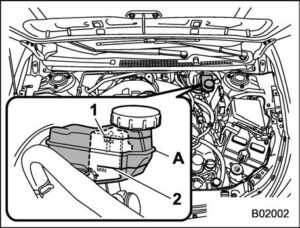
- “MAX” level line
- “MIN” level line A)
- The brake fluid level must be checked in this area. Check the fluid level monthly.
Check the fluid level on the outside of the reservoir. Be sure to check the fluid level for the brake system at the shaded area in the illustration. For MT models, this reservoir is used for both the brake and clutch systems and has chambers for each system.
If the fluid level is below “MIN”, add the recommended brake fluid to “MAX”. Use only brake fluid from a sealed container.
Recommended brake fluid
CAUTION
Never use different brands of brake fluid together. Also, avoid mixing DOT 3 and DOT 4 brake fluids even if they are the same brand.Clutch fluid (MT models)
Checking the fluid level
WARNING
Never let clutch fluid contact your eyes because clutch fluid can be harmful to your eyes. If clutch fluid gets in your eyes, immediately flush them thoroughly with clean water. For safety, when performing this work, wearing eye protection is advisable.CAUTION
- The clutch fluid absorbs moisture from the air. Any absorbed moisture can cause improper clutch operation.
- If the vehicle requires frequent refilling, there may be a leak. If you suspect a problem, have the vehicle checked at your SUBARU dealer.
- When clutch fluid is added, be careful not to allow any dirt into the tank.
- Never splash the clutch fluid over painted surfaces or rubber parts. The alcohol contained in the clutch fluid may damage them.
- Be careful not to spill clutch fluid when adding it. If clutch fluid touches the exhaust pipe, it may cause a bad smell, smoke, and/or a fire. If clutch fluid gets on the exhaust pipe, be sure to wipe it off.
- The fluid level for the clutch system must be checked at the inboard side of the reservoir. It cannot be checked at the outboard side of the reservoir.
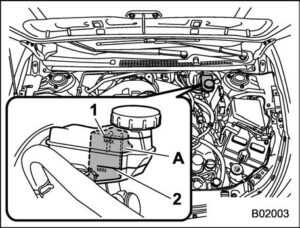
- “MAX” level line
- “MIN” level line
- The clutch fluid level must be checked in this area.
- Check the fluid level monthly.
Check the fluid level on the outside of the reservoir. Because this reservoir is used for both the brake and clutch systems and has chambers for each system, be sure to check the fluid level for the clutch system at the shaded area in the illustration. If the fluid level is below “MIN”, add the recommended clutch fluid to “MAX”. Use only clutch fluid from a sealed container.
-
Recommended clutch fluid
CAUTION
Never use different brands of clutch fluid together. Also, avoid mixing DOT 3 and DOT 4 brake fluids even if they are the same brand.
Brake booster
If the brake booster does not operate as described in the following, have it checked by your SUBARU dealer.
- With the ignition switch in the “LOCK”/ “OFF” position, depress the brake pedal several times, applying the same pedal force each time. The distance the pedal travels should not vary.
- With the brake pedal depressed, start the engine. The pedal should move slightly down to the floor.
- With the brake pedal depressed, stop the engine and keep the pedal depressed for 30 seconds. The pedal height should not change.
- Start the engine again and run for approximately one minute then turn it off. Depress the brake pedal several times to check the brake booster. The brake booster operates properly if the pedal stroke decreases with each depression.
Brake pedal
Check the brake pedal free play and reserve distance according to the maintenance schedule in the “Warranty and Maintenance Booklet”.Checking the brake pedal free play
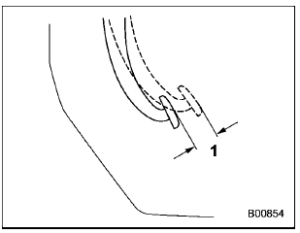 0.02 – 0.11 in (0.5 – 2.7 mm)
0.02 – 0.11 in (0.5 – 2.7 mm)Turn the ignition switch to the “LOCK”/ “OFF” position and firmly depress the brake pedal several times. Lightly pull the brake pedal up with one finger to check the free play with a force of less than 2 l bf (10 N, 1 k g f).If the free play is not within the proper specification, contact your SUBARU dealer.
Checking the brake pedal reserve distance
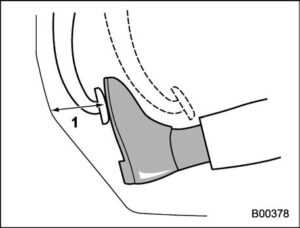
More than 2.56 in (65 mm)
Depress the pedal with a force of approximately 66 l bf (294 N, 30 k gf) and measure the distance between the upper surface of the pedal pad and the floor. When the measurement is smaller than the specification, or when the pedal does not operate smoothly, contact your SUBARU dealer.
Clutch pedal (MT models)
Check the clutch pedal free play according to the maintenance schedule in the “Warranty and Maintenance Booklet”.
Checking the clutch function
Check the clutch engagement and disengagement.
- With the engine idling, check that there are no abnormal noises when the clutch pedal is depressed and that shifting into 1st or reverse feels smooth.
- Start the vehicle by releasing the pedal slowly to check that the engine and transmission smoothly couple without any sign of slippage.
-
Checking the clutch pedal free play
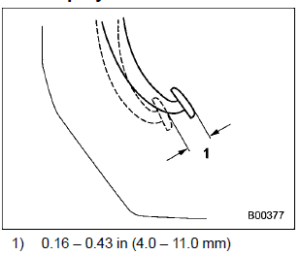
Lightly depress the clutch pedal down with your finger until you feel resistance, and check the free play. If the free play is not within proper specification, contact your SUBARU dealer.
Hill start assist system
Ensure that the Hill start assist system operates properly under the following circumstances.
- Stop the vehicle on an uphill grade by depressing the brake pedal (all models) and clutch pedal (MT models only), with the engine running.
- Make sure that the vehicle does not move backward for several seconds after the brake pedal is released.
- Then make sure the vehicle starts climbing the grade by following the normal starting procedures.If the Hill start assist system does not operate as described above, contact your SUBARU dealer.
- Read all Instructions for Brake fluid Base Sedan User Guide
-
Subaru Impreza 2023 Tires and wheels Base Sedan User Guide
- https://autouserguide.com/subaru/impreza/subaru-impreza-2023-tires-and-wheels-base-sedan-user-guide/
-
Tires and wheels
Types of tires
You should be familiar with type of tires present on your vehicle.
All season tires
All season tires are designed to provide an adequate measure of traction, handling and braking performance in year-round driving including snowy and icy road conditions. However, all season tires do not offer as much traction performance as winter (snow) tires in heavy or loose snow or on icy roads.
All season tires are identified by “ALL SEASON” and/or “M+S” (Mud & Snow) on the tire sidewall.Summer tires
Summer tires are high-speed capability tires best suited for highway driving under dry conditions. Summer tires are inadequate for driving on slippery roads such as on snow-covered or icy roads. If you drive your vehicle on snow-covered or icy roads, we strongly recommend the use of winter (snow) tires. When installing winter tires, be sure to replace all four tires.Winter (snow) tires
Winter tires are best suited for driving on snow-covered and icy roads. However, winter tires do not perform as well as summer tires and all-season tires on roads other than snow-covered and icy roads.Tire pressure monitoring system (TPMS) (if equipped)
The tire pressure monitoring system provides the driver with a warning message by sending a signal from a sensor that is installed in each wheel when tire pressure is severely low. The tire pressure monitoring system will activate only when the vehicle is driven. Also, this system may not react immediately to a sudden drop in tire pressure (for example, a blow-out caused by running over a sharp object).
If you adjust the tire pressures in a warm garage and will then drive the vehicle in cold outside air, the resulting drop in tire pressures may cause the low tire pressure warning light to illuminate. To avoid this problem when adjusting the tire pressures in a warm garage, inflate the tires to pressures higher than those shown on the tire inflation pressure label. Specifically, inflate them by an extra 1 psi (6.9 kPa, 0.07 kg f/cm2) for every difference of 108F (5.68C) between the temperature in the garage and the temperature outside. By way of example, the following table shows the required tire pressures that correspond to various outside temperatures when the temperature in the garage is 608F (15.68C).
Example:
Tire size: P205/55R16 89V, 205/50R17 89V and P225/40R18 88VStandard tire pressures:
- Front: 33 psi (230 kPa, 2.3 k gf/cm2)
- Rear: 32 psi (220 kPa, 2.2 kg f/cm2)
- Garage temperature: 608F (15.68C)
Outside temperature
Adjusted pressure [psi (kPa, kgf/cm2)] Front Rear 308F (−18C) 36 (250, 2.5) 35 (240, 2.4) 108F (−128C) 38 (265, 2.65)
37 (255, 2.55)
−108F (−238C) 41 (280, 2.8) 39 (270, 2.7) If the low tire pressure warning light illuminates when you drive the vehicle in cold outside air after adjusting the tire pressures in a warm garage, re-adjust the tire pressures using the method described above. Then, increase the vehicle speed to at least 20 mph (32 km/h) and check to see that the low tire pressure warning light turns off a few minutes later. If the low tirepressure warning light does not turn off, the tire pressure monitoring system may not be functioning normally. In this event, go to a SUBARU dealer to have the system inspected as soon as possible.
While the vehicle is driven, friction be-tween tires and the road surface causes the tires to warm up. After illumination of the low tire pressure warning light, any increase in the tire pressures caused by an increase in the outside air temperature or by an increase in the temperature in the tires can cause the low tire pressure warning light to turn off.
It may not be possible to install TPMS valves on certain wheels that are on the market. Therefore, if you change the wheels (for example, a switch to snow tires), use wheels that have the same part number as the standard-equipment wheels. Without four operational TPMS valve/sensors on the wheels, the TPMS will not fully function and the warning light on the combination meter will illuminate steadily after blinking for approximately one minute.
WARNING
If the low tire pressure warning light does not illuminate briefly after the ignition switch is turned on or the light illuminates steadily after blinking for approximately one minute, you should have your Tire Pressure Monitoring System checked at a SUBARU dealer as soon as possible.
If this light illuminates while driving, never brake suddenly. Instead, per-form the following procedure. Otherwise an accident involving serious vehicle damage and serious personal injury could occur.- Keep driving straight ahead while gradually reducing speed.
- Slowly pull off the road to a safe place .If this light still illuminates while driving after adjusting the tire pressure, a tire may have significant damage and a fast leak that causes the tire to lose air rapidly. If you have a flat tire, replace it with a spare tire as soon as possible.
When a spare tire is mounted or a wheel rim is replaced without the original pressure sensor/transmitter being transferred, the low tire pressure warning light will illuminate steadily after blinking for approximately one minute. This indicates the TPMS is unable to monitor all
four road wheels. Contact your SUBARU dealer as soon as possible for tire and sensor replacement and/or system resetting. If the light illuminates steadily after blinking for approximately one minute, promptly contact a SUBARU dealer to have the system inspected.
TPMS valve self-registration
When the wheels are replaced (such as when installing snow tires) or when a new TPMS valve is mounted on a new installed wheel, you will need to perform TPMS valve self-registration. Refer to the following procedure to perform TPMS valve self-registration.1. Install the wheels with TPMS valves on the vehicle.
2. Adjust the tire pressure to the specified value. For information about the specified value of the tire pressure, refer to “Tires”3. Drive at speeds above 25 mph (40 km/h) for at least 4 miles (6 km) or until the low tire pressure warning light turns off.NOTE
- When installing TPMS valves, use only genuine SUBARU parts.
- Registration of TPMS valves can
also be done at a SUBARU dealer. Consult your SUBARU dealer.
Tire inspection
Check on a daily basis that the tires are free from serious damage, nails, and stones. At the same time, check the tires for abnormal wear.
Contact your SUBARU dealer immediately if you find any problem.NOTE
- When the wheels and tires strike curbs or are subjected to harsh treatment as when the vehicle is driven on a rough surface, they can suffer damage that cannot be seen with the naked eye. This type of damage does not become evident until time has passed. Try not to drive over curbs, potholes or on other rough surfaces. If doing so is unavoidable, keep the vehicle’s speed down to a walking pace or less, and approach the curbs as squarely as possible. Also, make sure the tires are not pressed against the curb when you park the vehicle.
- If you feel unusual vibrations while driving or find it difficult to steer the vehicle in a straight line, one of the tires and/or wheels may be damaged. Drive slowly to the nearest authorized SUBARU dealer and have the vehicle inspected.
- Read all Instructions for Tires and wheels Base Sedan User Guide
-
Subaru Impreza 2023 Fuses Base Sedan User Guide
- https://autouserguide.com/subaru/impreza/subaru-impreza-2023-fuses-base-sedan-user-guide/
-
Fuses
CAUTION
Never replace a fuse with one having a higher rating or with material other than a fuse because serious damage or a fire could result.NOTE
Fuse rating and using circuit are de-scribed on each behind the fuse box cover. The fuses are designed to melt during an overload to prevent damage to the wiring harness and electrical equipment. The fuses are located in two fuse boxes.
One is located under the instrument panel behind the fuse box cover on the driver’s seat side. To remove the cover, pull it out. One is located under the instrument panel behind the fuse box cover on the driver’s seat side. To remove the cover, pull it out.

Spare fuses
The other one (main fuse box) is housed in the engine compartment. Also, the spare fuses are stored in the fuse box cover.
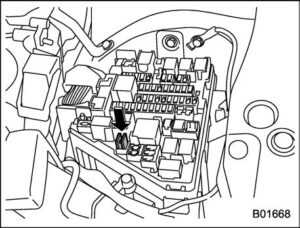
The fuse puller is stored in the main fuse box in the engine compartment. Pinch the upper part of the fuse puller when removing it from the main fuse box.
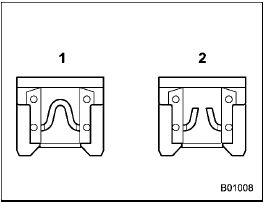
- Good
- Blown
If any lights, accessories or other electrical controls do not operate, inspect the corresponding fuse. If a fuse has blown, replace it.
- Turn the ignition switch to the “LOCK”/ “OFF” position and turn off all electrical accessories.
- Remove the cover.
- Determine which fuse may be blown.
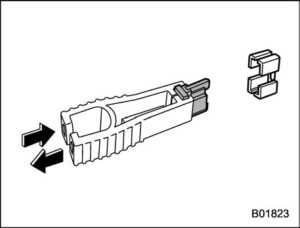 Look at the back side of each fuse box cover.
Look at the back side of each fuse box cover. - Pull out the fuse with the fuse puller.
- Inspect the fuse. If it has blown, replace it with a spare fuse of the same rating.
- If the same fuse blows again, this indicates that its system has a problem. Contact your SUBARU dealer for repairs.
Installation of accessories
Always consult your SUBARU dealer before installing fog lights or any other electrical equipment in your vehicle. Such accessories may cause the electronic system to malfunction if they are incorrectly installed or if they are not suited for the vehicle.
Replacing bulbs
WARNING
Bulbs may become very hot while illuminated. Before replacing bulbs, turn off the lights and wait until the bulbs cool down. Otherwise, there is a risk of sustaining a burn injury.CAUTION
Replace any bulb only with a new bulb of the specified wattage. Using a bulb of different wattage could result in a fire. For the specified wattage of each bulb, refer to “Bulb chart” P 12-9.NOTE
For models with type B combination meter, if SRH is malfunctioning, the SRH OFF indicator light appears on the combination meter when the ignition switch is in the “ON” position. It indicates that SRH has been deactivated. Contact a SUBARU dealer for an inspection.Headlights (models with LED headlights)

LED headlight warning light (type B)
The LED headlight warning light illuminates if the LED headlights malfunction. Have your vehicle inspected at a SUBARU dealer as soon as possible.Headlights (models with halogen headlights)
CAUTION
Halogen headlight bulbs become very hot while in use. If you touch the bulb surface with bare hands or greasy gloves, fingerprints or grease on the bulb surface will develop into hot spots, causing the bulb to break. If there are fingerprints or grease on the bulb surface, wipe them away with a soft cloth moistened with alcohol.NOTE
- If headlight aiming is required, consult your SUBARU dealer for proper adjustment of the headlight aim.
- It may be difficult to replace the bulbs. Have the bulbs replaced by your SUBARU dealer if necessary?
Perform the following steps to replace the bulbs.
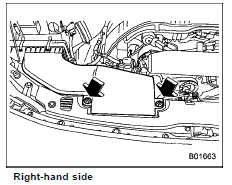
- Use a screwdriver to undo the clips on the air intake duct, then remove the air intake duct.
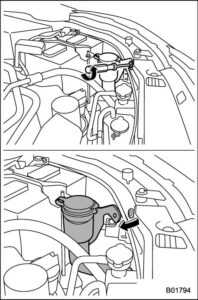 Left-hand side
Left-hand side - Use a screwdriver to remove the secured clip of the washer tank. To make it easy to access the bulb, turn the neck of the washer fluid filler pipe as illustrated.
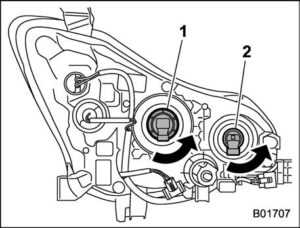
- Low beam bulb
- High beam bulb
- Disconnect the electrical connector from the bulb and remove the bulb from the headlight assembly by turning it counterclockwise.
- Replace the bulb with new one. At this time, use care not to touch the bulb surface.
- To install the bulb to the headlight assembly, turn it clockwise until it clicks.
- Reconnect the electrical connector.
- Install the air intake duct with clips (right-hand side).
- Set the washer fluid filler pipe to the original place and secure it by clip (left-hand side).
-
Subaru Impreza 2023 Replace battery and Specifications Base Sedan User Guide
- https://autouserguide.com/subaru/impreza/subaru-impreza-2023-replace-battery-and-specifications-base-sedan-user-guide/
-
Replacing key battery
The access key fob/transmitter battery may be discharged under the following conditions.
- The operation of the keyless access function is unstable.
- The operating distance of the remote keyless entry system is unstable.
- The transmitter does not operate properly when used within the standard distance.
Replace the battery with a new one.
Safety precautions
CAUTION
- Do not let dust, oil or water get on or in the access key fob/transmitter when replacing the battery.
- Before replacing the battery, remove any static electricity.
- Be careful not to touch or damage the printed circuit board in the access key fob/transmitter when replacing the battery.
- Be careful not to allow children to touch the battery and any removed parts; children could swallow them.
- There is a danger of an explosion if the battery is incorrectly replaced. Replace only with the same or equivalent type of battery.
- Batteries should not be exposed to excessive heat such as bright sunlight, fire or the like.
NOTE
- Replace only with the same or equivalent type of battery recommended by the manufacturer.
- Dispose of used batteries according to local laws.
- Mount the battery in the correct orientation to prevent fluid leakage. Be careful not to bend the terminals. It may result in a malfunction.
- It is recommended that the battery be replaced by a SUBARU dealer.
- Use a new battery.
- After replacing the battery, confirm that the transmitter functions properly.
Replacing the battery of the access key fob
CAUTION
When removing or reinstalling the access key fob cover, make sure that the plastic part does not come off or become misaligned.Battery: Button battery CR2032 or equivalent

- Release button
- Emergency key
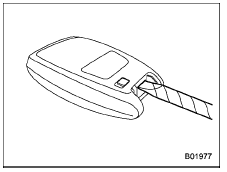
- Take out the emergency key.
- Wrap a flat-head screwdriver with vinyl tape or a cloth, and insert it in the gap to remove the cover.
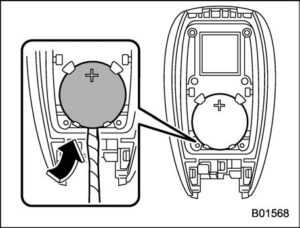
- Take out the battery using a flat-head screwdriver with vinyl tape or a cloth.
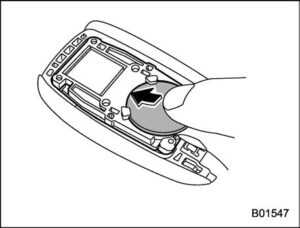
- Insert a new battery with its positive (+) side facing upward as shown in the figure.
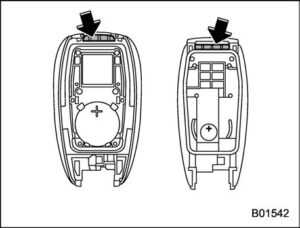
- Attach the cover to the access key fob by fitting the projections and recesses together.
Replacing transmitter battery
Battery: Button battery CR1620 or equivalent
- Wrap a flat-head screwdriver with vinyl tape or a cloth. Open the key head using a flat-head screwdriver.
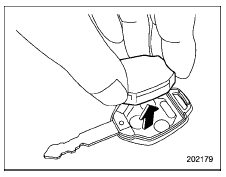
- Remove the transmitter case from the key head.
- Open the transmitter case by releasing the hooks.
- Negative (−) side facing up
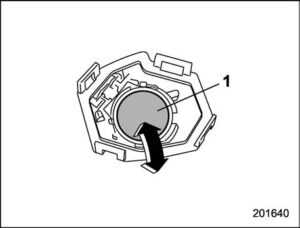
- Negative (−) side facing up
- Replace the old battery with a new battery making sure to install the new battery with the negative (−) side facing up.
- Put together the transmitter case by fitting the hooks on the case.
- Reinstall the transmitter case in the key head.
- Refit the removed half of the key head.
Specifications
These specifications are subject to change without notice.
Dimensions
Item Forester Subaru Forester Wilderness Overall length 182.7 (4,640) Overall width 71.5 (1,815) 72.2 (1,835) Overall height 68.1 (1,730)*2 67.5 (1,715)*3
68.9 (1,750) Wheel base 105.1 (2,670) 104.9 (2,665) Tread Front 61.6 (1,565) 61.4 (1,560) Rear 61.8 (1,570) 61.4 (1,560) Ground clearance*1 8.7 (220) 9.3 (235) - Read all Instructions for Replace battery and Specifications Base Sedan User Guide
-
Subaru Impreza 2023 Tire Information Base Sedan User Guide
- https://autouserguide.com/subaru/impreza/subaru-impreza-2023-tire-information-base-sedan-user-guide/
-
Tire information
Tire labeling
Many markings (e.g. Tire size, Tire Identification Number or TIN) are placed on the sidewall of a tire by tire manufacturers. These markings can provide you with useful information on the tire.Tire size
Your vehicle comes equipped with a P-Metric tire size. It is important to understand the sizing system in selecting the proper tire for your vehicles. Here is a brief review of the tire sizing system with a breakdown of its individual elements.P Metric
With the P-Metric system, Section Width is measured in millimeters. To convert millimeters into inches, divide by 25.4. The Aspect Ratio (Section Height divided by Section Width) helps provide more dimensional information about the tire size.Example:

- Certain tire type used on light duty vehicles such as passenger cars
- Section Width in millimeters
- Aspect Ratio (= section height 7 section width).
- R = Radial Construction
- Rim diameter in inches Load and Speed Rating Descriptions
The load and speed rating descriptions will appear following the size designation. They provide two important facts about the tire. First, the number designation is its load index. Second, the letter designation indicates the tire’s speed rating.
Example

- Load Index: A numerical code that specifies the maximum load a tire can carry at indicated by its speed symbol, at maximum inflation pressure.
For example, “90” means 1,323 lbs (600 kg), and “89” means 1,278 lbs (580 kg).
WARNING
Load indices apply only to the tire, not to the vehicle. Putting a load-rated tire on any vehicle does not mean the vehicle can be loaded up to the tire’s rated load. - Speed Rating: An alphabetical system describing a tire’s capability to travel at established and predetermined speeds. For example, “V” means 149 mph (240 km/h)
WARNING
- Speed ratings apply only to the tire, not to the vehicle. Putting a speed-rated tire on any vehicle does not mean the vehicle can be operated at the tire’s rated speed.
- The speed rating is void if the tires are worn out, damaged, repaired, retreaded, or otherwise altered from their original condition. If tires are repaired, retreaded, or otherwise altered, they may not be suitable for original equipment tire-designed loads and speeds.
Tire Identification Number (TIN)
Tire Identification Number (TIN) is marked on the intended outboard sidewall. Here is a brief review of the TIN with a breakdown of its individual elements.

- DOT symbol
- Manufacturer’s Identification Mark
- Tire Size Code
- Tire Type Code
- Date of Manufacture The first two figures identify the week, starting with “01” to represent the first full week of the calendar year; the second two figures represent the year. For example, 0101 means the 1st week of 2001.
- The DOT symbol certifies that the tire conforms to applicable Federal Motor Vehicle Safety Standards.

- DOT symbol
- Plant Code
- Manufacturer’s Code
- Date of Manufacture The first two figures identify the week, starting with “01” to represent the first full week of the calendar year; the second two figures represent the year. For example, 0101 means the 1st week of 2001.
- The DOT symbol certifies that the tire conforms to applicable Federal Motor Vehicle Safety Standards.
Other markings
The following makings are also placed on the sidewall. Maximum permissible inflation pressure
The maximum cold inflation pressure to which this tire may be inflated. For example, “300 kPa (44 PSI) MAX. PRESS”Maximum load rating
The load rating at the maximum permissible weight load for this tire. For example, “MAX. LOAD 580 kg (1279 LBS) @ 300 kPa (44 PSI) MAX. PRESS.”
WARNING
Maximum load rating applies only to the tire, not to the vehicle. Putting a load-rated tire on any vehicle does not mean the vehicle can be loaded up to the tire’s rated load.Construction type
Applicable construction of this tire. For example, “TUBELESS STEEL BELTED RADIAL” Construction
The generic name of each cord material used in the plies (both sidewall and tread area) of this tire. For example, “PLIES: TREAD 2 STEEL + 2 POLYESTER SIDEWALL 2 POLYESTER”Construction
The generic name of each cord material used in the plies (both sidewall and tread area) of this tire. For example, “PLIES: TREAD 2 STEEL + 2 POLYESTER SIDEWALL 2 POLYESTER”
Many markings (e.g. Tire size, Tire Identification Number or TIN) are placed on the sidewall of a tire by tire manufacturers. These markings can provide you with useful information on the tire. Your vehicle comes equipped with a P-Metric tire size. It is important to understand the sizing system in selecting the proper tire for your vehicles. Here is a brief review of the tire sizing system with a breakdown of its individual elements.
- Read all Instructions for Tire Information Base Sedan User Guide
-
Subaru Impreza 2023 Uniform Tire Quality Base Sedan User Guide
- https://autouserguide.com/subaru/impreza/subaru-impreza-2023-uniform-tire-quality-base-sedan-user-guide/
-
Uniform Tire Quality Grading (UTQG)
For details, refer to “Uniform tire quality grading standards” �P520.
Recommended tire inflation pressure
For recommended cold tire inflation pressure for your vehicle’s tires, refer to “Tires” �P498. 510 Tire information
Vehicle placard
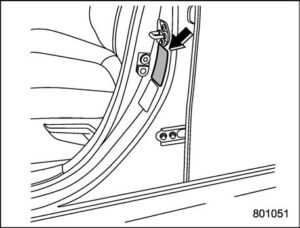
The vehicle placard is attached to the driver’s side door pillar.
Example:
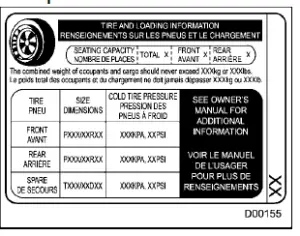
The vehicle placard shows original tire size, recommended cold tire inflation pressure on each tire at maximum loaded vehicle weight, seating capacity and loading information
Adverse safety consequences of underinflation
Driving at high speeds with excessively low tire pressures can cause the tires to flex severely and to rapidly become hot. A sharp in-crease in temperature could cause tread separation, and failure of the tire(s). Possible resulting loss of vehicle control could lead to an accident.
Measuring and adjusting air pressure to achieve proper inflation
Check and, if necessary, adjust the pressure of each tire (including the spare) at least once a month and before any long journey. Check the tire pressures when the tires are cold. Use a pressure gauge to adjust the tire pressures to the specific values. Driving even a short distance warms up the tires and increases the tire pressures. Also, the tire pressures are affected by the outside temperature. It is best to check tire pressure outdoors before driving the vehicle. When a tire becomes warm, the air inside it expands, causing the tire pressure to increase. Be careful not to mistakenly release air from a warm tire to reduce its pressure.
Glossary of tire terminology
Accessory weight
The combined weight (in excess of those standard items which may be replaced) of automatic transmis-sion, power steering, power brakes, power windows, power seats, radio, and heater, to the extent that these items are available as factory-in-stalled equipment (whether in-stalled or not).Bead
The part of the tire that is made of512 Tire information steel wires, wrapped or reinforced by ply cords and that is shaped to fit the rim.- Bead separation A breakdown of the bond between components in the bead.
- Bias ply tire A pneumatic tire in which the ply cords that extend to the beads are laid at alternate angles substantially less than 90 degrees to the center-line of the tread.
- Carcass The tire structure, except tread and sidewall rubber which, when inflated, bears the load.
- Chunking
The breaking away of pieces of the tread or sidewall. - Cold tire pressure
The pressure in a tire that has been driven less than 1 mile or has been standing for three hours or more. . Cord - The strands forming the plies in the tire.
Cord separation
The parting of cords from adjacent rubber compounds.- Cracking
Any parting within the tread, side wall, or inner liner of the tire extending to cord material. - Curb weight
The weight of a motor vehicle with standard equipment including the maximum capacity of fuel, oil and coolant, and if so equipped, air conditioning and additional weight optional engine. - Extra load tire
A tire designed to operate at higher loads and higher inflation pressure than the corresponding standard tire. - Groove
The space between two adjacent tread ribs. - Inner liner
The layer(s) forming the inside sur-face of a tubeless tire that contains the inflating medium within the tire. - Inner liner separation
The parting of the inner liner from cord material in the carcass. - Intended outboard sidewall
The sidewall that contains a whitewall, bears white lettering or bears manufacturer, brand, and/or model name molding that is higher or deeper than the same molding on the other sidewall of the tire, or The outward facing sidewall of an asymmetrical tire that has a particular side that must always face outward when mounting on a vehicle. - Light truck (LT) tire
A tire designated by its manufacturer as primarily intended for use on lightweight trucks or multipurpose passenger vehicles. - Load rating
The maximum load that a tire is rated to carry for a given inflation pressure. - Maximum inflation pressure
The maximum cold inflation pressure to which a tire may be inflated. - Maximum load rating
The load rating for a tire at the maximum permissible inflation pressure for that tire.
The sum of
- Curb weight
- Accessory weight
- Vehicle capacity weight
- Production options weight
- Maximum permissible inflation pressure
The maximum cold inflation pressure to which a tire may be inflated. - Measuring rim
The rim on which a tire is fitted for physical dimension requirements. - Normal occupant weight
150 lbs (68 kg) times the number of occupants specified in the second column of Table 1 is appended to the end of this section. Occupant distribution Distribution of occupants in a vehicle as specified in the third column of Table 1 is appended to the end of this section. - Open splice
Any parting at any junction of tread, sidewall, or inner liner that extends to cord material. - Outer diameter
The overall diameter of an inflated new tire. - Overall width
The linear distance between the exteriors of the sidewalls of an inflated tire, including elevations due to labeling, decorations, or protective bands or ribs. - Passenger car tire
A tire intended for use on passenger cars, multipurpose passenger vehicles, and trucks, that have a gross vehicle weight rating (GVWR) of 10,000 lbs (4,535 kg) or less. - Ply A layer of rubber-coated parallel cords.
- Ply separation
A parting of rubber compound between adjacent plies. - Pneumatic tire
A mechanical device made of rubber, chemicals, fabric, steel, or other materials, that, when mounted on an automotive wheel, provides traction and contains the gas or fluid that sustains the load. - Production options weight The combined weight of those installed regular production options weighing over 5.1 lbs (2.3 kg) in excess of those standard items which they replace, not previously considered in curb weight or accessory weight, including heavy duty brakes, ride levelers, roof rack, heavy-duty battery, and special trim.
- Radial ply tire
A pneumatic tire in which the ply cords that extend to the beads are laid at substantially 90 degrees to the centerline of the tread. - Recommended inflation pressure
The cold inflation pressure is recommended. - 514 Tire information
mended by a vehicle manufacturer. - Reinforced tire
A tire is designed to operate at higher loads and at higher inflation pressures than the corresponding standard tire.
- Read all Instructions for Uniform Tire Quality Base Sedan User Guide
Reference Links
Download Manuals: https://www.subaru.com/owners/vehicle-resources/manuals.html
Subaru 2023 Top Accessories
[amalinkspro_table id=”32446″ new-window=”on” nofollow=”on” addtocart=”off” /]

